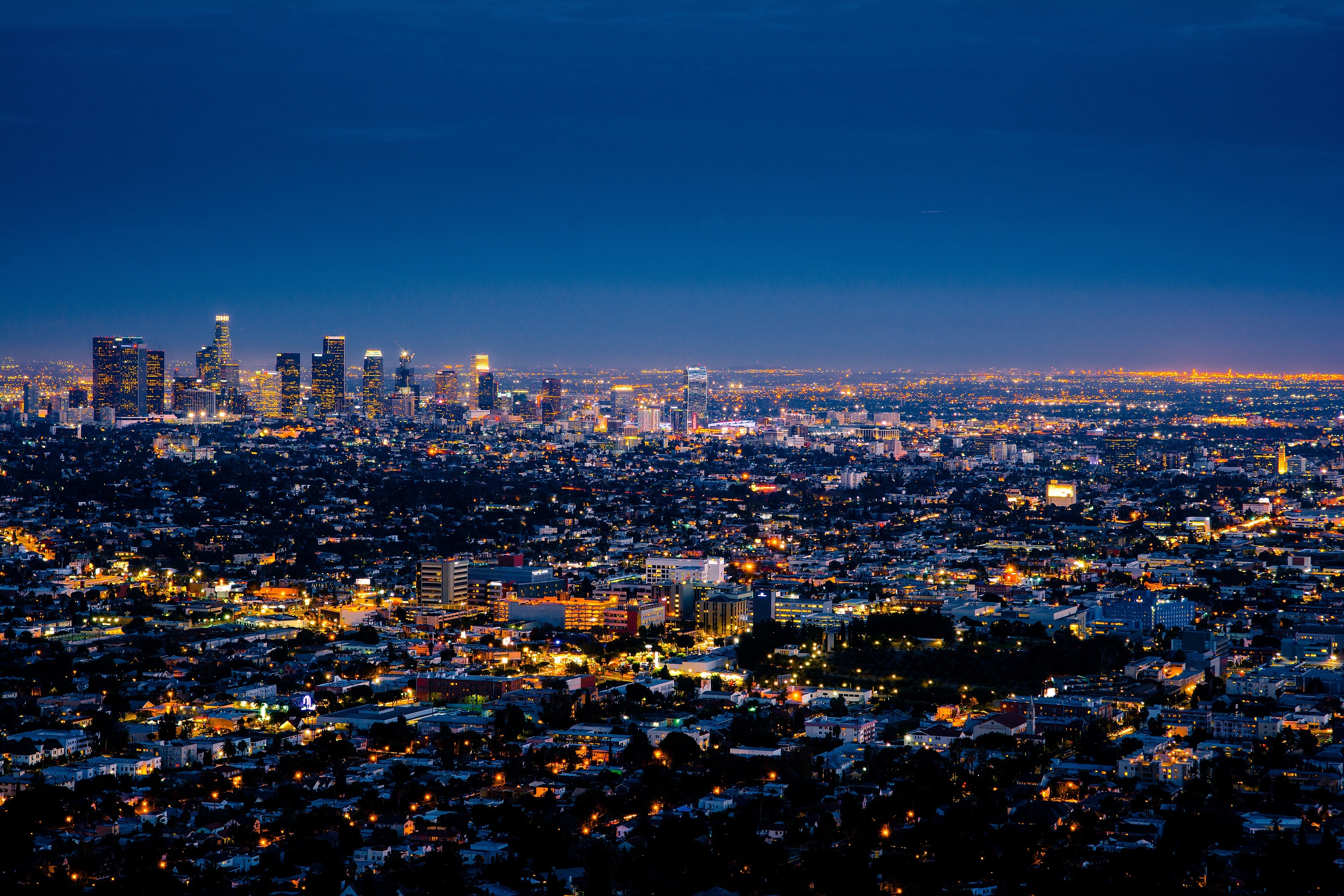How the pandemic has changed the way I plan trips
After a tough couple of years, it really is starting to look more positive for travel. By making such a statement I hope I haven’t jinxed my upcoming trips, but my inbox is now full of optimistic predictions which have replaced desperate pleas imploring me to “dream now, book later”. I’ve travelled as much as I can internationally since March 2020. At times, that was anxiety-inducing. Would governments hold their nerve and keep the borders open? Would I test positive and throw the whole trip off? Would it feel safe and sensible to travel at all? To keep travelling, I’ve had to change the way I plan trips. If you’re still a little unsure about whether to take the plunge again, here are a few things I’ve learnt along the way.
Embrace independent travel

COVID is the viral equivalent of a shapeshifter and has been a constant headache for my travel plans. Back when I was a teacher tied to school holidays, I would think nothing of booking a scheduled flight 11 months ahead of departure to lock in a decent price. Now, I think that would be foolish, partly because flight schedules are changing so frequently and partly because it only takes one vaccine-resistant variant to throw the whole world into disarray. You only have to look at government actions regarding Omicron to see this in action. But I’ve never been a big fan of package tours. They often unfairly penalise solos and regardless, I prefer to be the one in charge of my travel decision-making. So how does that affect me as an independent traveller? Short answer: not much. In fact, being able to decide whether it feels right to travel without having to convince anyone else is a bonus right now.
Ditch the idea of planning too far in advance

How far in advance is too far? I guess the answer to that one is, How long is a piece of string? In summer 2020, I had an Iceland trip all ready to go and then regulations changed. To avoid a five day quarantine, I ended up bringing the trip forward by a month and replanning everything in the space of a day and a half. At one point during that fraught weekend, I wondered if I should go at all. I did and it was one of the best holidays I have ever had. Empty roads, cheap accommodation and those incredible landscapes almost to myself in such gloriously sunny weather I wondered whether this could be Iceland at all. That was the first post-pandemic trip I made, and it felt like a weight had been lifted.
Accept that things might change

Since then, in addition to some remarkable trips within the UK, I’ve flown out to Madeira, Iceland again, Germany and Austria, Menorca, Sweden and the USA a week after it finally reopened its borders to leisure travellers. Right now, I have international bookings lined up for the USA in March and France in April. I’m looking at adding the Azores and Uzbekistan to that list for later in the year. On my bookshelf are guidebooks to Rwanda, Madagascar and Benin ready for some point in the future. But things change. Pre-pandemic, I thrived on visiting off the beaten track places in unusual destinations. I miss that, but if I’m honest, I’m still unsure about travelling to parts of the world where healthcare provision is patchy and where access can be a challenge. I don’t want to get stranded somewhere. Actually, I don’t want to get stranded anywhere.
Check the regulations with a reliable source

Even though I’m now sufficiently convinced that booking a month or two in advance isn’t a big risk to my finances, there are still a few considerations that are influencing my choice of destination. I’m happy to test in advance. I figure if the result is positive, that still leaves me time to cancel or preferably reschedule my bookings and I’m unlikely to be out of pocket. Testing on arrival, which to be fair I was OK with on that first trip to Iceland, now seems risky, given how much more spreadable variants such as Delta and Omicron proved to be. I’m fully vaccinated and boostered, but though that’s likely to prevent me becoming seriously ill, I can still catch it. I don’t want to test positive the minute I step off the plane and risk that massive disappointment. Similarly, nowadays, anywhere with a quarantine in place is a no for me, for example, as that might imply high case numbers. I use the FCDO’s travel advice pages in conjunction with other official government sites and tourist board socials to get as full a picture as I can of the current situation before settling on a destination.
Keep flights flexible
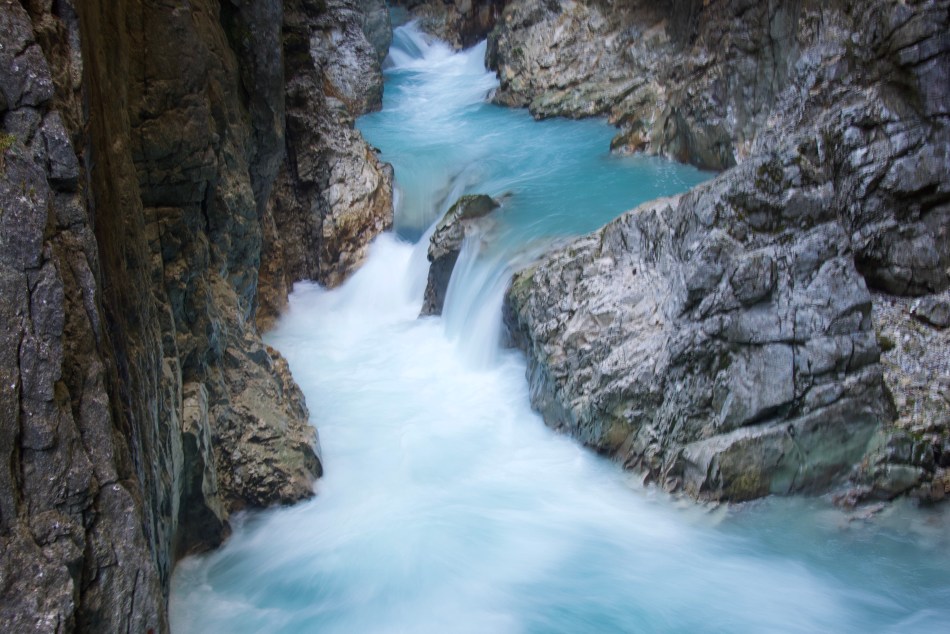
I’ve always planned trips to be flexible to some degree, but that’s even more the case now. I’ve tried to choose flights with airlines that permit date changes. Over the past couple of years that’s been BA, easyJet and Virgin Atlantic but policies change so double check the small print if you plan to fly with them. Ryanair didn’t offer the same flexibility when it came to planning my Stockholm trip last December but they were so much cheaper and more convenient than other airlines I figured I’d risk it and write off the cost of the flight if I had to. I didn’t, by the way, and the trip went off as planned. Another thing I’m trying to do at the moment is stick to direct flights, which reduces the chance of something changing at the layover destination and preventing inward or onward travel.
Make the most of free cancellation policies

I often use booking.com to source accommodation – just a personal preference rather than a travel writer perk – and they offer to book on a free cancellation basis which has been a real help. You do need to check the dates, however. Some properties offer free cancellation as late as 6pm on the day of arrival whereas others require you to lock in your reservation as much as a week or more in advance – which might be fine for a hotel you’re planning to use later in the trip but not the one you plan to stay in when you first arrive. Where possible, if I have to cancel, I do so as far in advance as I can; more often, I try to move the reservation to alternative dates. I mark crucial dates in my diary, usually a reminder 24 hours before the cancellation might need to be made and double check the situation once more before embarking on the trip.
Manage your risk

Travel insurance has never been more necessary, I’d argue, but read the policy document carefully to see exactly what you are covered for. It’s wise to have decent medical cover and provision for unforeseen expenses should you need to stay longer than planned. Take a close look at those exclusions for cancellations to see if COVID is one of them. You don’t really know if an insurance provider is any good until you need to make a claim, but it’s worth reading their reviews and ratings to see if they help you make a decision on which to use.
Everyone’s different and for some people, it’s still to early to consider travelling beyond their own border. I respect that, though it’s not for me. As visitor numbers haven’t yet fully recovered to 2019 levels, it’s still a great time to see the world, especially those places that typically have attracted large numbers of tourists. Wherever 2022 takes you, happy travels and follow your dreams.
Ticket to Ryde: a dog-friendly holiday on the Isle of Wight
It became a familiar conversation. We’d returned to the Isle of Wight after decades – my last holiday there was in 1979 and my husband’s a few years before that. It would seem the pandemic had given many of us the same idea: hop on a ferry and holiday on the island that had been a childhood favourite. And judging from the people we spoke to, we were all up for a bit of nostalgic sightseeing. But what’s it like now and most importantly since we had Edison in tow, how dog-friendly is it?
Dog-friendly attractions
Carisbrooke Castle
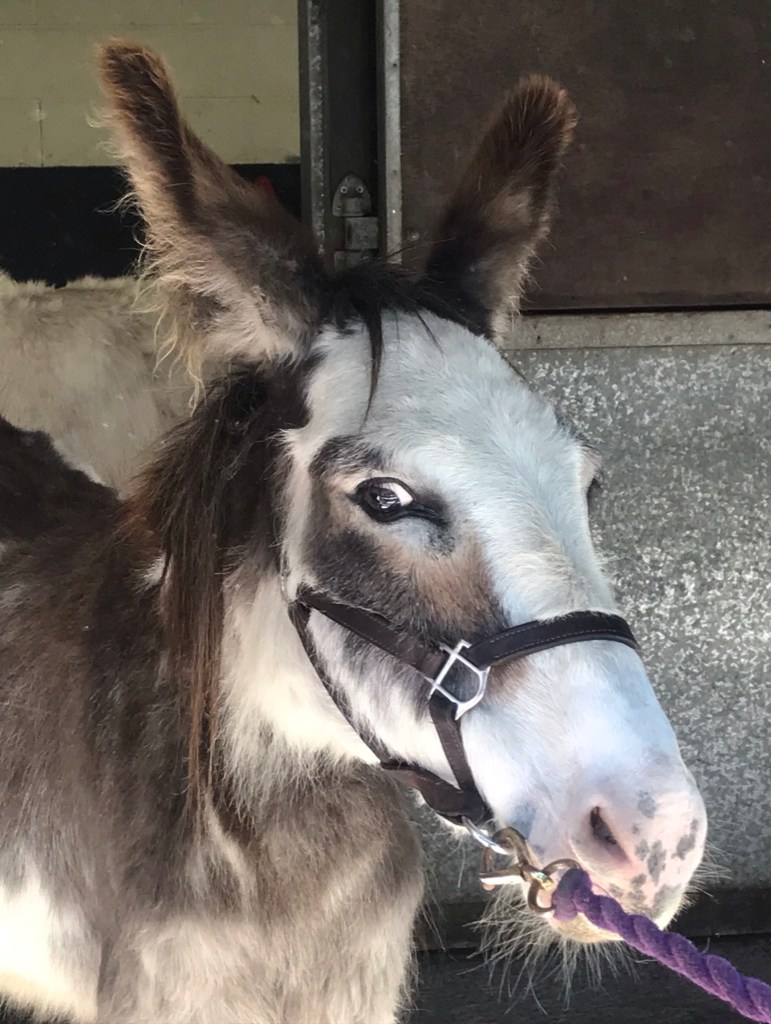
Aside from the museum, dogs are welcome across the Carisbrooke Castle site. As with most English Heritage properties, you need to book in advance, but availability was good. We chose to get there when it opened, largely because hot weather was forecast, but actually it only started to get busy around lunchtime. Edison walked the walls with us, though the steps down from the keep were very steep. If he’d been smaller, we might have been tempted to carry him, but instead we were forced to resort to bribes to get him down. Also, he wasn’t too sure about the castle’s famous donkeys, so we made sure he gave them a wide berth – though I couldn’t resist a fuss. Due to social distancing restrictions they aren’t demonstrating the donkeys using the water wheel at present but you can still take a look inside the wheel house.
Shanklin Chine
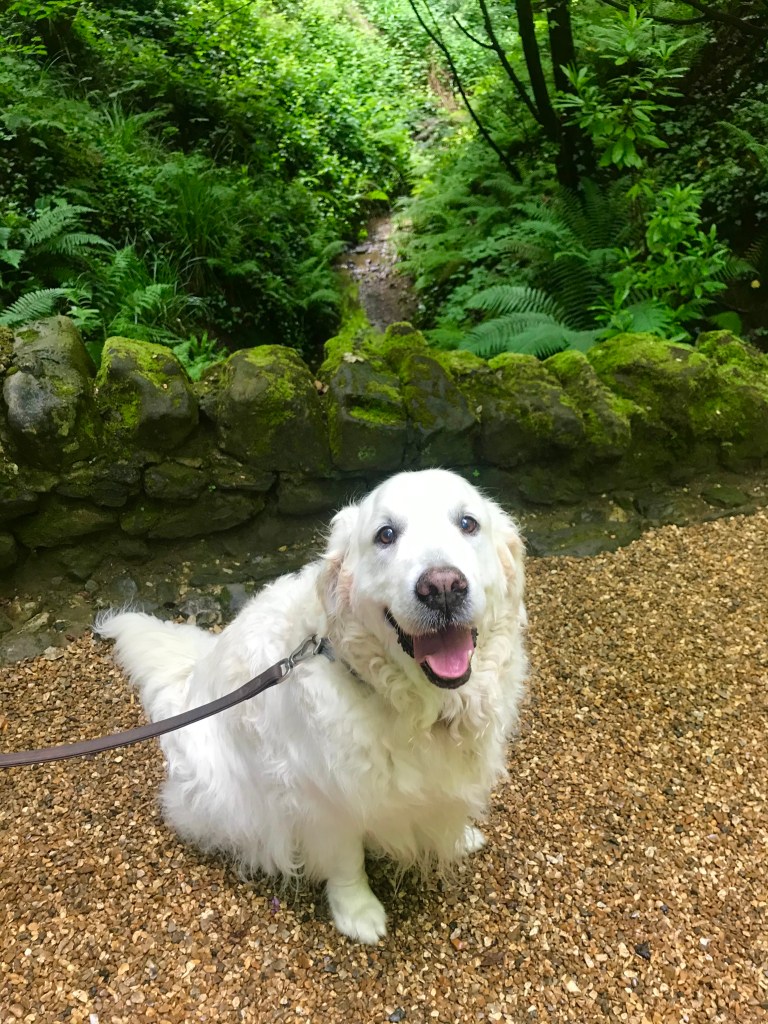
The term chine is used on the Isle of Wight to refer to a steep, narrow ravine where a river has cut its way down to the sea. Blackgang Chine used to be the largest until a landslip put paid to that; it’s still there and those dinosaurs you might remember are too. But we picked Shanklin Chine instead, which is now the largest. A stepped path leads down beside a waterfall and stream. There’s plenty of trees and shrubs to provide shade, including pretty rhododendrons, dainty ferns and some magnificent gunneras which have grown to giant proportions. On a hot day this was a lovely walk. There are glorious views out over the sea and close to the heritage centre, a cafe serving cream teas where dogs are welcome.
Osborne House

Osborne House itself is off-limits to dogs but that shouldn’t stop you from visiting. If there are two of you, take turns to tour inside and admire the lavish interiors of what was Queen Victoria’s summer palace. Dogs are welcome to explore the grounds – Edison enjoyed plenty of fuss from the gardeners tending the roses. There’s a 1.2km long tree-lined path which leads to the water where you’ll find an old fashioned bathing machine beside the cafe. From there, another ten minutes walk past gorgeous purple rhododendrons gets you to Swiss Cottage, an Alpine-style chalet built for the Royal children. It started to rain just as we were leaving to walk back to the main house. Fortunately, there’s a free minibus to shuttle visitors about and the driver was very keen to have Edison on board even though he was a little damp.
Alum Bay and the Needles

The Needles are the iconic image associated with the island and a must-see. Parking costs a hefty £6 for the day with no short term options available, but you can reach it on one of the two open-top Breezer bus routes. Two dogs are permitted per bus according to the terms and conditions, though we had the car so can’t verify this. You can see the Needles from the car park or walk to the Battery for a closer look. From Alum Bay beach, there are boat trips which head out for a closer look; dogs are permitted. We stuck to the beach itself where dogs are allowed so long as they stay on the lead – pack an extendable or long lead so they can go further out if you don’t fancy going in too. No dogs are permitted on the chair lift, so to see the famous coloured sands you’ll need to take the steps.
Isle of Wight Steam Railway
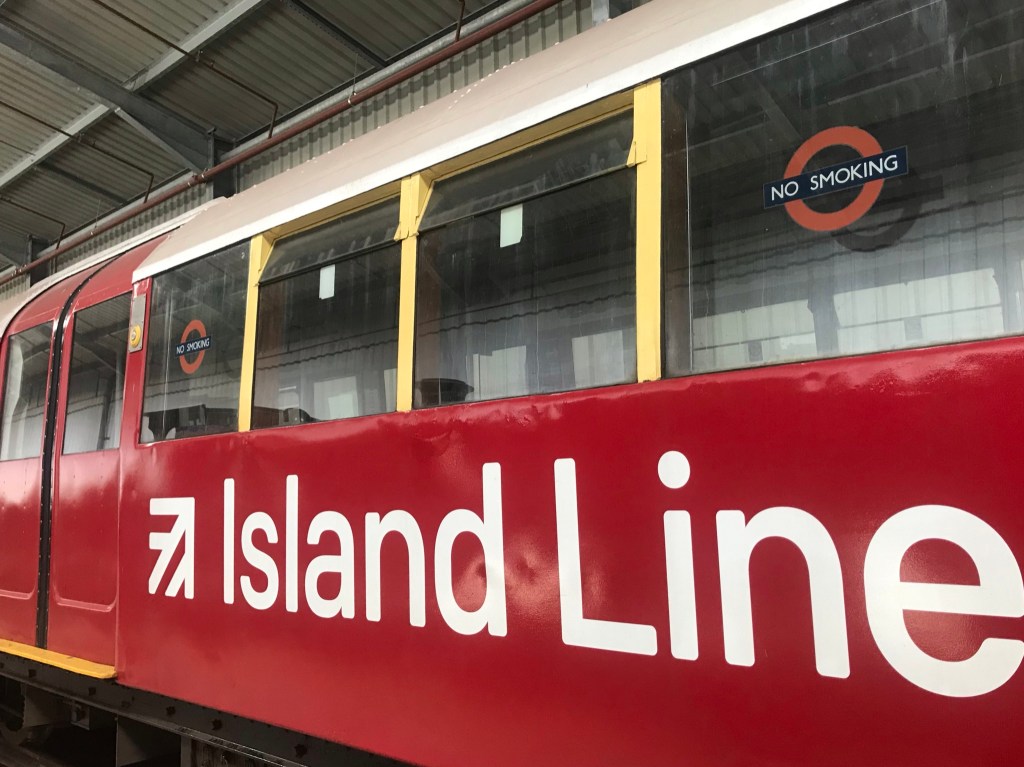
Steam railways are almost always dog-friendly and this one is no exception. Start your journey at Havenstreet, but get there well ahead of your departure time as there’s a superb museum to explore. Dogs are permitted inside and on the accessible carriages. The museum has some really old rolling stock which has been painstakingly restored, and there’s also a more recent addition – the newly retired carriages that once saw service on the London Underground before becoming the Island Line. The train ride is slow but very relaxing as it passes through unspoilt countryside. It’s especially dog-friendly at present as COVID restrictions mean households get a compartment to themselves – ideal if you have a nervous dog or don’t relish the embarrassment of a barking match. We travelled first class, which was perfect for us, but carpeted – apologies to the person who had to vacuum all that dog fur and sand after we got off.
The beaches
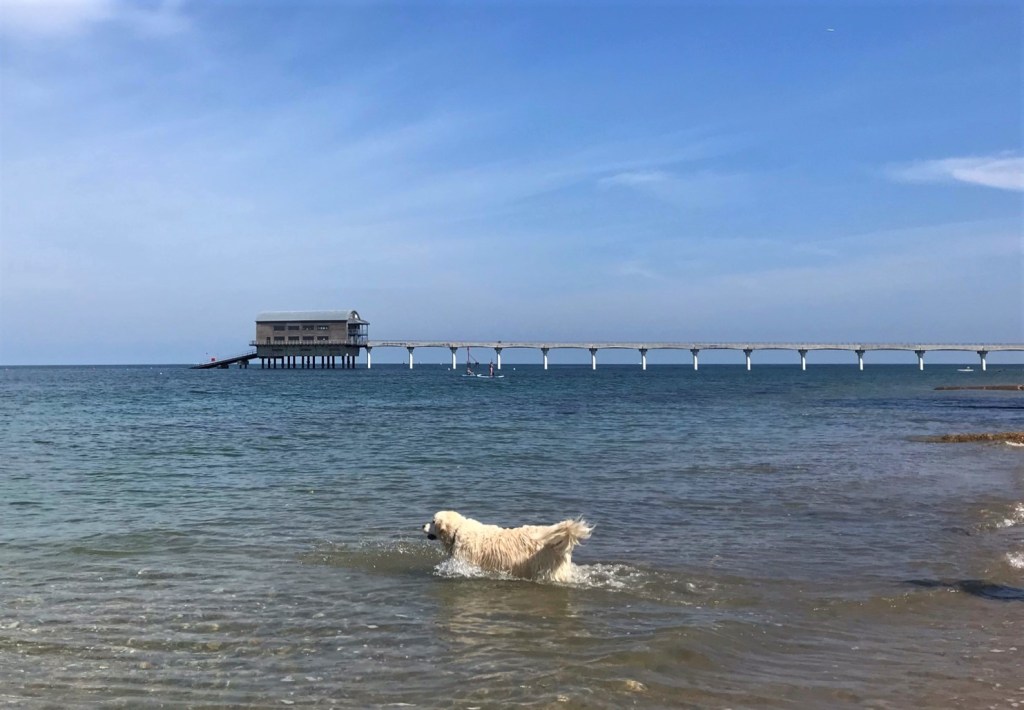
Many of the Isle of Wight’s beaches are dog-friendly year round. One of the best is Yaverland Beach, located just east of the resort of Sandown. At low tide, it’s a huge stretch of sand, so there’s plenty of room to roam – take a ball. As it is backed by cliffs you won’t have to worry about your dog running onto the road. We also liked the beach at Bembridge, close to the lifeboat station. We chose to go at high tide; there wasn’t much beach left but the beach shelves quite steeply so it’s ideal for your dog to swim yet still be close to shore. Another great choice is the walk to Steephill Cove from Ventnor. Park up at La Falaise car park and stroll along the cliff path. It’s steep in places but there are steps. Steephill Cove is privately owned, so it’s dogs on leads until 6pm, but visit the crab shack (closed Mondays and Tuesdays) and you and your pooch can share a delicious crab pasty on the beach.
Getting there
You’ll need to book a ferry or hovercraft if you’re travelling with your dog. We opted for the former as we wanted the convenience of having a car with us, but if you wanted to do a day trip the crossing is just ten minutes. We looked at both Red Funnel and Wightlink ferries. The former links Southampton to East Cowes and the latter crosses from Portsmouth to Fishbourne as well as Lymington to Yarmouth. prices were comparable so we chose the Fishbourne route. We travelled out on Victoria of Wight which had a large, dog-friendly deck as well as interior space. It was on time and a good experience.

A word of caution
Unfortunately, the same couldn’t be said for the return booking. We’d chosen a sociable 10.40am crossing on the St Clare, but the Victoria of Wight suffered an engine problem two days before we were due to sail. Our crossing – on the unaffected ferry, remember – was bumped to 00.40am with no option to change online. (The text and email we were sent said we could, but our booking had been checked in without our consent making that impossible. I tried calling but it was impossible to get through. Rather than drive through the night to get home and with heavy rain forecast all day (no fun with limited indoor options thanks to the dog), we paid an additional £67 for an 8.40pm booking the day before – ironically also on the St Clare. It wasn’t the best end to a holiday and I shall be making a complaint to Wightlink about it.
Where we stayed
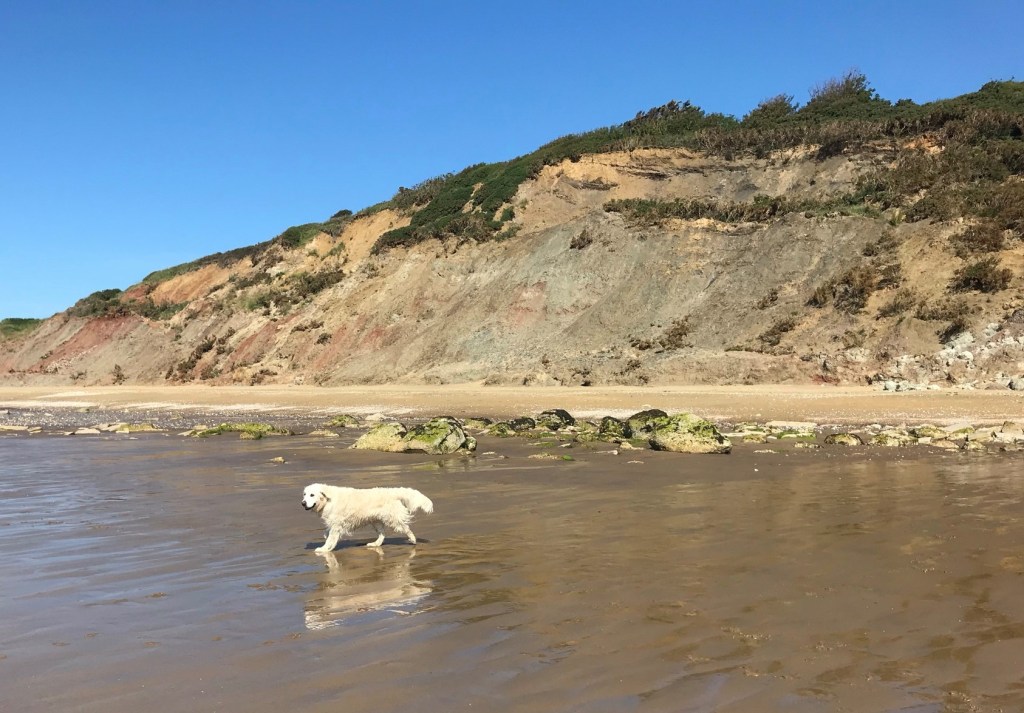
There’s a great deal of dog-friendly accommodation on the island but we were very happy with our choice. Fort Spinney bungalows are located across the road from Yaverland Beach and have off-road parking. They were tastefully renovated in 2020 and represent excellent value for money. We opted for a two-bedroom bungalow sleeping four people which cost us £110 per night in June. It had a spacious living room, spotlessly clean bathroom and well-equipped kitchen with fridge, freezer and washing machine Although we’d liked to have had a coffee machine, the kiosk across the road served good coffee.
Best of all with a dog in tow was the enclosed private garden which was ideal for sitting safely with Edison who found himself a shady nook to stretch out in when we returned home each day. Bungalows 3, 4 and 5 (of ten) are dog-friendly; 5 is tucked away in the corner with only one attached wall. Edison’s not too fond of noise these days as we live in such a quiet village, but the bungalow was well insulated and he only kicked off when a cat had the audacity to come into “his” garden.
The verdict
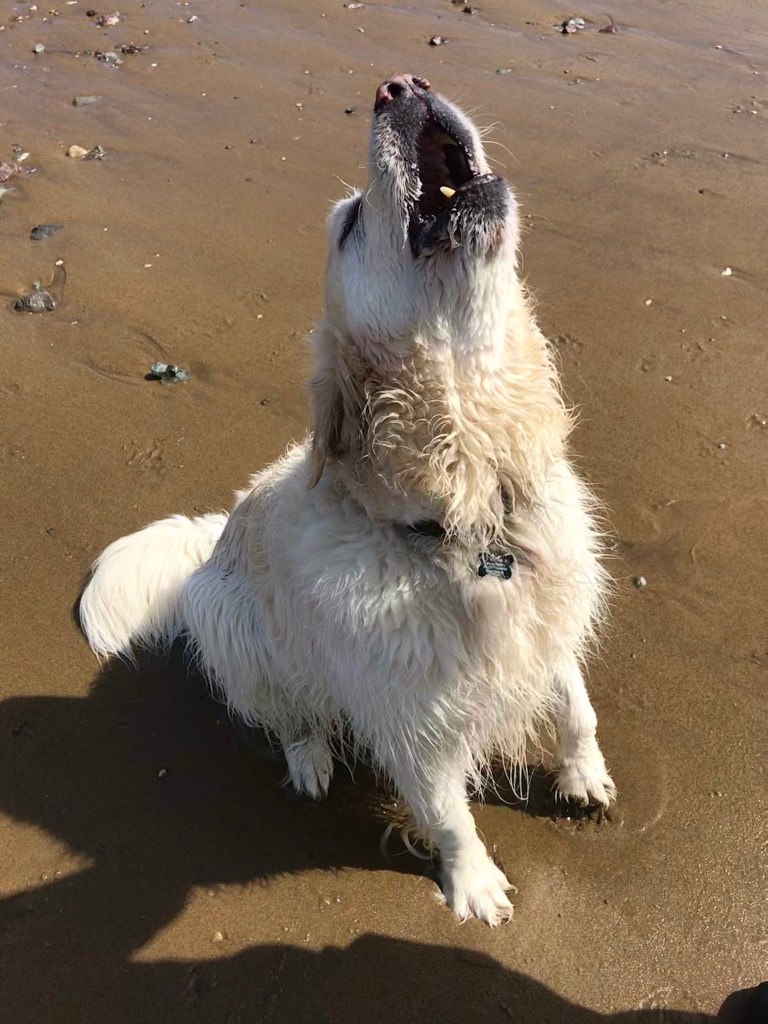
The island is really dog-friendly and there is a whole lot more to do and see than we experienced during our six day stay. I’d definitely stay at Fort Spinney again too. All in all, it was a fabulous week, although the ferry issues were a reminder that you have limited options if you are stuck on an island when things don’t go according to plan.
Why I’m still not booked up for summer
I’ve never found it harder to resist booking a trip than over the last few days. The UK vaccine rollout continues apace; I’m finally old enough to be booked in and if all goes according to plan, I will be fully protected (as much as any vaccine can do so) by mid-June. Of course currently, international leisure travel is banned here in the UK, but each day, my social media feeds and inbox bring news of more countries that will permit entry for vaccinated travellers without the need for quarantine. Everyone, it seems, is competing to have us back. So why haven’t I booked?
Quarantine uncertainty
One thing I learnt last year was that predicting what the situation with travel will be in the weeks and months ahead is fraught with uncertainty. After the Icelandic government altered their quarantine arrangements, I had to reschedule my trip in a hurry, dropping everything to leave almost a month ahead of my planned departure date.

The information about current entry requirements is fairly easy to obtain – my go-to is the FCDO travel advice which is a UK government site updated regularly. From this, I have a tentative shortlist of countries to which I might travel later in 2021. But as coronavirus case numbers change, so too can national policies. In other words, just because somewhere is saying they’re welcoming us now doesn’t mean their borders will still be open in the summer.
Inbound quarantine restrictions are also a factor. The UK government currently have a “red list” of countries which trigger a compulsory inbound quarantine for ten days on arrival in England. Whether that takes place at a hotel or in your own home depends on where you have travelled and the route you take to reach England:
“If you’re travelling to England you must either quarantine in the place you’re staying or in a managed quarantine hotel for 10 days because of coronavirus (COVID-19). What you need to do depends on where you travel in the 10 days before you arrive in England.”
Costs for the managed hotel option are significant and certainly a deterrent- as intended. I’m sure those who have already booked are hopeful, maybe even confident, that their destination won’t appear on the list. At some point, as yet unspecified, this requirement will be lifted, but with case rates still worryingly high in some parts of the world, there are no guarantees.
Testing requirements
The requirement for a PCR test (or two) is an added complication. There’s a lot of variation between countries. Some offer testing on arrival with a requirement to quarantine or at least limit activities until a negative result is received. Others require tests to be carried out in advance, usually within a 72 hour window. A positive result would scupper your holiday at the last minute, as it’s hard to find an insurance policy which would cover cancellation in those circumstances.
Even if it’s negative, it could add a considerable sum to the cost of your holiday. In the UK, such tests should be done privately and are quite expensive. Abroad, the cost of testing varies a lot. Last year, I paid around £50 for two tests in Iceland but nothing for the test on arrival in Madeira. It’s worth doing thorough research in advance to avoid getting a bill you weren’t expecting. Test to release on the inbound leg currently adds another cost.

Vaccine passports
Some countries, tour operators and airlines have indicated they’ll require guests to be fully vaccinated before they are eligible to travel. In some cases, such as Iceland, this removes the need to take a PCR test so long as you carry official proof. Being vaccinated isn’t likely to be a problem for the over 50s, as we’re not permitted to travel internationally until at least May 17th. But younger travellers might need to wait until autumn until they receive that crucial second dose to qualify. Vaccine passports are also probably going to be a requirement, but the precise nature of the document, how to apply and how much it will cost is still being worked out. As with many things during the pandemic, governments are having to play catch up as the situation evolves.
The holiday itself
As numbers continue to spike in countries across the world, quite rightly governments are reacting with local or national lockdowns. When that happens, visitor attractions are an early casualty. Some trips would be worse affected by this than others: the trips I made last year to Iceland and to Madeira largely focused on walking outdoor trails. Aside from dining, much of what I did wouldn’t have been affected by the closure of museums and other indoor attractions.
Hit the jackpot, of course, and you get to experience popular places without the crowds. I visited St Petersburg just before things really kicked off last March and toured its breathtaking palaces with no waiting in line and no jostling to see their exhibits. That was an extraordinarily special thing. But it’s a gamble; if you’ve always wanted to visit a particular attraction but it’s closed, ask yourself whether that would ruin the trip. Had I been in Funchal and missed out on the famous wicker toboggan ride, I’d have been disappointed; thankfully they were able to operate.

The industry perspective
The impact of the global pandemic has been horrendous for tourism-driven companies. Even the most profitable airlines have taken a huge hit and there are no guarantees that routes or even airlines will be around. Make a booking and you do your bit to help to save the industry, but if it all goes belly-up you potentially won’t see your hard-earned cash again. If you do plan to pay upfront, check your insurance policy and make sure you’re happy with the cover it provides.
But many companies are offering flexible bookings, and we know a lot more about who did the right thing in 2020 when it came to refunds thanks to this useful survey by the travel team at Which? If your gamble pays off you can win big. Hotels have slashed their rates, meaning you can enjoy luxury on a modest budget, while outside of peak season, the cheap fares we’ve come to expect from airlines are there for the taking. However, in my experience, last minute flights in 2020 were pretty affordable and accommodation was widely available even on the day, so if you’re not too fussed about where you go and where you stay, there’s an argument for waiting.
But a word of caution: the vaccine rollout might change that for 2021 as costs are always influenced by supply and demand. If more Brits feel confident to travel abroad this summer, the prices will reflect that increase. But last March we couldn’t have imagined a winter booking could be risky, so who knows what the situation will be like later this year?
The new GHIC card
Ever the optimist, in a week when foreign travel slipped even further from our grasp, I’m now the proud owner of the new GHIC card. It replaces the EHIC card, though Brits still in possession of a valid card can use it until it expires.

What does it cover?
The UK government website says:
An EHIC or GHIC covers state healthcare, not private treatment. With an EHIC or GHIC you can get emergency or necessary medical care for the same cost as aresident in the country you’re visiting. This means that you can get healthcare at a reduced cost or for free, but planned treatment is not covered. What is covered does vary from country to country, so it’s best to check on the website. There’s a handy drop down menu for each country. You can also use the FCDO travel advice by country site; the “Health” section has helpful country-specific information. Broadly speaking, though, if the treatment would be free in the UK, then for card-holders it also would be for the countries that are part of the scheme.
Where is it accepted?
Basically, it’s valid throughout most of the EU, but there are some exceptions. The following parts of Europe are not covered by the scheme, but also didn’t accept the EHIC: the Channel Islands, including Guernsey, Alderney and Sark; the Isle of Man; Monaco; San Marino and the Vatican. In addition, UK GHIC holders are no longer covered for treatment in Norway, Iceland, Switzerland and Liechtenstein. Contrary to the “global” in its name, it doesn’t entitle the holder to global cover.
What if I lose it?
The government website is clear that you’ll still be covered but you will need to apply for a PRC, which stands for the Provisional Replacement Certificate. If you lose your GHIC or it is stolen while you are away, then call NHS Overseas Healthcare Services on +44 191 218 1999. Someone will be there to help you from Monday to Friday, 8am to 6pm, but not at weekends.
So why do I still need travel insurance?
One of the most costly aspects of a medical emergency or serious incident abroad is the cost of getting home. This isn’t covered by the GHIC (and also wasn’t covered by the EHIC). So for instance, if during the course of treatment you are told by doctors that you can be medically repatriated to the UK, the bill can run to thousands of pounds. Even if that’s not the case, some countries expect you to pay at least part of the cost for your treatment upfront and then claim it fully or partially back later. Having decent travel insurance is vital.
How to apply
Applying is free if you are a UK citizen. Applications are made through the NHS website and you will not need to enter any payment information. However you will need your NHS number or National Insurance number, so have it to hand. The form’s pretty straightforward and only takes a few minutes.
Essex on foot: walk your way through lockdown
These are stressful times but one of the best ways to find a way through this with your sanity intact is to walk. As you connect with your surroundings, you’ll find yourself using more of your senses – you won’t just see what’s around you but be able to smell, hear and touch it. Slowing down the pace gives you time to appreciate what’s around you in a way that taking a scenic drive cannot. Here in Essex, thanks to our flat topography, walking really is accessible to everyone.

Even before the pandemic, Country Walks magazine was encouraging us to get out and explore on foot to improve our fitness. Its Walk 1000 Mile challenge was as simple as it sounds; walk, record, share. If you walk every day, that’s less than 3 miles in one go each time you lace up those boots. The initiative launched early in January, with a year suggested for covering the 1000 mile target, but there’s no reason you can’t start whenever you like. Use an app such as Map My Walk or Strava (not just for runners and cyclists) to keep track of the distance you’ve covered.
Be mindful of the lockdown rules
Before you head out on a cross-county drive to explore somewhere new, bear in mind the UK government’s lockdown guidance, which currently extends until December 2nd. Walking with members of your household or support bubble is permitted, and it’s also legal to meet with one other person. Plan ahead so you’re abreast of seasonal parking options and road closures.
Give other walkers space; carry a mask for areas which might be busy, such as queuing for a car park ticket or a takeaway coffee. Carry some hand sanitiser to ensure you don’t unwittingly pick up germs from a gate or bench. We might not all agree with the government’s policy, but restrictions will only ease if the numbers come down and we all have a responsibility to try to achieve that.

Where to find information
If you’re looking for a walking book there are a number of good choices, but one of the best is Essex Outstanding Circular Walks by Dennis and Jan Kelsall. Suggested routes are grouped by length, giving you a good idea of how long they might take, and there are clear maps too. Best of all, you’ll conveniently end up where you started.
There’s also a wealth of online content available. If you’re not able to get connected at home, sixteen Essex libraries are open and 45 minute computer sessions are bookable in advance. These are the libraries which remain open during the lockdown: Basildon, Billericay, Braintree, Brentwood, Chelmsford, Clacton, Colchester, Dunmow, Epping, Harlow, Harwich, Maldon, Rayleigh, Rochford, South Benfleet and Witham.

A useful starting point on the internet is the Essex Walks site. It has a useful map search facility which means you can identify walks near to your home. It also splits walks into long and short, allowing you to pick a route which is suitable for your fitness level and the amount of time you can spare. Fellow travel writer Helen Moat wrote a great round-up piece for Wanderlust magazine this summer, which mostly features walk ideas that showcase our varied coastline.
If you’re on Facebook, then I recommend you check out the Rambling Essex group. Largely driven by member-suggested content, this is where you’ll find the local walks and hidden gems that can only come from those who live here. The admin team have been diligently uploading all sorts of walking routes, so if you’re looking for inspiration, this is the place to find it.
Some of my favourite Essex walks
Woodland: Marks Hall Arboretum
We’re blessed with many woodland walks in Essex: well-trodden paths cut through Hockley Woods, Billericay’s Norsey Woods and Belhus Country Park in south Essex. Further north, the county boasts hidden gems such as Blakes Wood near Danbury, Chalkney Wood near Earls Colne and Weeleyhall Wood near Weeley. Let’s not forget Epping Forest, which remains an unspoilt tract of countryside despite its proximity to London.

Marks Hall Arboretum, in my opinion, is in a league of its own. This time, it will stay open during lockdown; the mix of formal planting and natural woodland makes this place a delight to visit at any time of year, but it’s especially lovely in autumn with its palette of ochre, burnt orange and crimson. It’s becoming increasingly popular, so check ahead for opening times and car park information.
Village walks: Thaxted
Inland, there are plenty of walks which loop within and around some of the county’s cutest villages. Coggeshall’s packed with history, not least as you stroll past Grange Barn or Paycocke’s House. A walk from Bradwell-on-Sea soon takes you to England’s oldest chapel, St Peter-on-the-Wall, built in 654AD. Follow St Peter’s Way 40 miles across Essex and you’ll reach another historic place of worship, Greensted Church, the oldest wooden church in the world.
The Essex countryside is also littered with windmills. The oldest, a post mill, stands overlooking the chocolate box village of Finchingfield but as far as walks are concerned, my vote goes to Thaxted. A loop trail reveals not just an early 19th century tower mill but also Dick Turpin’s house, thatched almshouses and the beautiful 15th century Guildhall.
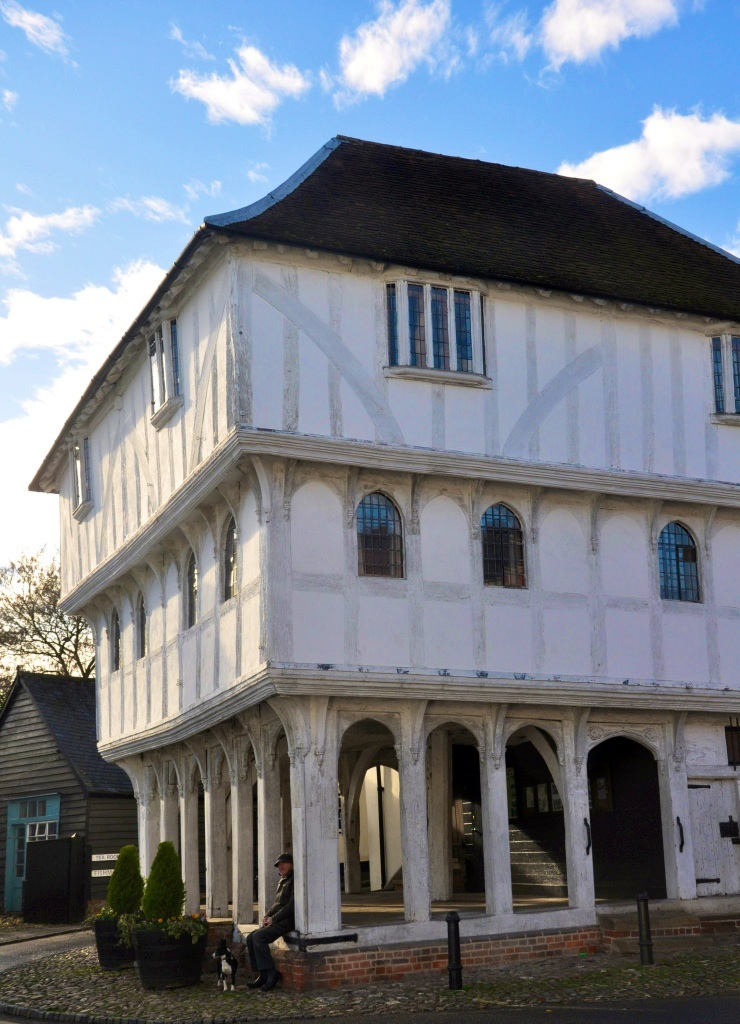
Riverside walks: the Wivenhoe Trail
It’s really hard to pick a riverside favourite as there’s just so many to choose from. The charms of the River Stour at Dedham Vale are well-documented, but it’s also a treat to walk east from Manningtree to Harwich, passing Wrabness and the quirky House for Essex along the way.
The Blackwater at Wickham Bishops reveals an almost hidden wooden trestle railway bridge tucked out of sight in a copse, the last of its kind in the country. Not far away, the Chelmer & Blackwater Navigation has a number of highlights, including Paper Mill, Hoe Mill and Beeleigh locks, not to mention Heybridge Basin, of course. The Crouch is pleasant too, particularly the north shore from Fambridge to Burnham-on-Crouch.

I do enjoy the five miles or so from Hythe in Colchester to Wivenhoe. The industrial heritage at the start of the trail is fascinating – you won’t miss the Colne Lightship in its red livery but there are some unusual wooden carvings that are easier to overlook. Wivenhoe, with its pretty historic cottages and colourful boats, is a complete contrast.
Coastal: Walton on the Naze
Surprisingly little of the Essex coastline boasts broad sandy beaches, as the presence of salt marsh creates a buffer between the villages and the sea in places. At RSPB Old Hall Marshes, near Tollesbury, and at Wallasea Island, footpaths make use of the sea walls for hikes that are guaranteed to blow away the cobwebs. That’s not to say we’re short of sand, however, from the busy beaches flanking Southend Pier to the historic iron lighthouses on Dovercourt’s Blue Flag beach.

In my opinion, the stretch of coastline between Jaywick and Hamford Water takes some beating. Though the grassy dunes of Jaywick are photogenic and the greenswards at Clacton and Frinton are ideal for a dog walk, northerly neighbour Walton is head and shoulders above the rest. With an 18th century clifftop tower, wrecked pillboxes, promise of shark’s teeth fossils and a nature reserve that’s home to migratory birds during the winter months, what’s not to love?
One last thing: show respect for local landowners
I’m always saddened to read of conflicts between ramblers and local landowners. Private land is what it says, whether we like it or not. Farmers out in their fields using machinery shouldn’t have to worry about people straying into their path – it’s important to remember that 72% of Essex is agricultural land, so stick to footpaths and marked trails if you’re venturing out into the countryside.
Unpicking the advice to UK travellers
The unravelling of lockdown continues in the UK and at the end of last week it was the turn of foreign travel to take the spotlight. We had been promised that a series of air bridges (also dubbed air corridors) were being proposed, whereby bilateral agreements would be put in place to avoid the need for quarantine at either end. Imagine: if you had to quarantine for two weeks on arrival in your chosen destination and then a further two weeks on your return to the UK, you’d have wasted a month of your annual leave without even a day’s proper holiday to show for it. Clearly, that was going to be unworkable, hence the plan to pursue air bridges.

But, as with most things during this coronavirus pandemic, the situation rapidly changed as governments rightly prioritised the health and safety of their own citizens. Some countries, such as Greece, decided that there would be a ban on direct flights from the UK until at least 15 July. Others seemed, not unreasonably, to prefer we didn’t come at all; New Zealand, for example, where the pandemic has been well and truly brought under control, has pretty much closed its borders entirely.
Underpinning all this confusion was the persistence of an FCO advisory against all but essential travel, a blanket ban which had been imposed in March and never lifted. Rumour had it that once the air bridges were announced, that advisory might be partially lifted, but rumours and maybes were unhelpful to airlines, hoteliers and tour operators desperate for clarification as they battled to stay afloat.
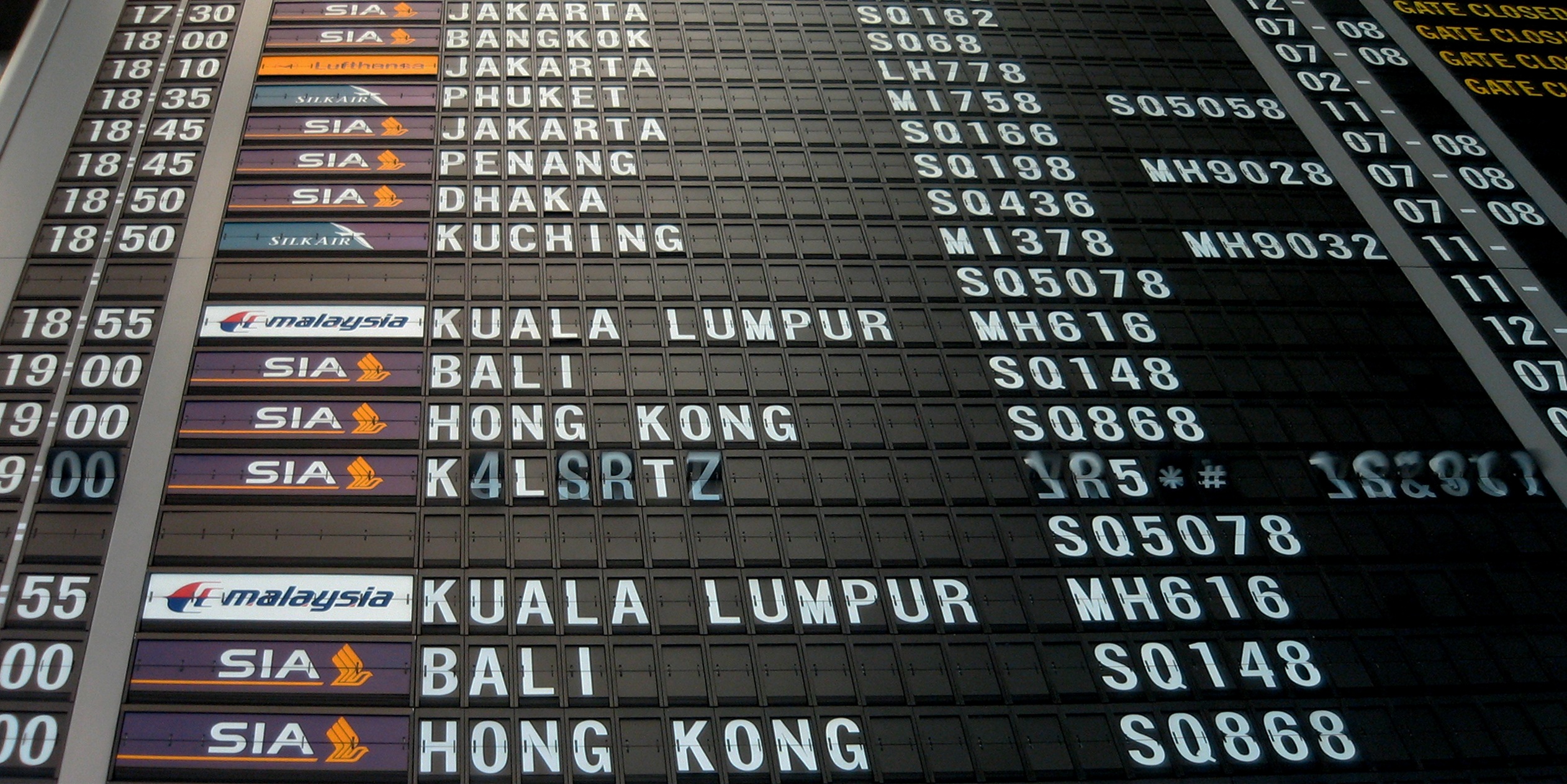
What we have ended up with is a list of countries that the UK government consider, right now, to be low risk in terms of travel. Numbers of coronavirus cases are low or at least deemed to be under control. This is the list – at first it seems there are some bizarre inclusions but these can largely be explained by their links to EU countries (French Polynesia is a French overseas territory for instance). From 10 July, UK passport holders can return from the countries on the list without the need to quarantine for 2 weeks. The majority of them are in Europe or the Caribbean – the USA and much of Latin America and Africa remain off-limits.

But there are a few other considerations to take into account before you travel:
- Will the country you wish to visit accept UK travellers. This is something you absolutely must check – the government’s advice is given only from a UK perspective and not that of the other nation. Just because we deem it safe to visit doesn’t mean they consider us a safe bet as well. Check the entry requirements – such as these for Australia – before making any firm plans.
- The situation is still changing fast. At the time of writing, two areas of Spain (in Galicia and Catalonia) have reimposed local lockdown measures after COVID spikes. Think carefully before making a booking about what you’d do if there was a lockdown in the area you were planning to go, particularly in terms of cancellations or postponements.
- Insurance policies vary in the cover they provide. Read the small print carefully and if necessary, call your insurer to clarify exactly what you will and won’t be covered for. Mine, for example, would cover me for medical bills associated with me getting coronavirus while abroad in a FCO-approved country but not for cancellation caused by a coronavirus outbreak.
- What will your holiday experience be like in the country you plan to visit? Some countries are pretty much back to normal, but in others, bars, restaurants, museums and even beaches could be subject to social distancing, reduced opening hours or management measures such as the requirement to wear a mask. Do your homework and find out whether what’s important to you is currently possible.

Now is the time to be cautious. I’m holding off travel until September, by which time I think we’ll have a clearer picture of whether international travel has impacted on case numbers. I’ve risked buying flights, but everything else will be arranged on a free cancellation basis or done last minute.
This could be the time you book that staycation you’ve been promising yourself – though be equally careful when committing to a particular location, as the UK has had to reimpose local lockdowns too. Wherever you are and whatever your plans, happy travels and good luck!
I’m tentatively travel planning again – are you?
Over the weekend I booked a flight to Iceland. If I’d written that this time last year it wouldn’t have raised an eyebrow. After all, I’ve been twice before – once to get married – and so a return trip would be nothing to shout about. But of course, this year is different.
I might not go.

I’ve only once in my life booked a flight thinking that there was a very real possibility I wouldn’t use it. It was for a day trip to Germany, and dependent on my husband’s work schedule. It cost less than £20, so when he had to fly off to the US at short notice, I wrote off the trip. This time, whether I get to go or not is most likely going to be out of my control. Right now, the stats for COVID cases in Iceland are looking very promising – a relatively small number of cases and very few deaths. But that’s not the problem.
Cases in East Anglia have now subsided to a low level and my local area is slowly getting back on its feet. I’d hesitate to use the word normal, but most shops are open, cafes are offering takeaway cream teas and the big coffee chains are open for business. I can see my friends, albeit at a distance. But yesterday’s announcement about Leicester having to reintroduce lockdown measures after a spike in cases is a reminder that nothing should be taken for granted. As people become more mobile again and have more reasons to go out within and beyond their local area, it will be interesting to see what happens to the number of cases in the UK. I’ve been out of my own county just once since March – to buy a sofa of all things – and have no immediate plans to do so again.

The British government is imminently expected to announce a series of air bridges. It imposed a 14 day quarantine period on those entering the UK and travellers arriving from these air bridge countries will be exempt from this. There’s talk of a traffic light system: green for safe countries, amber for caution and red for, well, danger. Many of the countries are thought to be the popular European summer destinations – Spain, France, Italy and so on. If this goes ahead, we should soon see if this has brought the dreaded second wave or if flying and travelling can be considered an acceptable risk once again. I had nothing booked for summer, so haven’t had to think about how I feel about an existing trip. Have you?

I’m anticipating the FCO advice will broadly follow the traffic light pattern and even though Iceland has not been mentioned when it comes to talk of air bridges, it could well be in the green category. Currently Brits can visit Iceland so long as they take a test on arrival and it’s negative (if not it’s a 14 day quarantine). If that policy holds out, then best case scenario is that my holiday will go ahead as planned; worst case scenario is that I test positive and spend two weeks in quarantine at the Icelandic government’s expense, forfeiting everything I’ve booked. Right now, I’d need to quarantine for 14 days on my return, but as I work from home anyway, that’s not a deal breaker.
Last week I renewed my annual travel policy – surprisingly with no increase in premium – and am covered for medical treatment including that for coronavirus, so long as the government hasn’t advised against travel to the country in which I show symptoms. That FCO advice is crucial. I’m not sure I’d want to take the risk of travelling without insurance, particularly for somewhere that has a high cost of living like Iceland. However, I have done so for brief periods during my trip to the Caucasus, for instance when I spent a couple of days in Abkhazia. It’s really a case of wait and see at the moment.

In any case, regardless of FCO travel advice, I won’t be covered if I need to cancel because of coronavirus. In practice, that means that the amount I’ve just spent on flights (less than £100) won’t be recoverable if I can’t go, though I’m hopeful I’d get a refund or voucher. Anything else, for now at least, will be reserved on a free cancellation basis and reviewed at regular intervals between now and my September departure date. In the meantime, I’m planning an itinerary that I hope to follow this year – so far it includes the Diamond Circle, Arctic Henge, elf school (yes, it is a thing!) and the sheep roundup known as rettir – but may have to postpone until 2021. Watch this space.
Top spots for crowd-free travel
As Brits and Europeans tentatively prepare to travel again, governments are formulating plans to manage international holidaymakers. For many of us, a quiet, off the beaten track destination might be the answer to a less stressful trip. So if, like me, busy cities are a big turn off for you right now, what are the top spots for crowd-free travel?
Georgia
This Caucasus nation took decisive action early on to implement lockdown measures. As of the end May it had reported less than 750 cases and just 12 deaths from COVID-19 (source: Worldometer). Its population is 3.7 million. The Georgian government plans to reopen hotels in July as part of a phased relaxation of the country’s lockdown rules. Bilateral travel corridors are being discussed; Israel’s agreement is already in place but it seems likely others will follow. The wide open spaces of mountainous Svaneti will appeal to those wishing to hike Alpine pastures and woodland paths which lead to dramatic glaciers. When I visited the region in June a few years ago, I had many of the trails to myself.

Iceland
Located in the mid-Atlantic with a tiny population, Iceland was always going to be well placed for post-COVID travel. To date, it has reported 1805 cases and 10 deaths. Its government have seemed keen on welcoming international visitors while remaining alert to the risks they might pose. Current indications are that the country might reopen on June 15th. There’ll no longer be the need to quarantine for 14 days as has previously been the case, but instead there’ll be screening on arrival and contact tracing for those who wish to visit. Away from tourism hotspots such as Reyjkavik, Jökulsárlón and the Golden Circle attractions, there are no shortage of places where you can expect to enjoy Iceland’s breathtaking landscapes without having to share them with too many others.

Sweden
This Scandinavian country opted to follow a different policy to many of its fellow Europeans, eschewing a lockdown in favour of social distancing. While you may still fear the crowds of Stockholm, the High Coast region, a four hour drive north, is as remote as it is beautiful. Pretty Ulvon, Mjallom and Bonhamn await those who prefer their waterfront to be backed by verdant coniferous forest and dotted with russet red wooden houses. The existing travel ban for foreign travellers (currently in place until June 15th) does not include EU, British and EEA citizens. However, there are advisories in place that suggest the Swedish authorities do not yet consider it wise for tourists to stay overnight in visitor accommodation.

Malta
While Malta remains closed until at least June 15th, government tourism officials are making all the right signs when it comes to a relaxation of border controls this summer. It looks like bilateral talks with countries that have experienced relatively low rates of coronavirus, such as Luxembourg, Norway, Serbia, Slovakia, Austria, Czech Republic, Latvia, Lithuania and Israel, are making headway. How soon afterwards citizens of countries such as Italy, France, Spain and the UK might be able to travel is uncertain. But this Mediterranean Island, whose population numbers around 440,000 people, has to date had just 616 cases and 7 deaths. That figure may put many potential visitors’ minds at rest if they have a holiday booked there later in the year.
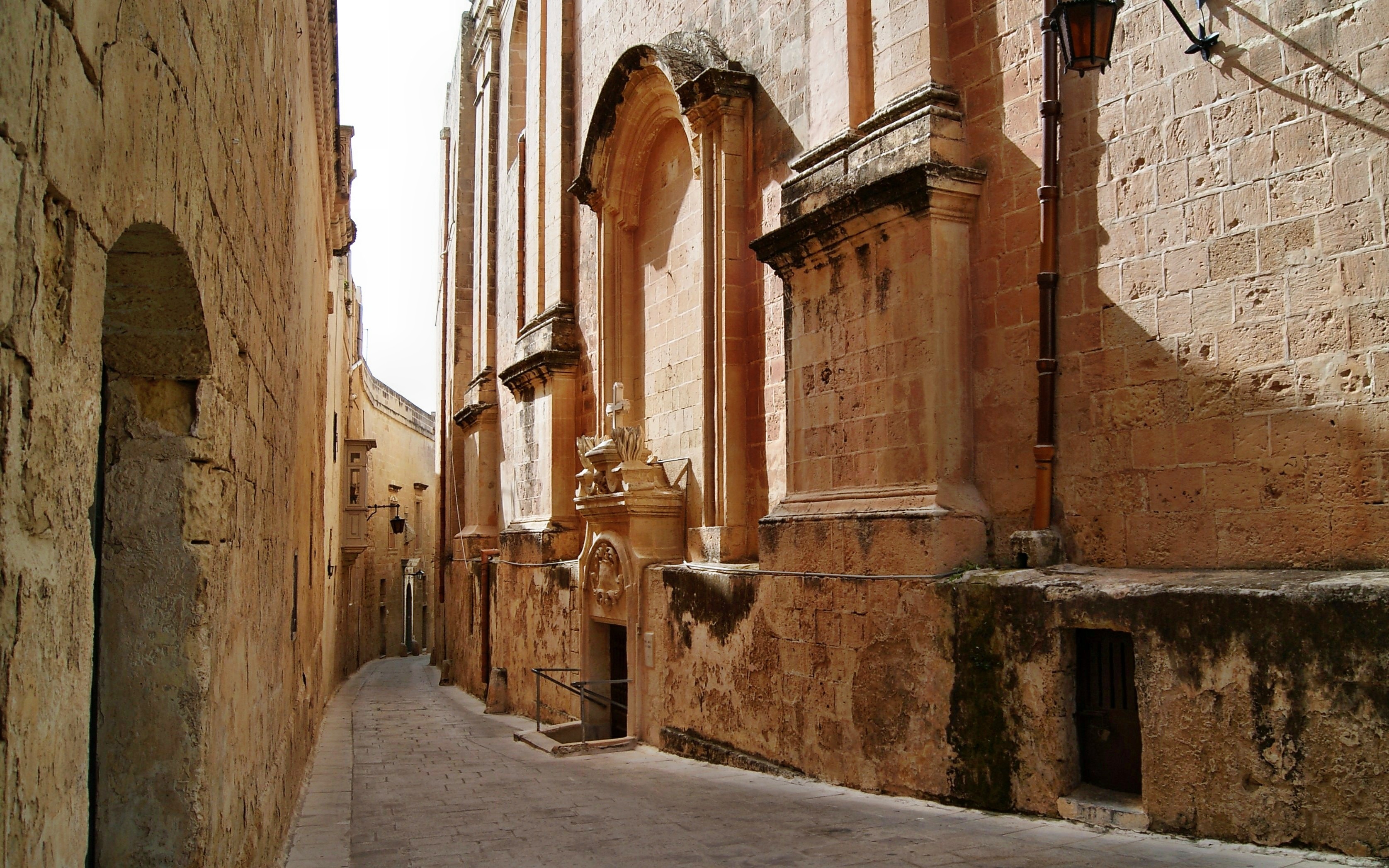
“There are three kinds of lies: lies, damned lies, and statistics.”
A word of caution: those statistics that look so certain on our computer screens might not be as reliable as we think. Countries are gathering data differently, reporting inconsistently and updating figures when new ways of calculating totals are adopted. Dig a little deeper, and that country with an impressively low death total could be reporting only those who test positive in hospital, for instance, rather than those who have the virus.
Plan to be flexible
If you do plan to holiday abroad later in 2020, do as much research as you can – the situation is changing rapidly and what might look possible and practical now may not be so in a few weeks or months time. As a consequence, many of us will prefer to remain at home or have a holiday within our own country. If we do book travel, we’ll need to be careful not to make plans that are too concrete – cancellation and postponement policies will be scrutinised like never before, as will the financial health of the companies we plan to book with.
That the country you wish to travel to is open for business goes far beyond its border controls. Accommodation, food, retail and activity sectors will all play their part too. There’d be no point in travelling if the kind of holiday you’d expect just isn’t possible once you get there. On top of that, you’ll need to feel confident that the risk you take making the journey is one that’s acceptable to you. Quarantine may also be imposed as well, perhaps by foreign governments, or our own. There may be paperwork involved: COVID passports, negative test results and in time, we hope, vaccination certificates. And of course, the FCO will also need to remove its current ban before British travellers can travel with valid insurance policies. That’s a lot of ducks to get in a row.

I have no firm plans at present and, like many of us, am in no rush to make any. For a travel writer and someone for whom travel has always been such a big deal, that’s quite a statement. Throughout this pandemic, my feelings have changed as to what kind of travel I’d feel comfortable with and where I’d like to go. So it’s anyone’s guess when and where my next trip will be, though there will be somewhere, some day. Those places on our wish lists will still be there when we’re ready to experience them, so what’s the rush?
Thoughts on Hudson Yards, New York
The juxtaposition of the traditional brick apartment buildings of W 28th Street with the futuristic glass and steel structures of Hudson Yards behind is a quintessentially New York kind of view. In the soft light of a clear winter morning, Edge and its neighbours looked almost ethereal. Close up, approached from the last stretch of the High Line, they were an imposing sight. Last time I’d been in the area, this was a building site. Today, this privately funded complex is making its bid to become the latest go-to neighbourhood in the city.
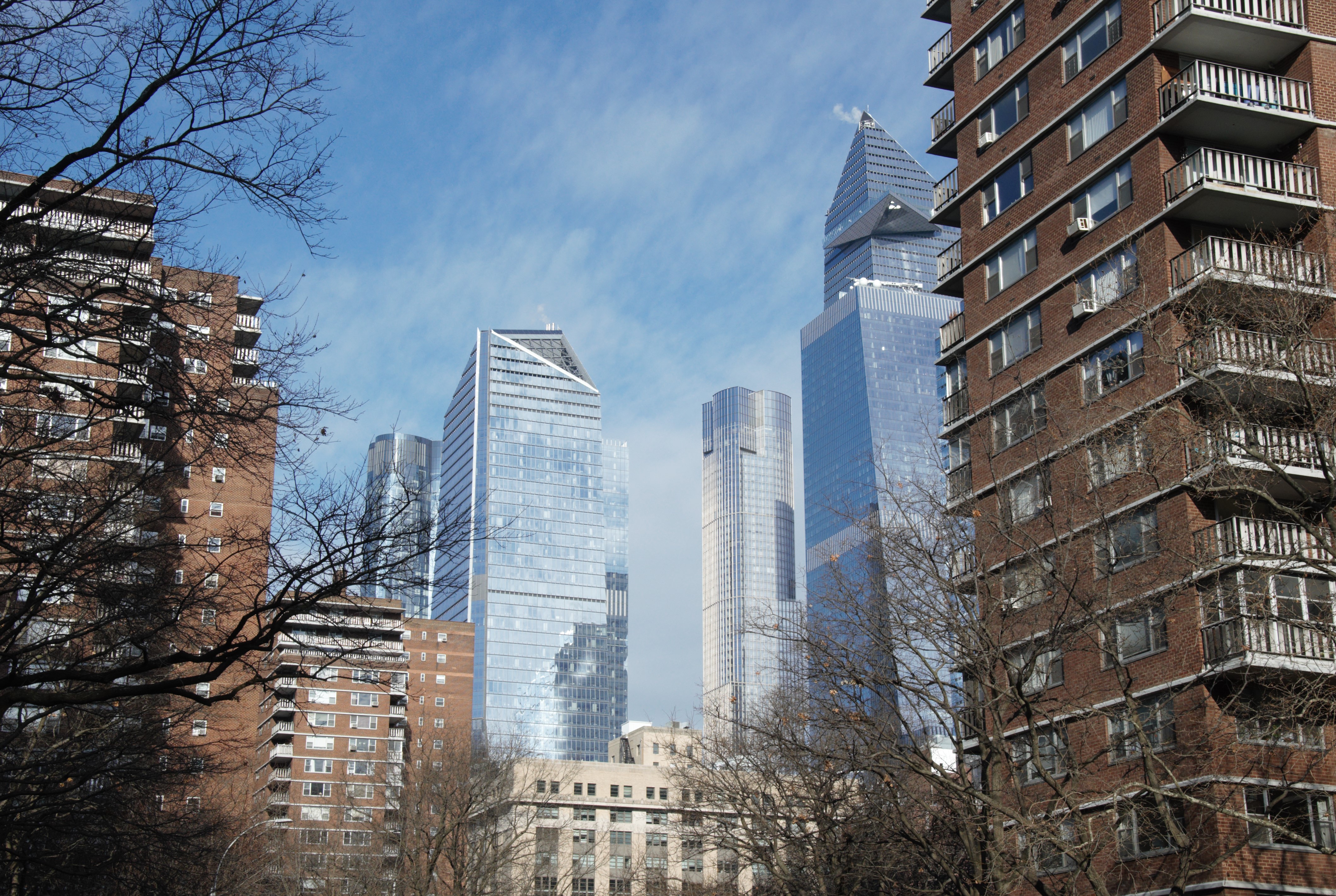
Edge won’t open until mid-March 2020; when it does, it will become the highest outdoor observation deck in the western hemisphere. I had been offered a preview visit by the representing PR but it fell through half an hour before I was due to go up, thanks to unexpected construction work. I had to content myself with a view of the outside from below and the video projected inside the mall. Will it find its place in the already saturated market for high rise observation decks in Manhattan? Time will tell.
In the meantime, in front of it stands Vessel, which opened in 2019. The structure was dreamed up by British designer Thomas Heatherwick, who had a hand in the new Routemaster and the failed Garden Bridge amongst other things. Entry is free, so long as you are happy to be pinned down to a specific date and time. You can get turn up and go up tickets on the day if they’re available, or reserve them up to two weeks in advance. That’s just as well, for a staircase (well, 154 staircases to be precise) is pretty much all it is.

Clad in a coppery metal (it’s actually Italian steel) which is intended to be weather-resistant, the structure cost an eye-watering $150 million to construct – an extra $50 million more if you factor in the land in was standing on. In the right spot, it might have been worth paying for, but surrounded by high rises, the only real view you get is of the shopping centre and the train yard beside the Hudson River.
If you’re unable to climb steps, it’s even more of a disappointment: the elevator runs only every 15 minutes (“to make sure it doesn’t break down”) and accesses just one of the 80 landings. If stairs are a problem, the sole view you’ll have is that facing The Shed, an event space that looks like it’s been clad in a curious kind of giant bubble wrap. As the surrounding platforms require visitors to tackle multiple steps, they’re out of reach. According to the media, this is being addressed, though there was no sign of any remedial work during my visit.
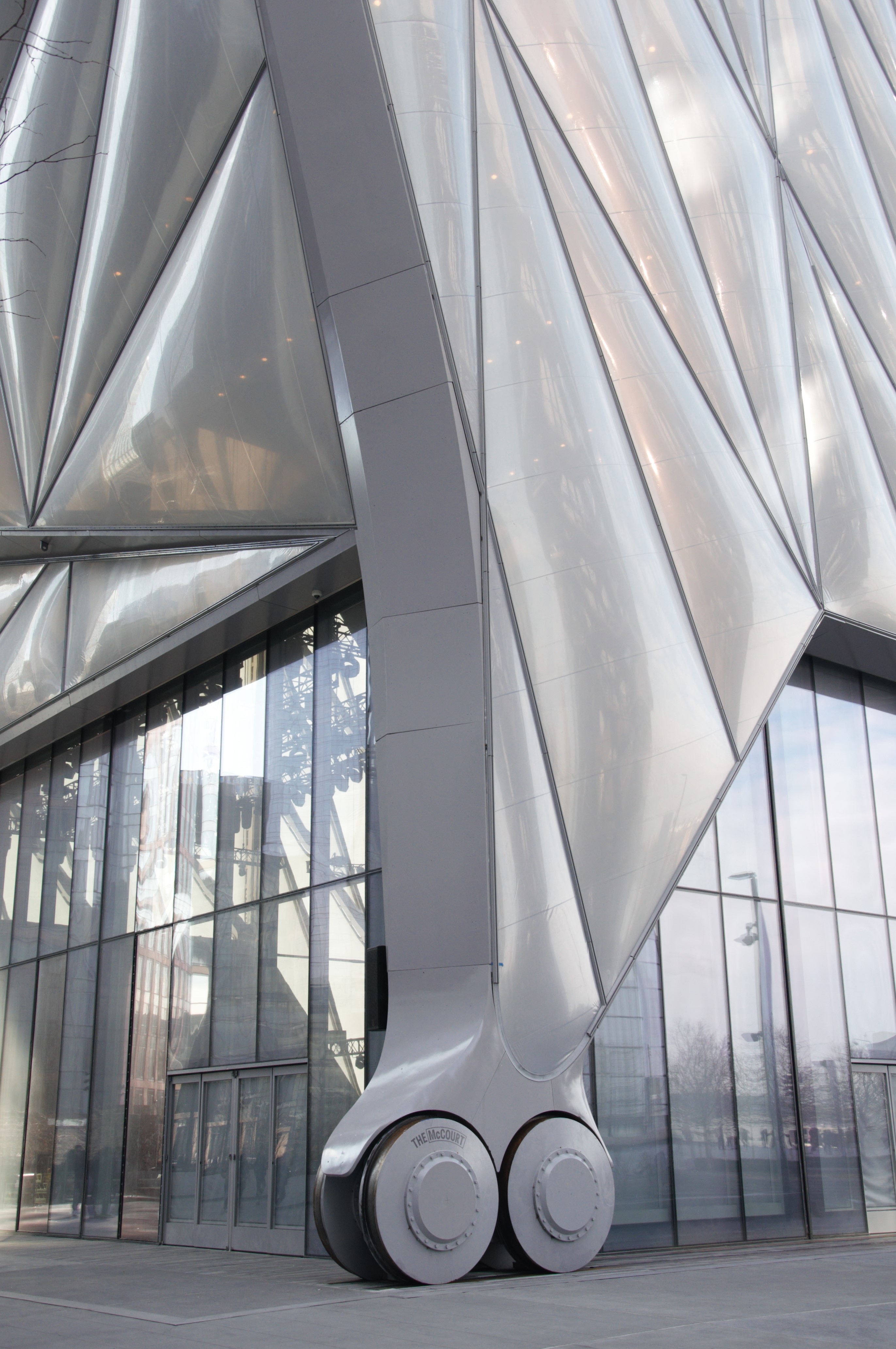
Critics have not been kind, dubbing it the “Staircase to Nowhere”. While the architects refer to it as honeycomb, others have taken their foodie inspiration instead from the humble kebab. Still more liken it to a waste paper basket. The name Vessel is temporary. The architects have solicited suggestions from the general public and been inundated with the likes of Staircase McStaircaseface, Meat Tornado, The Rat’s Nest and the Chalice of the Privileged, so it’s likely to call itself Vessel for the foreseeable future.
Even the aim of making this a place where people congregate seems a little fanciful given its less-than-central location.There’s nowhere to sit, and nowhere much that’s under cover, especially at ground level. For a plaza that’s supposedly designed to function as a meeting point, that seems a curious oversight on the part of the developers.
Hudson Yards’ position right up against the Hudson River also makes it an unlikely spot for acting as a meeting point. Though the 7 train is only a short hop from Times Square, if you plan to walk it’s a not especially scenic cross-town stroll. If you planned to meet undercover in the shopping centre instead, that won’t help much: there’s almost no seating there either, save for a few chairs and tables assigned to the cafes inside.

I couldn’t help thinking how starkly that contrasted with the High Line, where hardwood benches and recliners were factored into the design. But then the High Line began as a community project and from its inception, those planning its regeneration worked hard at making it a place that had a soul. Even on the most miserable of winter days, when the plants are a dessicated brown and the wind bites at your cheeks, you’re surrounded by the stories of the past.
So, like many who have reviewed the space, I’m afraid I too was underwhelmed with Hudson Yards. It didn’t help that my pre-booked slot for Vessel was for a day when grey skies bled first drizzle and then steady rain. The weather matched my glum mood. I expect I’ll return, to visit Edge, when I’m next in the city, but I can’t see a reason why I’d hang around at Hudson Yards beyond that. Instead, excuse me while I potter off along the High Line and find myself a bench.
How to make your holiday allowance stretch a little further
I’m lucky that I’ve never had to carefully count the days off I’ve been given by an employer. Two decades working as a teacher gave me busy terms full of stress but three months’ holiday a year to recuperate and unwind. Now, as a travel writer, you could say holidays are work, and with that logic I have endless opportunities for days off. That’s not entirely true – particularly on press trips – but more of that another time. If you are someone who needs to make every day of a meagre allowance count, here’s how to make your holiday allowance stretch a little further.
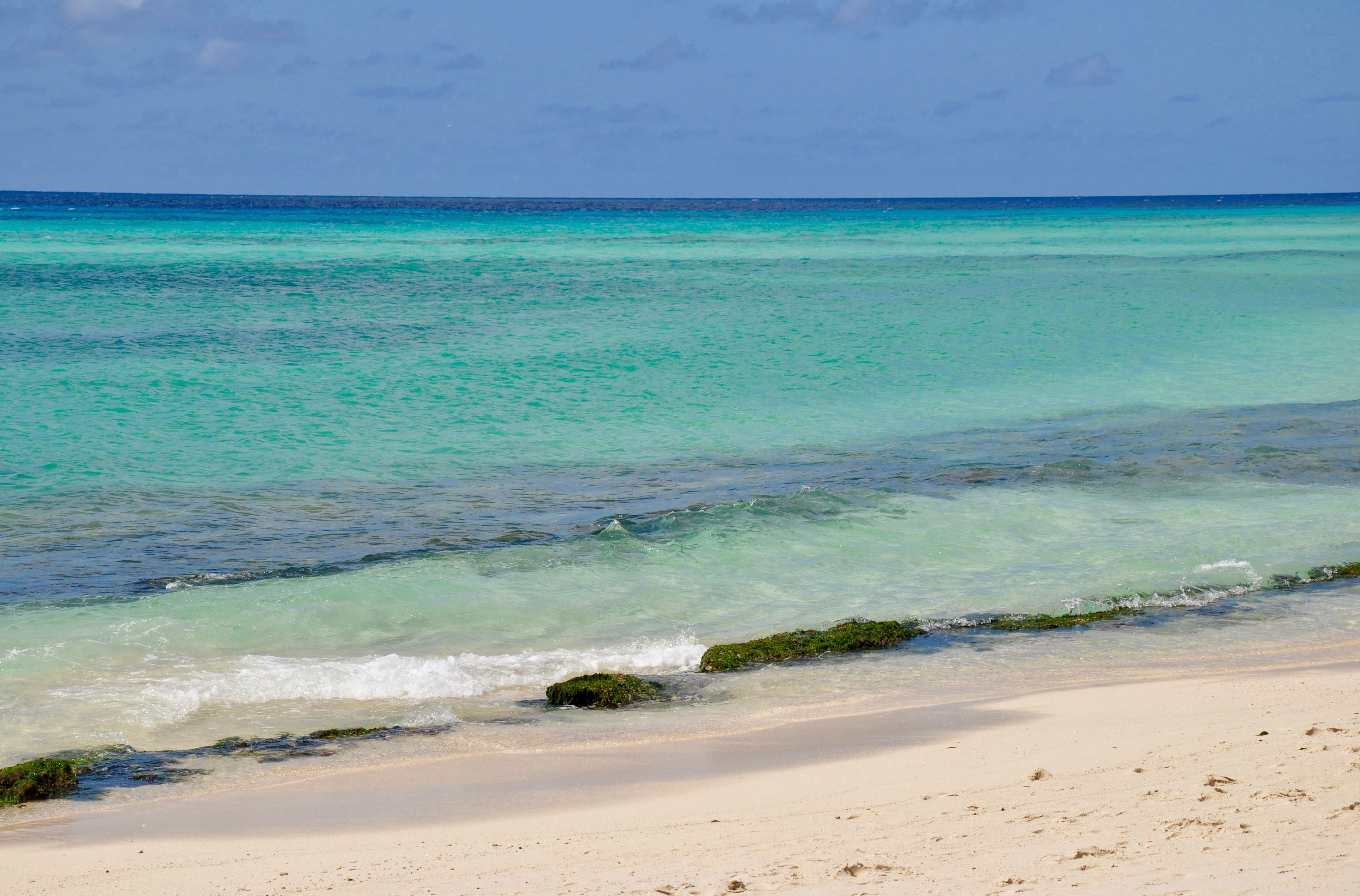
The advice I give is aimed at UK readers, but the principles can be applied anywhere. It also assumes you work in a profession where you are guaranteed bank holidays off, which I appreciate is not possible for some, such as those working in the retail, health or emergency services sectors.
Book your time off well in advance
You’re going to have to get in well in advance, but if you can nab those precious days either side of the Easter or Christmas bank holidays, you can have a longer holiday without using up all of your holiday entitlement. It’s vital to plan early, both to reserve your time off before your colleagues do and also because travel tends to be more expensive. By booking early you can secure a reasonably priced fare, though it’s still unlikely to be cheap. You need to weigh up what’s more important: having time off which doesn’t eat into your holiday allowance, or achieving the same trip for the lowest price possible.

Now check your calendar
In 2020, Easter Sunday falls on 12 April. That means in the UK, Good Friday (10 April) and Easter Monday (13 April) are also bank holidays. Already, that gives you a four day break with no need to tap into your holiday entitlement. Now the week before and the week after are four day weeks. Add these days and factor in weekends and you have a 16 day break in exchange for 8 days’ holiday. You can do something similar over Christmas and New Year. Christmas Day and New Year’s Day fall on a Friday. So, taking off the week in between requires just three days of your allowance, thanks to Monday being a Bank Holiday in lieu of Boxing Day (as it falls on a Saturday).

Take advantage of something a little unusual
This year, you might be lucky to score a long Bank Holiday weekend without the whopper of a price tag. Check your calendar and chances are, like mine, it has the early May holiday marked as Monday 4 May. That’s what we’d expect. However, the government has declared that this year, 2020, the early May Bank Holiday will be on Friday 8 May. That’s because it is the 75th anniversary of VE Day, which marked the end of World War Two. Get your flights booked before most people notice and you might just get a relatively cheap deal.

However and wherever you are spending your holidays this year, have fun and happy travels!
Review of Cheeky Panda handy wipes
I was recently gifted a pack of Cheeky Panda handy wipes to trial. This is my review. Though I was given a free sample, the opinions expressed are my own.
For many years, I’ve popped a packet of Boots’ Wet Ones into my travel bag. These anti-bacterial wipes have a lovely citrus smell and have come in handy over the years for all sorts of things. They currently retail at £1.15 for 12 wipes, just under 10p per wipe.

Recently, however, there’s been a lot in the news about how wet wipes in general aren’t biodegradable. Part of the material used in their manufacture is polyester, a form of plastic. Whether we flush them or bin them, they don’t fall apart like regular tissues might. Instead, they find their way into landfill or to the sea, where they pose a threat to marine life. Some end up in our sewers, combining with grease to form giant fatbergs. This Good Housekeeping article elaborates:
https://www.goodhousekeeping.com/uk/lifestyle/a28096696/bbcs-war-on-plastic-microplastics-wet-wipes/
Would this be the end of wet wipes for me when travelling? I hoped not, but couldn’t justify the impact on the environment if I continued to use Wet Ones. I was keen to find out whether there was an alternative and learned of a company called The Cheeky Panda.
The Cheeky Panda make a range of products that are sustainable and environmentally friendly. If you’re thinking it would be a pain to have to order them for delivery, they’re even sold at Boots. The price at the moment is £1.50 for 12, making them a little bit more expensive per wipe than Wet Ones, but not significantly so.

So are they worth the extra cash?
I contacted The Cheeky Panda and asked about conducting a trial of their handy wipes on a trip to the Austrian Tirol. It was hot, with temperatures rising above 30°C. Would they cool me down as effectively as my usual brand? I’m pleased to report that’s a yes. I found they also felt smoother on the skin, which was an added bonus. They’re made of bamboo from sustainable sources and contain aloe and an apple extract which I think gives them a hint of a scent even though the packaging says they’re fragrance free.

Could they cope with dirt too? I did a hike from the top of the Hahnenkamm and found myself scrambling in places, getting my hands dirty in the process. As the hike ended with a piece of Sachertorte on the terrace of the Alpengasthof Melkalm, I was keen to get clean first. The handy wipes did an admirable job and didn’t fall apart when I scrubbed at my hands. They’re a decent size too.

The packaging they come is what’s called PET1, a recyclable plastic with the proper name polyethylene terephthalate. I’ve opened and closed the packet a few times now and it reseals well, ensuring the wipes haven’t dried out. When I’ve finished my last wipe, I’ve just got to make sure that it ends up in my usual plastic recycling bag.
Would I go out and buy these instead of Wet Ones? Absolutely. And not just to assuage my conscience either, as I really liked how soft they felt.
To find out more about products offered by The Cheeky Panda, please visit:
A beginner’s guide to Kyrgyzstan
The love child of Switzerland and Mongolia, blessed with snow-capped mountains and hospitality like you wouldn’t believe, Kyrgyzstan makes an easy introduction into the ‘Stans. If you’re not sure where it is, you’ll find it on China’s western border – go halfway across Russia and then down a bit. The country’s attractions haven’t yet reached the radar of many travellers, and when the Border Force officer quizzed me on where I’d flown in from yesterday, he thought I said Kurdistan. Yet, it scored a mention on the Lonely Planet’s must see countries for 2019. So what can you expect of Kyrgyzstan?

Getting there
There are no direct flights to the capital Bishkek from London, and in fact the country’s airlines are off limits, featuring on the EU’s “not safe to fly” list. Given that an indirect flight was necessary and Kyrgyzstan was to be my sole Central Asian destination (for now at least!) I flew with Pegasus Airlines via Istanbul. They operate out of Stansted which is convenient as that’s my closest airport. Book well ahead and they’re pretty cheap too. My flight cost £337. Though there are plenty of options for the first leg, flights to and from Bishkek are limited to one a day. Schedules change, as they did for me between booking and date of travel. What had been a three hour layover on the outbound journey changed to a five hour layover.

That had the minor advantage of arriving at a more convenient 7am, but Sabiha Gokcen Airport isn’t close enough to the city for between-flights sightseeing unless you have a seriously long layover, so I holed up in Starbucks instead. If you’ve never been to Istanbul, pick an early flight out of the UK into the city and kill time sightseeing until the second flight departs at 11pm. It takes about an hour on average to get from the airport to the city, but allow time for traffic-related delays.
Another option might be to use Air Astana and combine Kyrgyzstan with a visit to neighbouring Kazakhstan. Bishkek and Almaty are little more than a couple of hundred kilometres apart. Air Astana has direct flights from London for a similar price. Check your visa requirements before you book.
Getting around

Depending on what you plan to do and how ambitious your itinerary is, you could make use of the country’s network of public minibuses, known as marshrutkas. These bear the name of the destination on the front windscreen but you’ll need to figure out the Cyrillic alphabet. I’ve always found it helpful to memorise the first or last few letters of a place name so that it’s a simpler process to clock which bus is yours. Bishkek for instance shares the same last three letters so look for “kek” at the end of the word. If you plan to loop Issyk-Kul, the country’s largest lake, you shouldn’t have a problem finding transport. Note that these minibuses go when full and won’t stop along the route if they have their full complement of passengers, so plan accordingly.
If like me you want to cover more ground and head a bit further off the beaten track, it’s worth considering a car and driver. I found Advantour to be very helpful at the initial email stage, with prompt responses and useful suggestions about whether what I was planning was doable. Marat and I bounced ideas and refinements back and forth a few times before settling on an itinerary that covered the places I wished to see at a budget I could afford. Including accommodation, I paid about £800 for my week’s activities. You’ll see from the itinerary below that it represented excellent value for money.

Another option, particularly if you have a little more time to play with, is to make use of the CBT organisations that are spread across the country. Community based tourism is a big thing in Kyrgyzstan and these helpful offices can sort you out with somewhere to stay, transport and the full gamut of activities. Each town has its own, and some even have several competing CBTs. They can hook you up with local guides, hiking packages, horse riding treks and more. I also liked the fact that they’re big on interactive experiences and will arrange cooking classes, felt-making demonstrations and more. This casual insight into Kyrgyz culture is great for the first-time visitor. Many of the bookings that Marat made for me were via the CBTs, but it’s useful to know you can cut out the middleman.
How to spend a week in Kyrgyzstan
Day 1
The advantage of arriving on the night flight is that you have an extra day to play with. The downside of pushing fifty is that sleeping fitfully on a five hour flight doesn’t refresh you enough to permit morning sightseeing. The good news is that many of Kyrgyzstan’s hotels and hostels offer an early check-in for 50% of the room rate. I opted for the budget-friendly Apple Hostel for my first night and a half, which came in at about £30 for an ensuite double for sole occupancy. Its edge of town location was good for a rush hour arrival as we didn’t get caught up in any traffic and took just twenty minutes to get from the airport. The taxi transfer, arranged by the hostel, cost about £7. There’s a cheaper shuttle bus which runs more or less during working hours.
I had a much-needed nap and then had Marat send my driver over for noon. After a brief detour to his office to pay for my tour, Adyl drove me to nearby Ala-Archa National Park. This beautiful park is only about a half hour drive from the city and is centred around a dramatic canyon flanked by mountains. In late May, there was still a slight chill in the air, but blue skies meant that it was perfect hiking weather. A tarmac path takes you along the river bank. That trail ends at an outwash plain where graded cobbles and streams of water can be forded to continue the walk. You can hike for 18km though I settled for a shorter walk. A couple of red squirrels were very friendly when I got to the benches.

Day 2
I was keen to ride, and had read that one of the best places to do so was in the Chong Kemin valley, a few hours east of the capital. Marat suggested I’d need to get almost as far as Karakol today to be able to complete my wish list, so I opted for a two hour ride. My guide was the chatty Beka, who’d gone to Bishkek to study English and French before returning to his beloved valley. My request for a helmet was an initially misunderstood, as he fetched me a cap to wear. The second attempt was a bicycle helmet which I figured was better than nothing.
The next two hours were a pleasure, taking a leisurely ride through rolling hills and fording occasional streams (more importantly, learning to recognise the signs that your horse is about to take a bath with you on his back). Beka interspersed nuggets of Kyrgyz heritage and history with tales of his own somewhat chequered love life. Aside from my horse almost bolting after being startled by the air brakes of a lorry as we got back to the village, it was a most relaxing ride.
From there, we drove east, doubling back to stop for lunch in the Kyrgyz equivalent of a motorway service station midway through the Boom Gorge. Food’s cheap: you can have a proper meal for about 150 som (£1.50). Following the north shore of Issyk-Kul from a respectable distance, we pulled off the highway at Tamchy for a photo stop on the beach itself. We were a few weeks off main tourist season, so the place was deserted save for one lone paddler. The neighbouring resort of Cholpon-Ata is very popular with Russians in summer. From what I could tell, it had a lot in common with the Black Sea resorts they also favour.

Our overnight stop was at a charming guesthouse, Reina Kerch, not far from Karakol. Set off the main road, it boasted panoramic views of the nearby canyon, but was also a working farm. Herds of sheep and cows pottered in distant fields but it was the horses I was keen to see, as the farm prided itself on thoroughbreds. The best competed in trotting races and I was able to watch one of their most successful stallions impregnate a mare. A tour of the stables followed. Next up was a boorsok-making demonstration. Boorsok is a fried dough cut into ravioli-like pieces. The dough was already made but I helped roll, cut and fry. It was salty and delicious. Dinner was excellent, making good use of the farm’s homegrown produce.
Day 3
Staying just outside Karakol on a Sunday, it was hard to resist a visit to the animal market on the edge of town. Scotski Bazaar isn’t the country’s largest – that honour goes to Tokmok’s weekly market which we’d passed the day before. The action starts in the middle of the night, but at around nine, it was still busy enough to be worth a visit. Sheep are traded nearest the entrance; those hoping to sell tie them to car bumpers with string leads. Further in are the cows and bulls. I was told a decent cow could go for $700 or $800. At the rear are the horses. I was made to feel very welcome.
Next up was Karakol itself, for a brief visit to the Dungan Mosque, which looks more like a Chinese temple than a regular mosque. That’s no surprise: the Dungans are Chinese Muslims who fled across the border in the 19th century. The colourful timbers and ornate pictures on its exterior were bright and cheerful. I wasn’t allowed in, but was invited to peer through the door. Around the corner was a charming wooden Orthodox Church, which replaced an earlier stone church that was felled by an earthquake in 1890. It didn’t have the glittering domes of other Russian churches I’d seen in Kyrgyzstan and beyond but it was a delightful sight. Mass was taking place, so I contented myself with a glimpse through the door.

From Karakol, we followed the southerly route around Issyk-Kul. The Jety-Oguz valley was a short but worthwhile detour for its beehives as well as the Broken Heart and Seven Bulls rock formations. As we drove out of the valley, the weather took a turn for the worse and we drove through some heavy squalls. The spectacular mountain backdrop was a damp squib, obscured by thick cloud. The foreground scenery was stark also, nowhere near as pretty as the panoramic views I’d enjoyed thus far.
No matter, just after the scruffy town of Bokonbaevo we pulled off the main highway to reach an Alpine meadow, where we had an appointment with an eagle hunter. He produced a magnificent pair of golden eagles from the boot and back seat of his car – they couldn’t travel together as they would fight, he explained. His display was both captivating and, when he produced a live rabbit as bait, horrifying. However, I tried to rationalise the sacrificial bunny as nature’s pecking order. Nothing would be wasted, said the hunter, bundling the kill into a sack to take home. It would feed both eagles for the rest of the week. The thrill of watching a skilful bird such as this home in on its prey was, I reluctantly admitted to myself, impressive. If you’ve no stomach for hunting, you might choose to skip this, but such a tradition has been a part of the Kyrgyz culture for centuries.

Back on the road, through more heavy showers, we reached Kochkor. Late afternoon, I was treated to a shyrdak demonstration. Felt-making is another important Kyrgyz tradition and my tutor was as skilled as she was smiley. Once again, active participation was expected and I found myself making the reed mat and stitching fabric together. A full sized carpet, I was told, takes five people two years to make. A single square can be knocked out in ten days. And I’m pleased to report there was no hard sell for either. Accommodation tonight was at a very plush homestay on the edge of town, affording magnificent views of the Tien Shan Mountains when the sun finally made an appearance.
Day 4
After the previous day’s storms, a dumping of snow on the mountains wasn’t the best for our ride up and over the Kalmak-Ashu mountain pass (highest point 3447m) to Son-Kul. This lake is smaller than Issyk-Kul by some margin, but its remote location ringed by snowy peaks makes it breathtaking. Late May is very early in the season to be up there at all, and the road had only been open for two weeks.

We climbed steadily above the tree line. The road was wide, but it wasn’t long before we were driving alongside snowdrifts two metres high. The reward at the top for being one of the few to attempt it was a pristine meadow of snow which I left with two long lines of footprints. There was also a snow filled long drop toilet. This far into the tour, it had become something of a joke between Adyl and I that I couldn’t go more than a couple of hours without a toilet break.

The approach to Son-Kul was just as wonderful, descending to emerging spring grass and fields of yellow buttercups. A few yurts were open for business, but at 3016m the lake is a summer destination. After crossing the Chu River, the lake’s only outlet river, we attempted to off-road to the lakeshore but the ground was still too soft for this to be possible.

After a few failed attempts we bailed and drove down the spectacular Thirty Three Parrots Pass. A series of dramatic switchbacks carries you down the pass, and at each hairpin bend I caught my breath. I was glad to be the passenger! It’s surely up there with one of the world’s best drives though, if you have the head for it. A French traveller in a camper van had got cold feet halfway up and was trying to pick up courage to complete his ascent. A family of nomads in a small lorry, yurt in the back, made light work of it and waved enthusiastically.

Before we headed into Naryn, Adyl invited me to try kymys, fermented mare’s milk which has a rather unpleasant sour taste to those unused to it. I managed a couple of sips, which was more than can be said for my attempt to drink a cup of Maksim, another popular sour milk drink which is just about the most vile thing I have ever tasted. Bustling Naryn was a bit of a shock to the system after a day’s solitude but Datka’s Guesthouse was comfortable and clean. At about £18 for an ensuite room with TV and hairdryer, breakfast included, it was a steal. She throws in dinner too for an extra 350 som (£3.50).

Day 5
A much easier drive of around an hour and a half took us to Tash Rabat. This caravanserai is centuries old – no one knows quite how many – with metre-thick walls and atmosphere in spades. A lady emerged from one of the yurts opposite to unlock and collect the 100 som entrance fee (about £1, a bargain!) I was fortunate to have the place to myself for the first half an hour or so, wandering from room to room trying to imagine what it might have been like to stay in such a place. Some rooms had long benches of rock, others were square. All had skylights open to the elements which let in shafts of light. I emerged from one side chamber to give a recently-arrived Korean tourist the fright of her life (unintentional).
Outside, the way that Tash Rabat was engineered means that it’s pushed right up against the hillside. Climbing onto the roof and gazing down into the skylights is a peculiar sensation. The Korean had hiked up a nearby hill, so once again I had the place to myself until a bus load of Kyrgyz pulled up. The kids in the party scaled the walls with ease, chucking tiny stones down to their parents which, given the tone of voice, earned them a scolding.
My overnight lodging was within sight of Tash Rabat. Sabyzbek, a 62 year old maths teacher turned farmer, had a small guesthouse and a collection of four inviting yurts. Located in the quiet Kara-Kojon gorge, the road crossing the river and enabling access by car had only been built five years ago, transforming tourism in the valley. He was keen to show me both, reminding me several times that at 3200m and with a chill wind barrelling down the valley, the yurts would be cold once the sun set. Temperatures would fall below zero, he said, though I couldn’t pin him down to exactly how far. I decided to risk it for the adventure, figuring that I could pile on the spare bedcovers and every fleece I’d brought to stave off the overnight cold.

Just before lunch, a wander around the farm led to another confronting sight. This time, the local vet was castrating a stallion. Judging by the horse’s wide eyes and blowing nostrils, accompanied by the ropes holding him down, the operation was performed without the use of tranquillisation. Potassium permanganate was used to sterilise the area and a hot poker cauterised the wound. It was uncomfortable to watch, but again, part and parcel of nomad life. Such lack of censorship is both the joy and the pain of visiting somewhere unused to mass tourism. I left as the second patient was being led to his fate.

The afternoon was a pleasant one. Though the wind was biting, once you were out of it, the sun was rather nice. I tucked myself into a natural hollow, two woolly jumpers keeping me snug as I felt the warm sun on my face. Farm life carried on around me: a cow mooed insistently, chickens clucked over and pecked at the discarded balls of the morning’s business and horses pottered about. Every now and then, a car passed, bound for Tash Rabat, but by and large, it was quiet enough to hear birdsong. After dinner, I chatted with Sabyzbek’s daughter Tuzsun about Kyrgyz life, expectations and change. Dusk fell late; a pink sky soon clouded, I didn’t know if that was a good or bad thing when it came to how warm the yurt would be. A fire was lit in the coal burner, started by dung, just in case. I was toasty – so much so that I spent half the night with one leg stick out of the duvet resting against the cold slats of the yurt in an attempt to cool off.
Day 6
It was a long drive back to Bishkek and an early start was in order. The fire had kept me toasty inside the yurt but there was a frost on the ground outside. A bowl of steaming porridge and a mug of hot tea later, we were on the road again, retracing our steps to the capital. Bishkek’s sultry heat was a shock after several days in the mountains. I took a stroll from my centrally located hotel to Ala-Too Square. Its tall flagpole is no match for those in other Central Asian capitals, but impressive nevertheless. Nearby are several leafy parks offering the temptation of plenty of shade, as well as the presidential palace known as the White House. After a cold drink, a so-so pizza and a chat with a waiter keen to practise his English, it was time to go and pack for the following morning’s flight home.

Would I go back?
Absolutely! Kyrgyzstan was everything I’d hoped it would be and then some. I’d love to stay in a yurt at Son-Kul and revisit the delightful Sabyzbek and his family at Tash Rabat. Osh and the Fergana Valley would also be on my wish list for a second visit. I’d definitely use Advantour again. Marat’s suggestions were invaluable and his organisation faultless, well worth the money I spent!
A few observations
The Kyrgyz are hospitable and go out of their way to make you feel welcome. I asked one hotel owner why. “Simple,” she replied, “many of us can’t afford to travel, so we learn about other countries through the people that come to see us.” I’d suggest learning a few phrases in Russian as many people speak very little English. Having a copy of the Cyrillic alphabet to hand so you can figure out lone words is also a good idea.

Kyrgyzstan is a cheap destination and your money will stretch a long way. Even my smart hotel in Bishkek cost only $95 for a luxurious and very central room. Most comfortable guesthouses come in at around a quarter of that cost. It would have been possible to do the Ala-Archa and Issyk-Kul trips by marshrutka for a fraction of the cost of a car and driver. Likewise public transport to and from Kochkor and Naryn was plentiful.

If you intend to self-drive, the roads are for the most part in excellent condition. Aside from the gravel roads up to and down from Son-Kul, there were none that would challenge an average driver and there were very few potholes. However, road signs are sporadic in places so it’s best to take a good map. Traffic police are everywhere: watch your speed if you don’t want to be flagged down and fined. Watch out for herds of livestock being moved between pastures and the occasional suicidal marmot.
Travelling in the shoulder season, you’ll have many places almost to yourself. I visited in late May and the road to Son-Kul had been open for two weeks, though snow still lined the Kalmak-Ashu pass. By mid-June, there’ll be plenty of yurts set up to receive visitors and off road trails down to the lakeshore will be safe to drive. By September, the season’s pretty much at an end unless you plan to ski.
It’s customary to take off your shoes when entering a house, and the same applies to homestays, guest houses and yurts – in fact the only place where it wasn’t expected was the fancy pants hotel in Bishkek. Do as the locals do and opt for footwear that can be easily slipped on and off, rather than have the bother of unlacing hiking boots each time you want to go inside.

Toilets, save for posh hotels and the airport, are almost universally of the squat variety. Some are much cleaner than others. Those I encountered at the Kalmak-Ashu pass were full of snow. Have a stash of toilet paper handy but note that it needs to go in the bin as Kyrgyzstan’s plumbing can’t cope with paper.
English readers, everything seems to come in Morrison’s carrier bags. It’s very odd receiving a plastic bag featuring the distinctive M from a few years back and even more bizarre when it happens over and over again. I’ve yet to get to the bottom of this mystery (it’s been 12 years since this design has been used in the UK) so if anyone who’s reading this knows why, do leave a comment!

An unexpected giraffe rescue in Uganda
It was one of those jaw-dropping moments that travel is supposed to be about: sunrise over a flat calm Nile, the water as pink as the sky above it. Staying at the excellent Red Chilli’s Murchison Falls Rest Camp, we were conveniently situated for the earliest ferry crossing. A queue had quickly formed behind us, but our driver was pleased with himself for being first to board the rudimentary, flat bed vessel. We were too busy gazing at the water to care.
However, that morning’s game drive hadn’t lived up to expectations. Save for a bunch of Rothschild’s giraffe, a scattering of Jackson’s hartebeest, the ubiquitous kob and a few distant hippo, we’d been unlucky. Game sightings hadn’t been as prolific as I’d experienced in other East African nations such as Tanzania and big game were conspicuous by their absence. It was looking increasingly likely that we’d be returning to Kampala a little disappointed, the sunrise proving the highlight of the day. Even our ranger seemed to have lost interest after his initial animated commentary.

Suddenly, we pulled over on the dirt track and looked across at a vehicle careering off road across the park. My first thought was that our ranger was about to give them a serve for off-roading, but as they drew closer, we could see that they were uniformed personnel working for the Uganda Wildlife Authority. It turned out that one of a pair of elderly giraffes under a nearby tree had caught his hind leg in a snare.
Sadly, the threat from local poaching, despite efforts to tackle the problem, remains a significant one. The Uganda Conservation Foundation reported that bushmeat poaching, primarily through the setting of snares, continues to pose a significant threat to wildlife in the park:
“In April 2011, 40 rangers did a three day patrol of the Delta to Pakuba area of Murchison Falls, the region most densely populated by animals and a tourism hotspot. Over three days 1154 snares were recovered and destroyed. On February 12, 2013, rangers did a six- hour search in the small part of the Delta and discovered 285 wire snares. Large scale clearance of existing snares and gin traps is ongoing. One large scale sweep by rangers was done in March 2014 that resulted in the recovery of 42 wire snares and 6 metal traps. During the same patrol a warthog was found dead, trapped by a metal snare.”
Our MFNP guide told us that there was a particular problem in this part of the park as the nearby water provided the perfect excuse for poachers to masquerade as fishermen. Though warthog and antelope are the intended targets, other animals are caught in the traps. Fighting back is difficult. The park’s considerable size, coupled with budgetary constraints that hinder ranger employment and low salaries for those in post, combine to form a powerful set of obstacles. This is compounded by the park’s proximity to the DRC which facilitates illegal cross-border arms traffic. Marine rangers regularly patrol the riverbanks to enforce the law but the UWA faces an uphill battle.

Initiatives such as the Michigan State University “Snares to Wares” aim to offer locals an alternative source of income, but such projects are a drop in a very large ocean. Ugandan newspaper The Daily Monitor reported on the issue in January 2016, explaining just how tempting it can be for those living in abject poverty to slip into poaching:
“The scarcity of sustainable livelihoods is also blamed; poverty drives people to make a living from illegal means. For instance, a hippo carcass is worth about Shs1.5m and a kilogramme of buffalo meat costs Shs15,000 on the black market.”
Visitor numbers are down: according to statistics from the organisation Global Conservation, visitor numbers are down to about 50,000 annually (2017 figures), compared to 70,000 a decade ago. The greater the impact of poaching on wildlife numbers, the more likely it will be that visitor numbers will continue to fall as tourists relocate to other countries where wildlife is more abundant. Without revenue generated from park entrance fees, currently worth about $2 million, the outlook becomes even more bleak.
Animals trapped in snares bleed to death if not discovered. “Our” giraffe was one of the lucky ones. The UWA ranger asked if our guide would assist her team in darting the giraffe and removing the snare; when safe, we would be able leave the safari vehicle to watch. The vet prepared the dart and the team set off in pursuit. It took a while to get an unobstructed shot, the giraffe spooked by the presence of humans at such close quarters. Finally, the sedative took hold and the giraffe fell to the floor.

What happened next was almost a blur as events progressed at lightning speed. One ranger covered the giraffe’s head and held down its neck. The snare was cut with wire cutters and the ranger documented each step of the rescue with her camera. It took just a couple of minutes before the elderly creature began to come round, but getting to its feet proved considerably more difficult for the weakened animal.
It was heartbreaking to watch. Time and time again, the animal fought to raise itself, lifting its neck but then crashing down to the ground with a horrifying thud. After the buzz of the rescue, our spirits fell. It was a horrible feeling to be powerless to help. What if the giraffe couldn’t get up? But back in the vehicle, our driver was getting impatient. The ferry left on the hour and we were supposed to be on it. Reluctantly, we clambered back inside our vehicle, craning our necks to see if the giraffe would right itself, and dealing with the enduring disappointment of its repeated, failures as we grew ever more distant.

The following morning, we set off again for our last game drive. As we waited for our vehicle to disembark, we caught sight of the ranger from the day before. She had good news. Eventually, with the help of a sling and a lot of heaving from the team, it staggered to its feet and headed off to join its mate in the bush.
For once, it was a happy ending. But for many, the story is heartbreaking one. I hope that the UWA secures the funding it needs from the impoverished Ugandan government in order to win what seems to be an almost impossible fight.
Gorillas lite: up close with the chimps of Kibale Forest
Bwindi Impenetrable Forest National Park in the south west of Uganda is one of the few places in the world that you can see mountain gorillas, the others being just across the border in DR Congo (currently on the FCO no-go list) and Rwanda. These aren’t the gorillas you’ll maybe have seen in zoos – those are lowland gorillas – as mountain gorillas can’t cope in such environments. Less than 800 of these magnificent creatures remain in the wild and about half of them are found in Uganda.
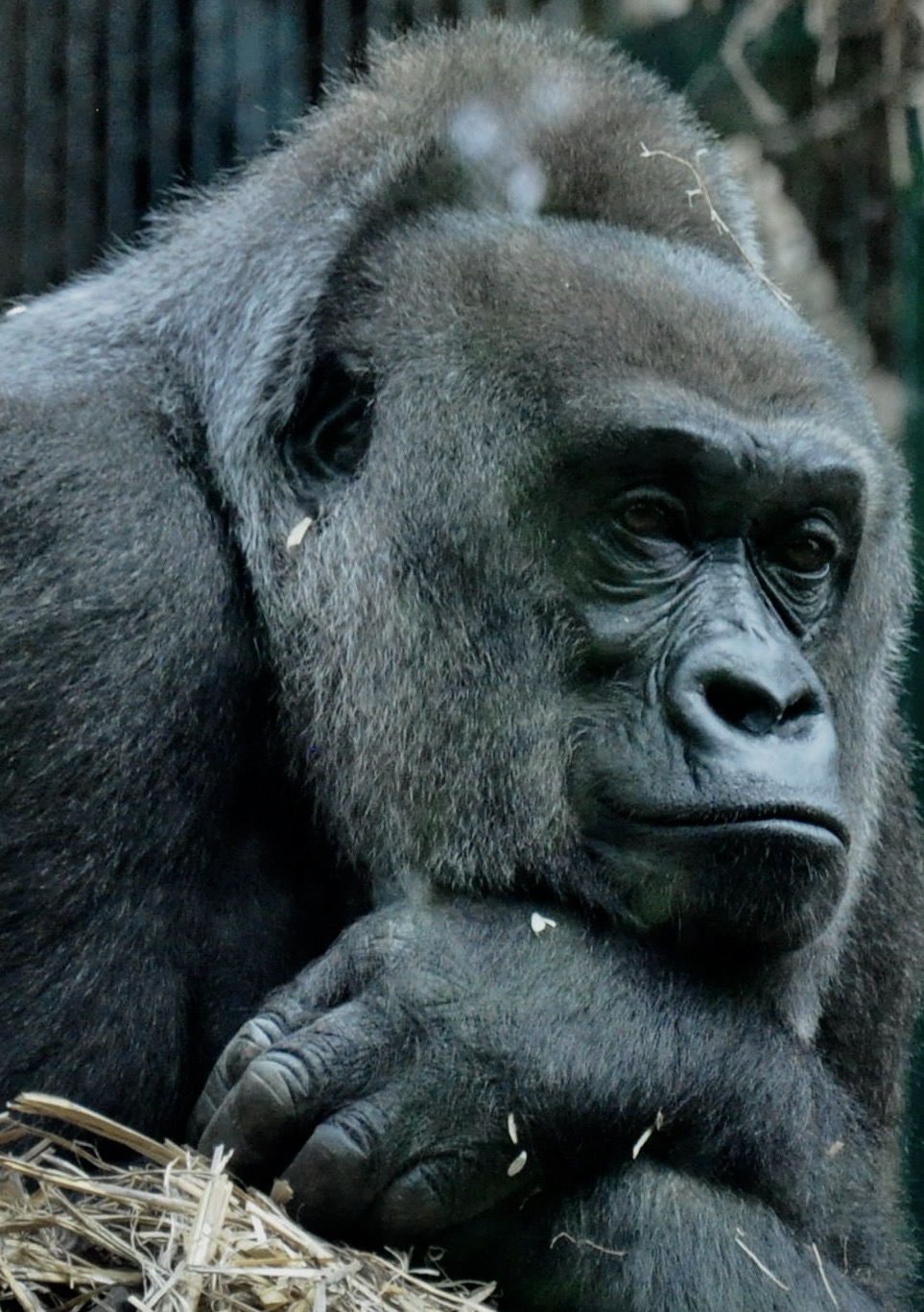
Lowland gorilla in Port Lympne safari park, Kent
I was really keen to include a primate tracking safari as part of my Uganda itinerary but knew from what I’d read online and from what others had told me that I just wasn’t physically fit enough to do a gorilla trek. Bwindi Impenetrable Forest truly lives up to its name (well, almost). The hike, which research indicated could take anything from one to seven hours depending on where the gorillas were that day, was likely to involve the thin air of high altitude, steep uphill climbs and trails wet and slippery with mud. Last April, a 63 year old French tourist lost his life after collapsing with a heart attack on the way back. Though Trip Advisor is full of gung-ho reports about porters and assistance, I decided that realistically, it wasn’t for me. Oh, and it would cost $600 in permits, though admittedly that’s a whole lot cheaper than the $1500 you’d pay across the border in Rwanda.
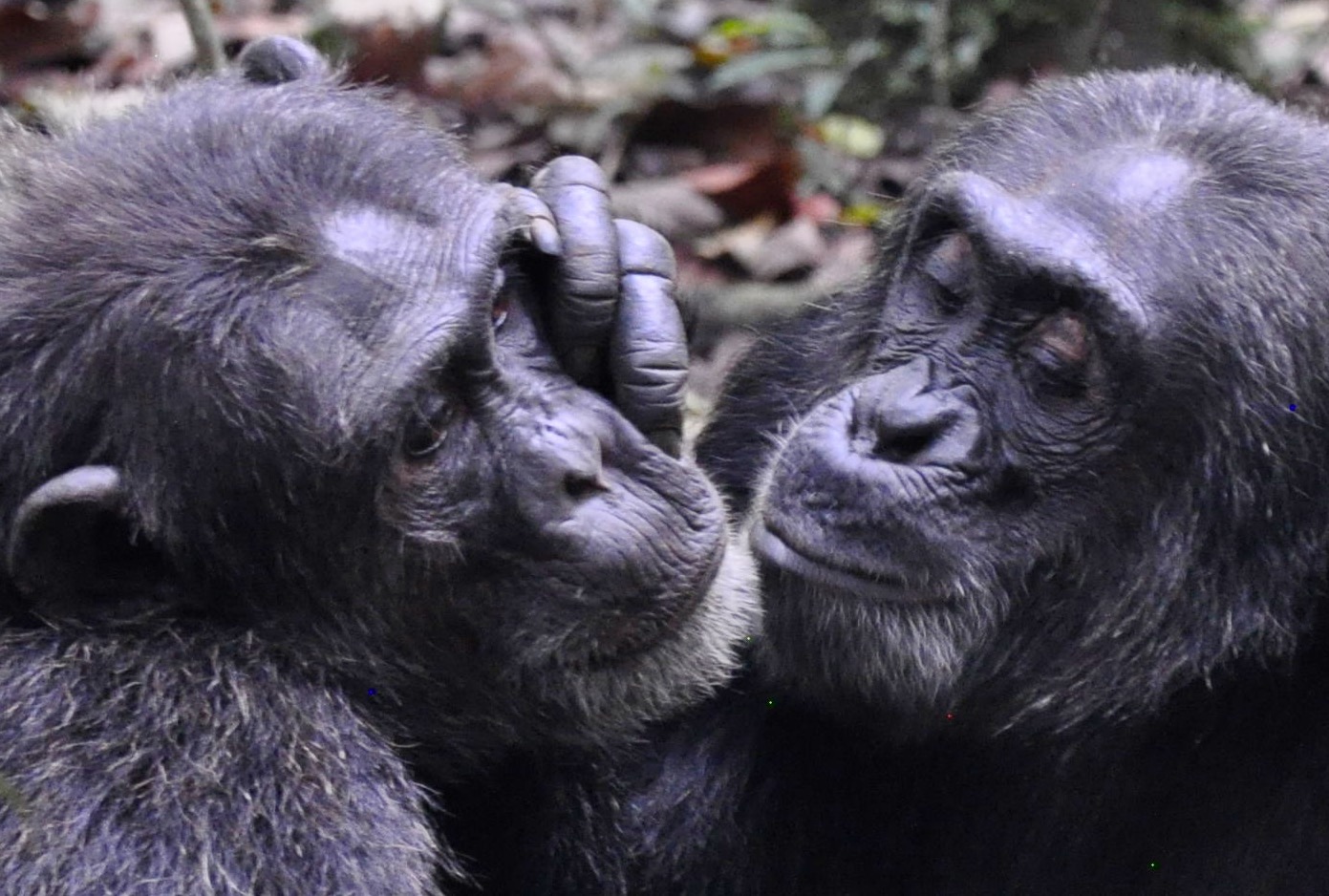
Grooming
Fortunately for me, Uganda’s primate tourism doesn’t begin and end with gorillas. While I was looking into a gorilla trek, I came across a chimpanzee tracking experience that seemed the perfect fit for me. I’d get to see primates up close but the trek, across the relatively flat forest floor of Kibale Forest, shouldn’t be anywhere near as tough. I put together a customised itinerary with car and driver provided by Roadtrip Uganda and they sourced a permit for me. It’s not wise to leave the purchase of permits until you arrive as they are strictly limited in number and you may be disappointed if they’ve sold out.
Tip: to further minimise the need for a long hike, opt for an afternoon tracking slot.

Chimps are exceptionally good climbers
As I had opted to stay overnight in Fort Portal and planned to spend the morning driving around the area’s crater lakes, I opted for an afternoon permit which would give us plenty of time to drive south to Kibale Forest. This turned out to be a wise idea. Groups go out in the morning and when the rangers come back to base, they report back on where the troops of chimps have been spotted. There’s no guarantee that they’ll have stayed put, of course, but I was told that there’s usually less walking involved in the afternoon excursions as a result. The downside is that temperatures do increase as the day wears on, though in the shade of the forest this isn’t as big an issue as you might first think.
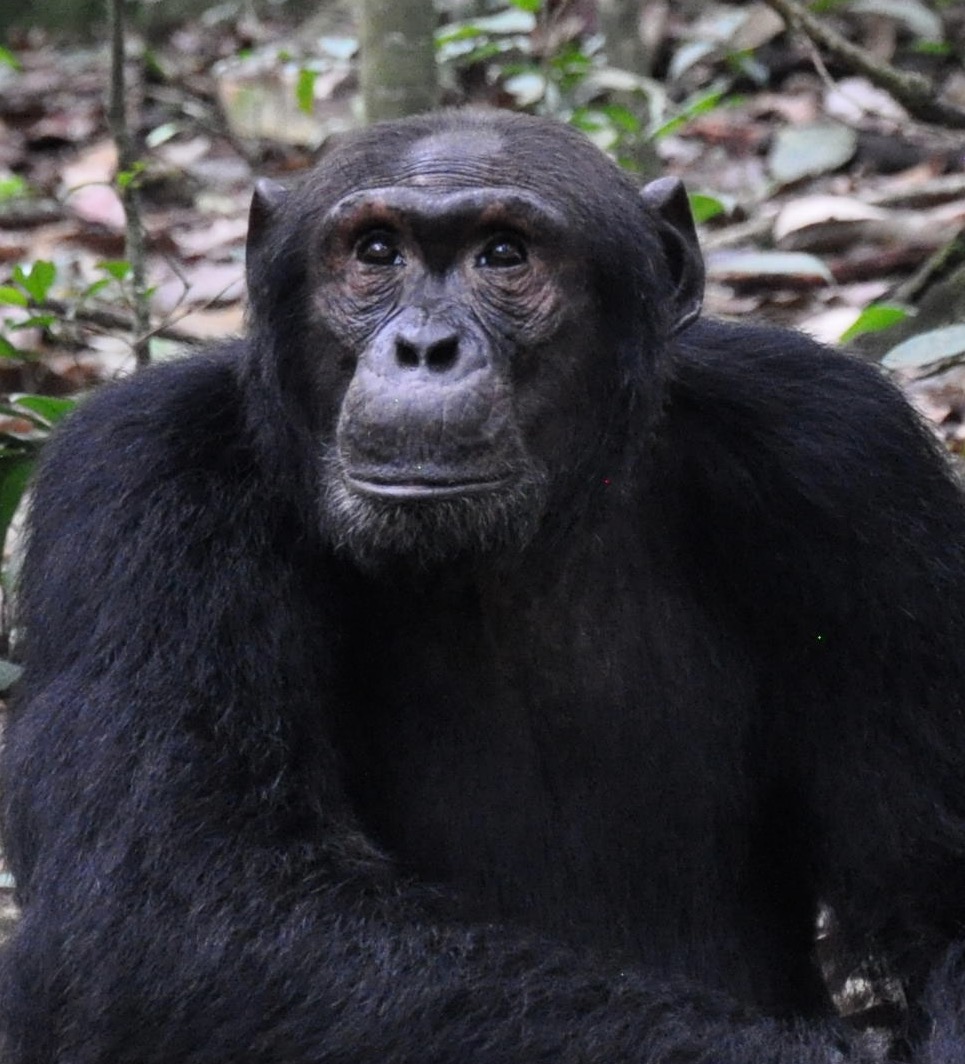
Chimps share 98% of our DNA
Our group of six met at the park office for a short briefing before our own drivers took us to the part of the forest that had been chosen as the start point for our tracking experience. Accompanying us were a ranger and also an armed guard; in the event of elephants or buffalo encroaching too close to the group, the latter would fire warning shots in the air. Before we gave our drivers a few hours off, there was another briefing. No one would be allowed to trek if unwell, the group should remain at least 8 metres from the chimps at all times and most important of all, we were told to tuck our trousers into our socks to avoid being bitten by ants. Photography was encouraged but we were to turn off the flash to avoid startling the chimps.
Three whoops of chimps (that’s the collective noun!) in Kibale Forest were habituated, that is, they’re used to being close to humans. Others are left alone. We set off in search of one of them, Benson our ranger encouraging us to hurry so we could reach the spot before they moved deeper into the forest. The pace wasn’t actually too fast, largely because we were picking our way over buttress roots and ducking under forest vegetation. Benson told us that the “hoo hoo hoo” sound we could hear was chimps calling to each other and that they were close.

The initial group
I was thrilled when we came across the first group of four – three adults and a baby – after only about fifteen minutes of walking. Benson arranged us so that we’d have a clear line of sight to the chimps without getting too close. We were the only group at that point, so the six of us enjoyed an intimate encounter and it was truly a delight. Though the baby had climbed a tree, too unsure to remain on the ground so close to us, the three adults weren’t fazed at all. Two were too focused on grooming each other to acknowledge our existence while the other rolled onto his back and closed his eyes for a snooze.
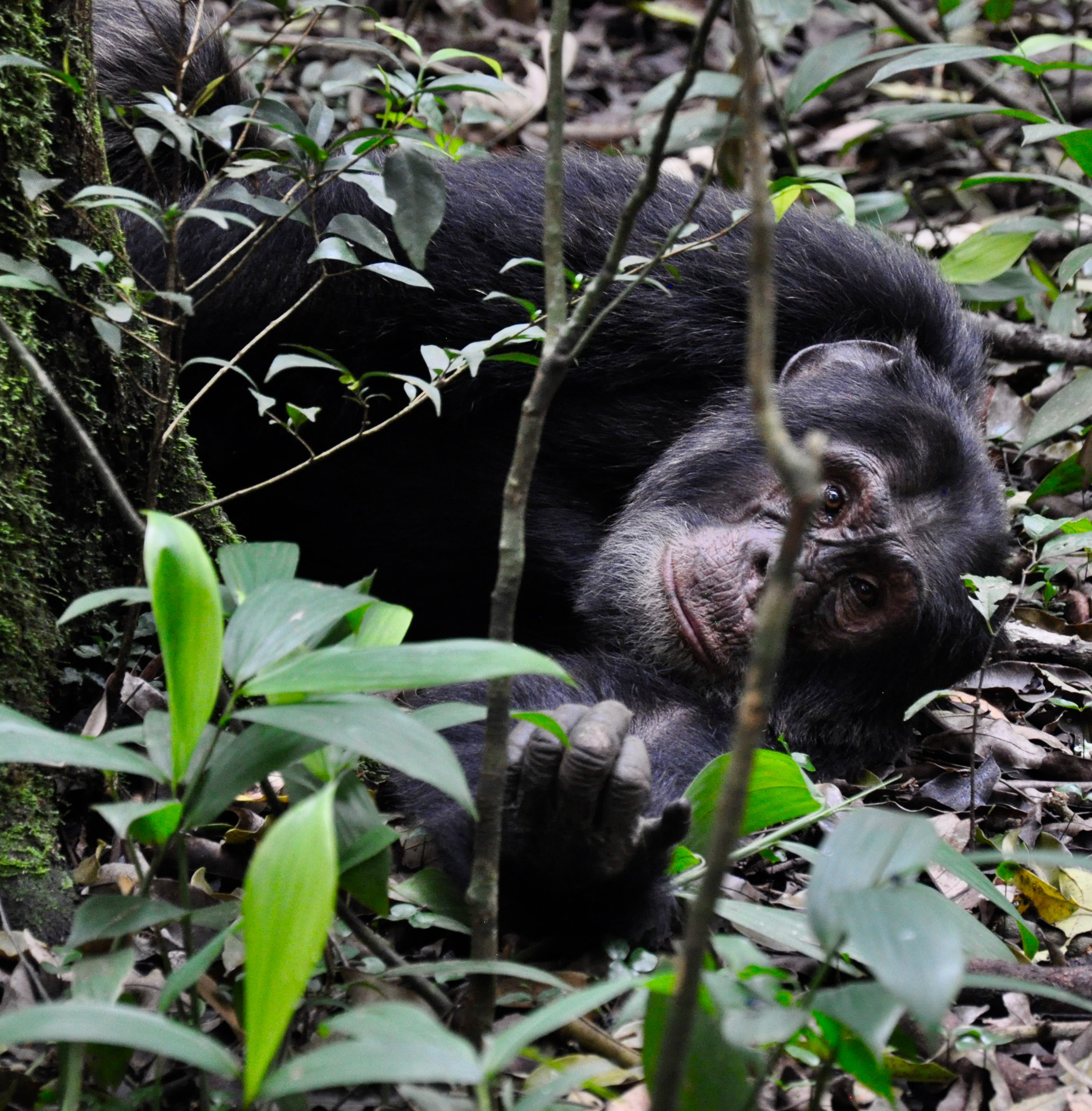
Time for a snooze
The chimpanzee tracking permit had cost $150, considerably less than that of the gorilla encounter, but still a significant amount of money. But at that point, it was worth every cent. About five to ten minutes later, another group caught us up. Benson asked us to move on so that the chimps would not be overwhelmed. We did so and and after a few minutes came across a larger group.

It’s a real privilege to be so close to the chimps
Once again, watching their behaviour was fascinating. These creatures share 98% of our DNA and many of the mannerisms are uncannily similar. We watched, transfixed, as they ate fruit, chased each other in play and swung from the canopy high above our heads. We saw their nests high in the canopy – the chimps overnight in these but prefer to hang out on the forest floor during the day. Generally speaking, it was a pleasure to be so close. The loud chatter and screams as they approached was a bit intimidating – as it was intended to be, I guessed. I think I’d watched too many Planet of the Apes films to have been entirely comfortable at this point, but Benson calmly explained what was happening and pointed out where they were which made me feel safer, particularly when they had us surrounded.
After the initial delight of seeing the chimps, I began to notice how different each were from the others. One was a proper porker – we were told he was vying for the alpha male spot and thought his extra weight might help. Some of the older chimps in the family were going grey, or balding. The youngsters, true to type, were mucking about and being put in their place by their elders. And the baby, well he was just too cute. We saw a female in oestrus, and then a bit of chimp sex up a tree after she parked her baby on the branch next to her while she got it on with her potential baby daddy. Sadly, light levels in the forest weren’t sufficient to get it on film but that’s probably just as well.
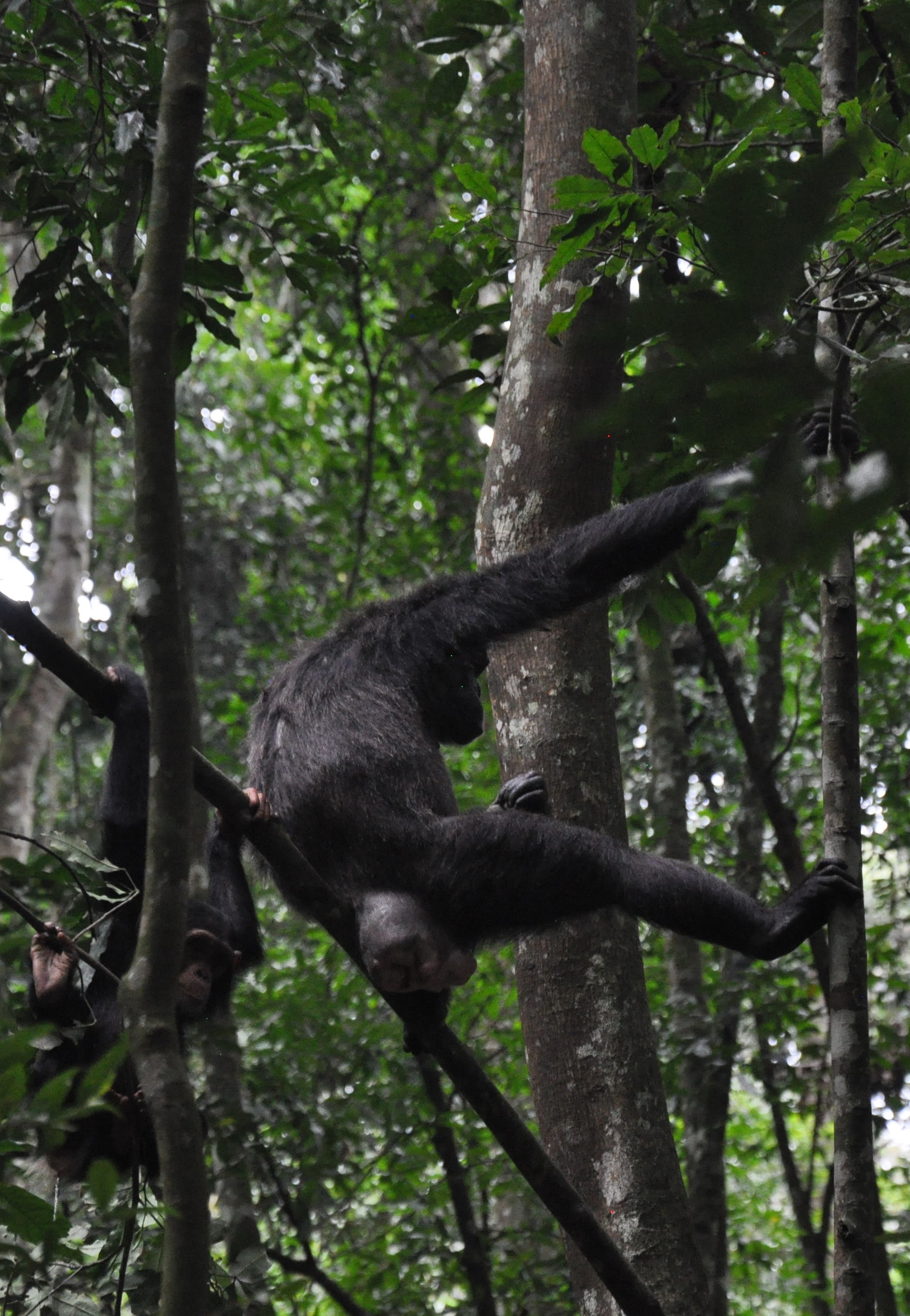
Letting it all hang out!
In all, we spent around an hour with the chimps before Benson led us on a trek out of the forest back to the ranger station. This was at a very leisurely pace, with plenty of stops to point out types of trees, birds, monkeys and butterflies. The tracking activity that I booked in Kibale Forest has about a 95% success rate of spotting chimps. This is nature, of course, and nothing is guaranteed. In all, we saw about 25 chimps. The permit cost me $150, which included entrance to Kibale National Park for 24 hours.
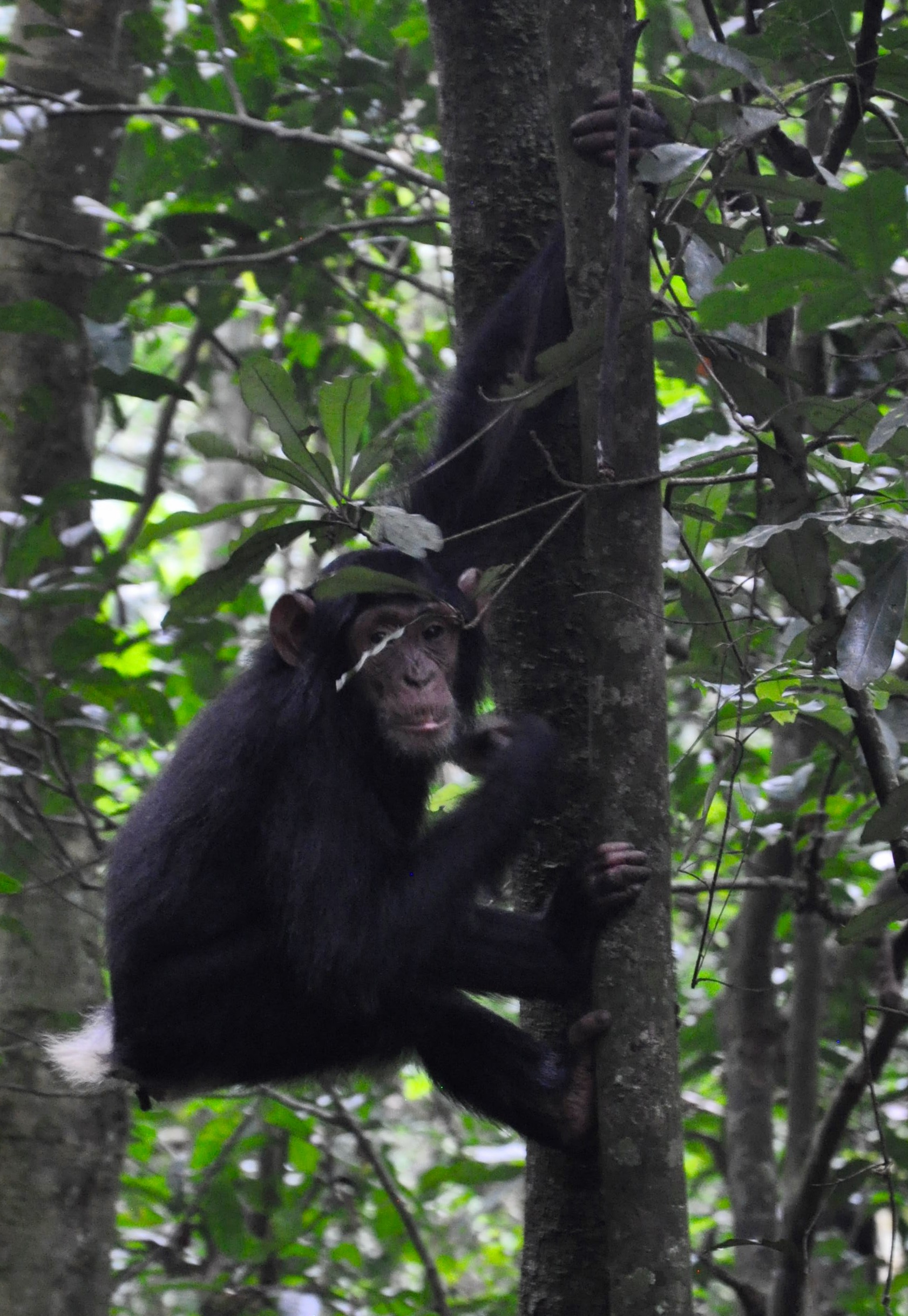
The adults were well habituated though the babies were a little unnerved by our presence
You can also try your luck spotting chimps at Budongo Forest Reserve in the northwest of the country, those living in the Kyambura Gorge at Queen Elizabeth National Park in te south and also at the Toro-Semliki Wildlife Reserve near the Congolese border. To spend longer, a chimpanzee habituation experience is offered, where visitors can spend all day in the forest shadowing researchers. This costs $200 for foreign visitors; on the Uganda Wildlife Authority website it does state half-day habituation experiences were available for $100 but I was told this was not the case. For a full price list, including prices for other areas, please use this link:
Review: Kampala’s backpackers compared
During my trip to Uganda I stayed at the three backpacker hostels in Kampala. Each was very different, so if you’re looking for cheap accommodation in the capital, my reviews might help you decide which is best for you.
Red Chilli Hideaway
The clue’s in the name with this one – it’s tucked away at the end of one of the roads leading south from Kampala’s city centre. It’s as much a resort as it is a hostel, with a sizeable swimming pool as well as two bars. Day guests can pay for the use of its facilities, but it retains a backpacker vibe nonetheless. Staff are helpful and efficient.
The location is both Red Chilli’s biggest plus and its worst drawback. Because it’s so far out of the centre – around 10km from downtown – it’s inconvenient if you intend to visit the city’s sights. Traffic is horrendous, so that 10km journey can easily take an hour or more of frustrating stop-start driving, more in rush hour. If you’re coming into the city on a tourist shuttle such as Pineapple Express, note that drop off will be at the Oasis Mall, still a considerable distance from Red Chilli.
That said, if you’re looking for a place to unwind as part of your Ugandan or East African trip, it’s the perfect spot. Security’s excellent – all cars entering the compound are checked thoroughly, with mirrors used to check the underside of the vehicle. Guards on the gate are also a reassuring presence in this relatively remote location. The views across the valley to the surrounding countryside further distance you from the hubbub of the city and it’s a surprisingly peaceful place. Sunrises are spectacular and well worth rising early for.
The multiple accommodation blocks contain a range of room types, from dorms to private ensuites. The latter are roomy and are equipped with fans and showers that actually deliver hot water. I slept well, cocooned from the noise of those socialising in the bar. The room was basic but clean.

Red Chilli Hideaway is the sister property to Red Chilli Rest Camp up at Murchison Falls. I took the three day budget safari, which costs $320pp in shared tents and about $80 extra if you upgrade to a self contained banda. It was well organised and well thought out, and though the distance travelled was considerable, the two included game drives and boat trip made the package excellent value for money as well. The safari price includes a free dorm bed the evening before – it’s definitely a good idea to stay in order to avoid a ridiculously early start just to reach Red Chilli itself.
Would I stay there again?
Yes, if I was looking for a place to stay put rather than get around.
Cost of a single room with ensuite bathroom $45 with a discount for booking the safari – I paid $33 (note that prices have recently risen)
Bushpig
If you’re looking for a sociable backpackers then this is the pick of the bunch, but I also found it to be the noisiest of the three. Located on busy Acacia Avenue, there’s a constant buzz of traffic as well as considerable noise from the immediate vicinity – bells ringing when people asked to be let in and chatter for instance. My single room was tiny, the bed taking up the whole of the window side of the room, making it difficult to access the window. There was a small hole in the glass, so even with the window shut, it wasn’t remotely soundproof, though mesh and a mosquito net ensured I wasn’t bothered by the bugs.
The showers and toilets were in a room a few doors down the corridor. They were clean and the water was hot. I rented a towel for 4000 shillings (a little less than £1). However, there was no door to the bathroom itself and (unlike the rest of the rooms in my section) my room had mesh above the door rather than a solid wall. The noise from flushing toilets and running water was therefore bothersome. I managed about three hours sleep which wasn’t ideal.
Where Bushpig scored highly was in its food. There was an outdoor bar with tables. An extensive menu sold really tasty food at reasonable prices and it was a popular place to entertain friends as the number of visiting diners indicated. Staff were approachable and helpful. The manager went out of his way to get me connected to the WiFi when my devices were being uncooperative and it proved to be the speediest once I was online. Also, the reception staff helped me figure out the location of the relocated Post Bus service as well as sort me out with a reliable taxi.
Would I stay there again?
Probably not, on account of the noise, though it was a temptingly convenient location. However, I would definitely visit for the food and atmosphere in the bar garden.
Cost of a single room with shared bathroom $25, which represented the best value of the places I stayed
Fat Cat
Occupying a site in a quiet side street close to Acacia Mall, this backpackers had the most convenient location. It was the smallest of the three and felt the most basic. My single room was directly off the main dining room, which could have presented a noise issue had there been more guests, but in fact I got a good night’s rest. Staff were efficient, and my driver for the late night airport transfer was waiting for me outside Entebbe Airport. However, I didn’t get the sense that they were especially bothered if I was enjoying myself and came across as a bit bored by the whole customer service thing.
The shower room was very basic. The cubicles were fairly clean but the windows and walls were grubby and there wasn’t much space to hang clothes or a towel while you showered. The water was almost cold, adding to the monastic feel. Though it was dearer than Bushpig, the room was larger, but the facilities were definitely a lot more rundown and in need of modernisation. I only ate breakfast here, and that too was basic. There was a lounge and several traditional hostel noticeboards where you could post requests for shared rides and the like.
I did like the garden area, which was a tranquil spot to sit and enjoy a drink with plenty of shade. You could qualify for a free beer if you went litter picking in the vicinity of the backpackers. Just outside the gate, Uber bodas (motorcycle taxis) congregated and I had no difficulty organising an Uber car and driver when I needed to go into the centre of the city a short distance away.

Would I stay there again?
Possibly. Despite it being the most basic, it functioned well and its proximity to the Acacia Mall and a number of cafes and restaurants helped.
Cost of a single room with shared bathroom $34, a little steep given the quality but admittedly reflecting that it was significantly larger than the room at Bushpig.
Moldova’s National Wine Day
Moldova celebrates its National Wine Day over the first weekend in October. If you want to sample wines from the country’s many wineries without putting in the legwork, this is your chance. Representatives from the major labels come to the capital Chișinău and set up beside Cathedral Park. The organisers even offer a wine tasting passport with tour guide to provide key background information should you wish to know a little more about what you’re drinking.

Getting there
From the UK, there are pretty much two direct options: Air Moldova from Stansted and Wizz Air from Luton. (I also found an airline called FlyOne, but it didn’t seem to be operating flights at this time of year.) When I booked, the Wizz Air option was significantly cheaper but did have the disadvantage of flying overnight on the outbound leg. If you’re going to do this one, hope that your hotel will allow you to check in early or prepare to take an afternoon nap. That’s of course if like me you’ve reached the age where staying up all night is no longer a good thing.

Getting around
There’s a convenient trolley bus which departs from right outside the arrivals terminal door. It takes about half an hour to get into the city centre and costs just 2 lei, about 10p. Look for the number 30 and pay the conductor on the bus. If you need to find change, there are exchange facilities that open early in the morning landside; I bought a cup of coffee which gave me somewhere warm to wait for the bus and the right money to buy a ticket. It was a little disconcerting when the bus stopped and the driver got out; I’d forgotten that trolley buses are a lot of effort when the wires don’t extend the length of the route. What was good, though, was that the buses ran from very early in the morning until late at night, even on Sunday.
Getting a room
I opted for the almost brand new City Center Hostel. It was located just across the road from Cathedral Park and around the corner from the bus stop. My room had twin bunks and for single occupancy cost just £27 for the night. The shared bathrooms were down the hall but were spotless. If you can’t bring yourself to stay in a hostel, next door is the conveniently located Bristol Central Park Hotel and opposite is the Radisson Blu. Both I’m sure are very nice but would set you back a whole lot more.

Getting your culture fix
I’d read that there was a parade and early signs were promising. There were plenty of people in national costume and in front of the big sound stage, rehearsals were still in full swing just minutes before the action was supposed to kick off. I was able to get close enough to see the dancers, which was fortunate as once the formal proceedings began, some rather surly security personnel did a very good job of keeping everyone right back out of the way. The view was further obstructed by press photographers and cameramen. There were no programmes in English, but this lady had brought her own from the local newspaper – no help to me, alas:

Though I did manage to see some of the winery representatives presenting their baskets of grapes, this part of the proceedings was something of a let down. However, later, once all the dignitaries had said their piece, the bands came on and the dancing started – fun to watch and even more fun to join in. The event’s free too, which was even better.

Getting drunk
With a tasting passport costing just 200 lei (£10), it’s hard to resist the chance to try as many of the wines on offer as you can. I made my way to one of the information kiosks (they’re located at either end of the main drag) and grabbed a place for one of the English speaking tours.

Our guide was as hipster as they come, but explained the different characteristics of the wine well at first. As the afternoon wore on, he became progressively more tipsy (like the rest of us) and at one point dropped a bottle of wine on the floor in front of him.

Some of the wines were too dry for my taste but I did enjoy the Cricova sparkling wines. I’m no connoisseur – the sweeter and fizzier the wine, the more I like it. Fortunately, the passport contained an extra token for “your favourite” wine so I had a second glass. It was a pity there are such stringent regulations at airports these days as I’d have liked to buy some to bring back.
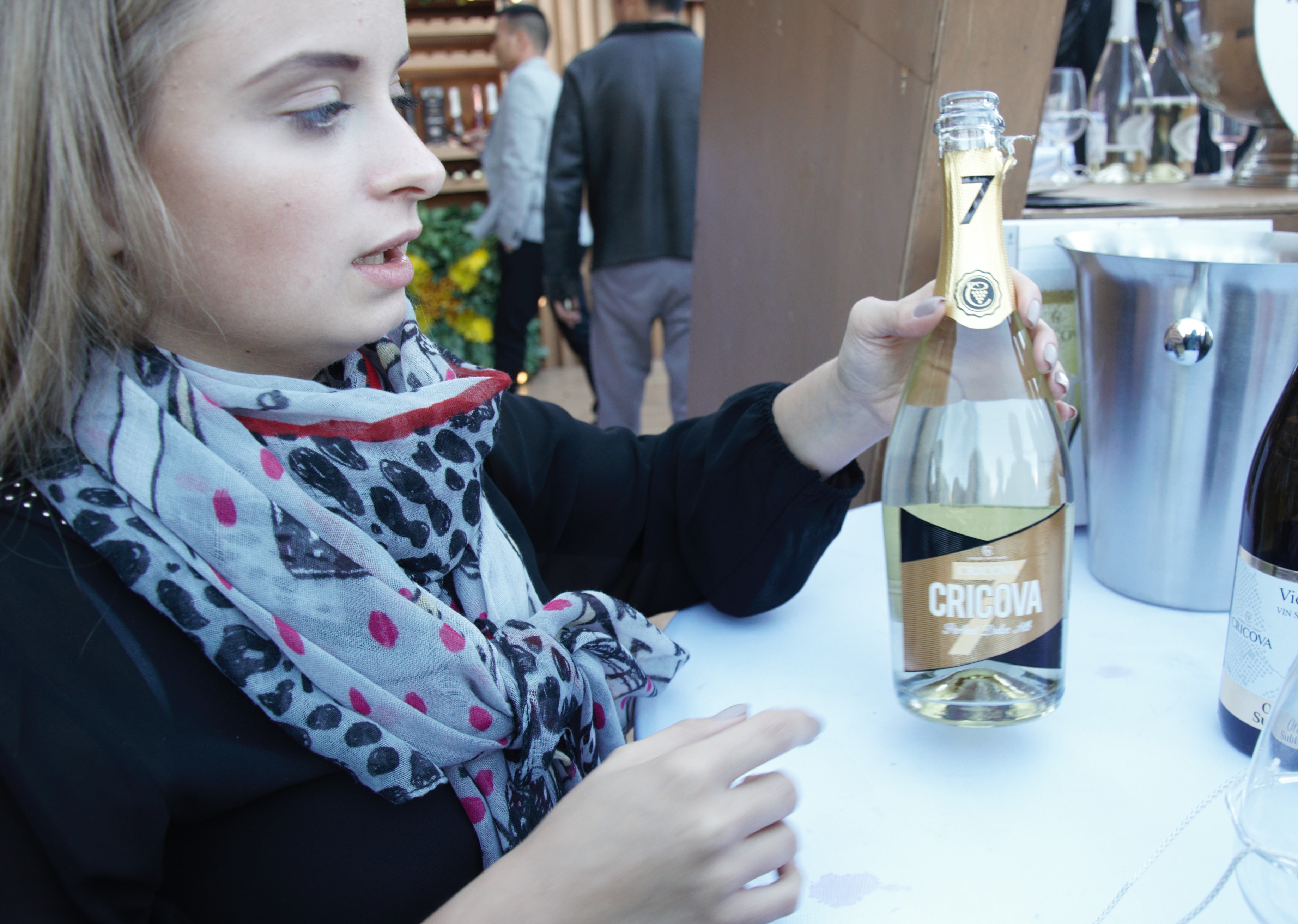
By the way, if you are going to visit one of the wineries outside Chișinău, I’d recommend Mileștii Mici. Its huge underground vault can hold almost 2 million bottles of wine and its subterranean rooms and passageways extend for around 120 miles. They run organised tours so there’s no need to worry about getting lost down there forever.
Getting food
Fortunately, there was plenty of opportunity to taste the local food as well, which helped to soak up a little of the alcohol I’d consumed. Adjacent to the wine stands are the food stalls. Many sold similar fare: succulent pork, tasty sausage, cabbage and potatoes. A lot of the stalls sold by weight; you indicated roughly how much they should pile on your plate and they told you how much you owed them. I had a heaped plate for about 75 lei, which worked out to under £4, and it was delicious. Communal tables mean it’s easy to make friends while you eat.
Getting to see more of the city
As I was visiting Transnistria, my time in Chișinău was limited. I did get to see the city’s smallest statue. Representing the Little Prince in Antoine de Saint-Exupéry’s novella, it took a while to locate, not least because someone I asked for directions Googled it and found an old article which said it was yet to be installed. It’s on the railings lining the lake in Valea Morilor Park – persevere and you’ll find it.

I also had a wander around an open air museum outside the city centre on the airport road; there was a wedding taking place so I didn’t have the chance to go in the wooden church. I finished up at the Ciuflea Monastery. Despite being close to the main road, it was remarkably peaceful.
Why do countries change their name?
This week, I read in the news that the King of Swaziland has decreed that the country’s name will henceforth be known as eSwatini. He’s been referring to it as such for many years but this pronouncement, carefully timed to conicide with the kingdom’s 50th anniversary of independence makes it official.
The name means “land of the Swazis” and you’re probably thinking that it’s not so far removed from “Swaziland”. The king would beg to differ. Allegedly he’s fed up with people confusing his tiny landlocked country with another, larger landlocked country: Switzerland. And the country didn’t change its name on independence, so better late than never, you might say. Regardless, as eSwatini is an absolute monarchy, the name will stay, though it has angered some in the country who say the king should have better things to focus on – like their beleagured economy for instance.

It brought to mind the announcement from the Czech Republic a couple of years ago that they’d prefer we shortened the country’s name to Czechia. The Czech Republic form would stay, but to make advertising easier, Czechia should be used if people wanted a catchier moniker. But too many people think it sounds like troubled Chechnya and the name isn’t sticking. Hungary tried something similar a few years earlier, in 2012, officially becoming Hungary after being the Hungarian Republic. I’d been calling it by the wrong name all those years.

Cape Verde officially altered the English version of its name to the Republic of Cabo Verde in 2013, though if you book a holiday to the islands, most UK agents still refer to it as Cape Verde. Changing your name is one thing. Getting others to follow suit is another thing entirely.
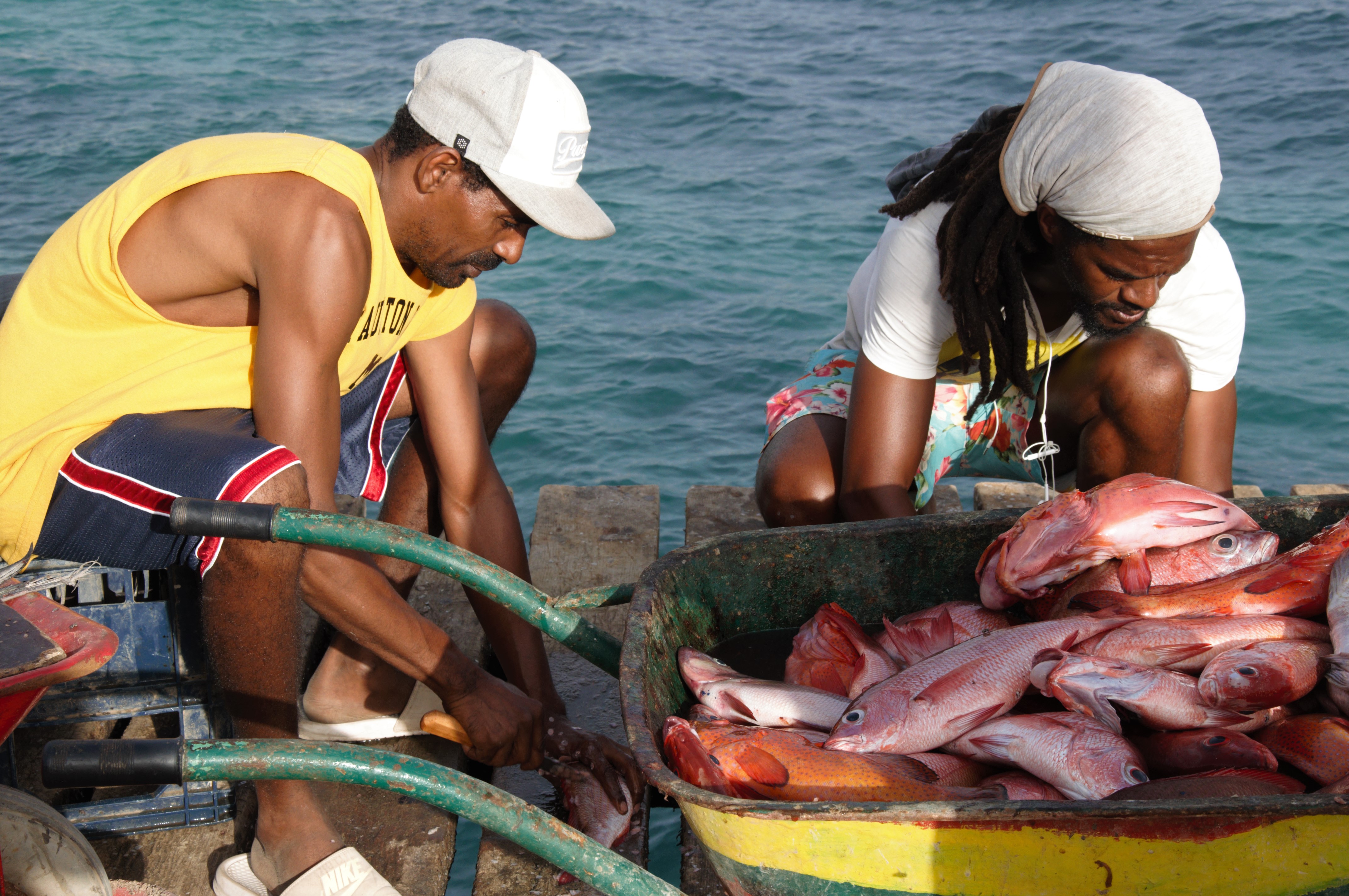
Often, the act of changing a country’s name comes with independence as part of a wider declaration that the country is now in charge of its own affairs. Until 1825, Bolivia was Upper Peru, Dahomey became Benin in 1975 and Upper Volta changed its name to Burkina Faso in 1984. Sri Lanka had been Ceylon until 1972 while Siam became Thailand in 1939 – and save for a short period in the 1940s it’s been Thailand ever since. I could go on.

Splits and mergers are another common reason for name changes. The island of Zanzibar merged with mainland Tanganika to form Tanzania on independence in 1961. Malaya and Singapore combined with Sabah and Sarawak to become Malaysia in 1963. However, thanks to a memorable ad campaign, it will always be Malaysia Truly Asia to me. In the splits camp, Czechoslovakia divided into the Czech Republic and Slovakia in 1993. Yugoslavia collapsed in the 1990s, spawning Croatia, Serbia, Bosnia & Herzegovina, Slovenia, FYR Macedonia and Montenegro.
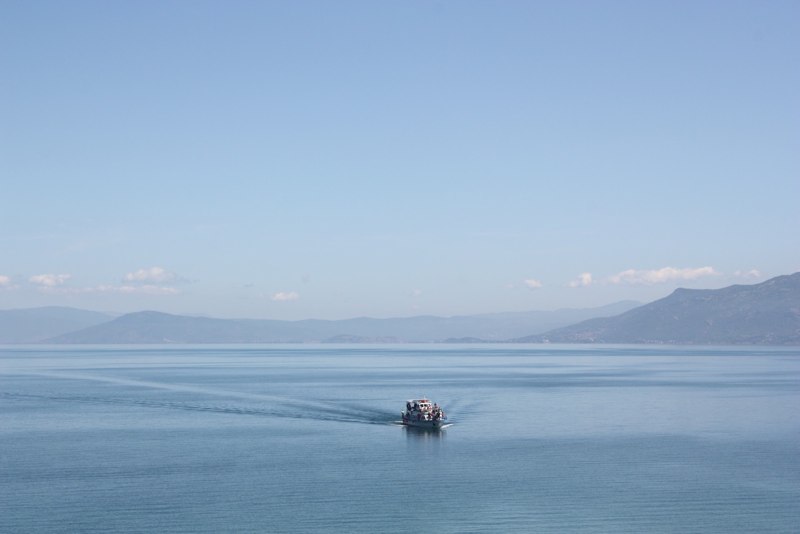
Sometimes the changes can happen so often that people can’t keep pace. Take the Democratic Republic of Congo, for instance. It was the Congo Free State in 1884, then Belgian Congo in 1908; the Republic of the Congo in 1960 before adding Democratic in 1964. Then in 1971, it became Zaire under Mobutu before reverting to the Democratic Republic of the Congo once more in 1997. And just to make matters more confusing still, the country next door now calls itself Republic of the Congo.

Now the Kazakh president Nursultan Nazarbayev has thrown his hat into the ring as well. He suggests that the suffix -stan doesn’t have the best connotations when it comes to attracting investment, thanks to some politically troubled neighbours. He proposes perhaps Kazak Yeli or “country of the Kazakhs”. The country’s ethnic diversity doesn’t make this an easy switch. Only time will tell how that one pans out.
On the trail of the mob in Havana
The classic American automobiles that cruise the Malecón ooze the glamour of bygone days, but 1950s Havana had a seedy alter ego. Mob-run casinos drew a decadent crowd. Vices of all kinds took centre stage. Traces of this era of such excess can still be seen today – if you know where to look. Curious, I contacted Havana Super Tour and asked guide and founder Michael Rodriguez to let me in on a few of Havana’s dark secrets. Waiting to take us back in time was an immaculate silver grey Pontiac driven by owner Ricardo. Michael joked that Cuban men value their cars more highly than anything else in their lives – even their women. I’m not convinced that’s true of only Cuba.
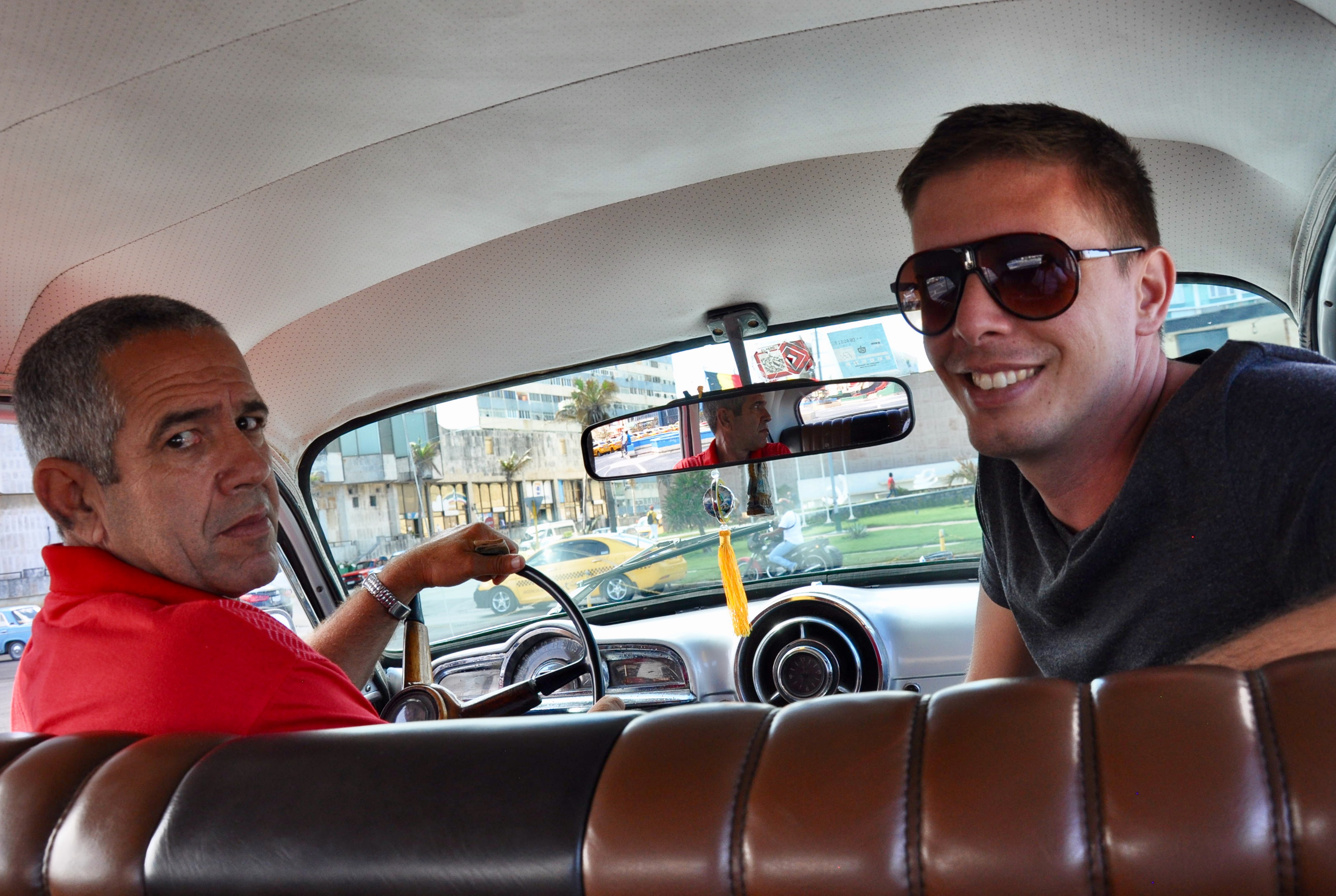
We began where the charmingly decrepit mansions of Habana Vieja give way to the boulevards of Centro. Gambling is banned in today’s Cuba, but the old casinos have been repurposed as conference rooms and elegant salons in many of the capital’s most renowned and once notorious hotels. One of them is the historic Hotel Sevilla. I’d stayed there during my first visit to Cuba fifteen years ago and around the corner from the exquisite Moorish-style lobby where I’d once checked in is a rogue’s gallery of past guests – good and bad. This time my focus was on the latter. Michael steered me towards a photograph of Al Capone, perhaps Chicago’s most notorious gangster, who used to book out the entire sixth floor when he was in town. Privacy comes at a price when you need to make sure no one eavesdrops.

Michael led me across the street to a tiny store selling antiquarian books and other memorabilia from times past. Leafing through a folder of old black and white photos, he showed me how some of the Cuban capital’s hotels would have looked in Batista’s day and in the years immediately following the overthrow of his government. The city was the place to see and be seen. Hollywood’s biggest names came in their droves with Frank Sinatra leading the pack. Scandal was never far away. Michael reckoned that despite rumours that Sinatra’s singing career had initially been financed by the mob, he was clean – in Havana anyway. Some of his associates, however, were not.

The biggest player of all on the Havana mob scene was an East European Jew who’d come to the USA to reinvent himself. Smart as they came, Meyer Lansky grew up in New York with Lucky Luciano. Lansky was the brains to Luciano’s brawn and together, they made a formidable pair. You messed with them at your peril. Having operated out of the Nacional for years, Lansky had his hands in a number of other businesses, including the successful Montmartre Club which was eventually torched by a revolutionary supporter in the early 1960s.

Over a Mafia mojito at the Nacional. Michael told me that it was common for a Hollywood name to provide a respectable front for the money laundering, shady deals and violent altercations that were going on behind the scenes. Actor George Raft got his big break in the 1932 gangster movie Scarface. When New York mobster Santa Trafficante Jnr. opened the Capri, he needed someone to be its respectable public face. But though it was commonly held that Raft owned a sizeable stake in the hotel, Nicholas Di Costanzo, Charlie “The Blade” Tourine and Santino “Sonny the Butcher” Masselli operated it. It doesn’t take a genius to work out that many of the regular clientele were anything but legit themselves.

Lansky himself opened the Riviera Hotel in 1956 as a front for his deals. It was one of many businesses through which he could launder his ill-gotten gains. Though he claimed Cuba ruined him when Castro rolled into Havana, under Batista’s regime he’d lived like a king. Despite decades of ruling the organised crime roost, the only crime the authorities ever managed to pin on him was a charge of illegal gambling.
The Riviera, our last stop, could have been a set from the hit US TV show Mad Men, had US-imposed sanctions not restricted where the studio’s dollars be spent. Mid-century modern might be back in vogue, but you’ll be hard pressed to find somewhere where the fixtures and fittings are as original as the furnishings. Walking through the doors of the Riviera Hotel was like stepping back in time, its 21st century patrons sticking out like a sore thumb in their modern apparel. Its casino was now a meeting room, the showy chandeliers the only clue to its dazzling past.

Out back the pool had a turquoise diving board that just needed a girl with an hourglass figure and a red halter neck bathing suit to complete the picture postcard shot. Instead, an elderly lady with a white swimming cap and cellulite for thighs glided at a leisurely pace through the sunlit water. Michael suggested I took a closer look at the shape of the pool which had been constructed, aptly macabre, to take the form of an open coffin.
This is a chapter of Cuba’s history that is overshadowed by Che Guevara and Castro’s revolution, but it’s no less compelling. After Batista was kicked out, Havana under Fidel’s leadership cleaned up its act. But there’s still plenty of tangible evidence to make this a fascinating tour and if you want to see a side to Havana many travellers miss, then this is most certainly it. It’s one thing reading the story, but nothing compares to standing in the same spot of some of the 20th century’s shadiest characters.
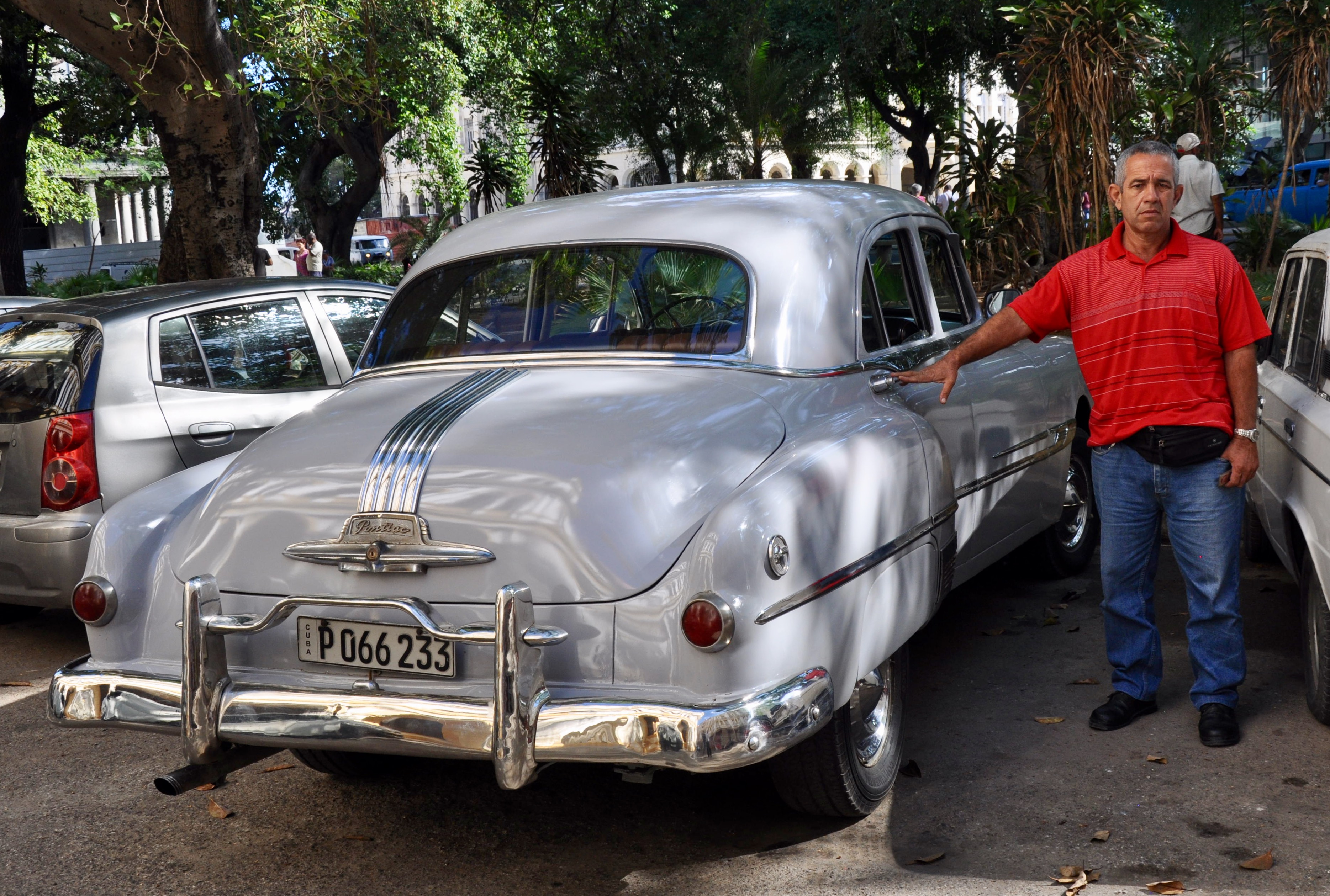
About HST
Havana Super Tour is a rarity in Havana, a privately run enterprise which specialises in subjects as diverse as Art Deco, architecture, African religion, art or Hemingway. Alternatively, work with Michael and the HST team to design a bespoke tour to suit your own interests. Your classic car leaves from Casa 1932 at Campanario 63, a couple of blocks from the Malecón in Centro. The highly recommended Mob tour costs 35 CUCs per person, minimum two people, with transportation in a vintage automobile of course. Contact HST by email at elandarincarvajal@gmail.com or visit their website at:
The views expressed in this piece are my own, though I’m grateful to HST for offering me a private tour for the price of a group outing.
How the cost of attractions compares
I shared a video from BBC Wiltshire this week on my Facebook page. It reported that the cost of visiting Stonehenge is set to increase this April. Individual adult admission will rise from £16.50 to £19.50 while the cost of a family ticket will go up from £42.90 to over £50. Is it worth it, I asked, and the answer was almost universally no. So how does the cost of visiting Stonehenge compare with other world famous attractions?
The Pyramids

General entrance to the Pyramids complex costs just 120 Egyptian pounds (under £5) but that doesn’t permit you to go inside the pyramids themselves. To get into the Great Pyramid it will cost a further 300 Egyptian pounds – if you’re lucky enough to get one of the 150 permits available each morning or afternoon. Entrance to the smaller pyramids is rotated so only one is open per day; it costs 60 Egyptian pounds on top of the general admission to go in.
Machu Picchu
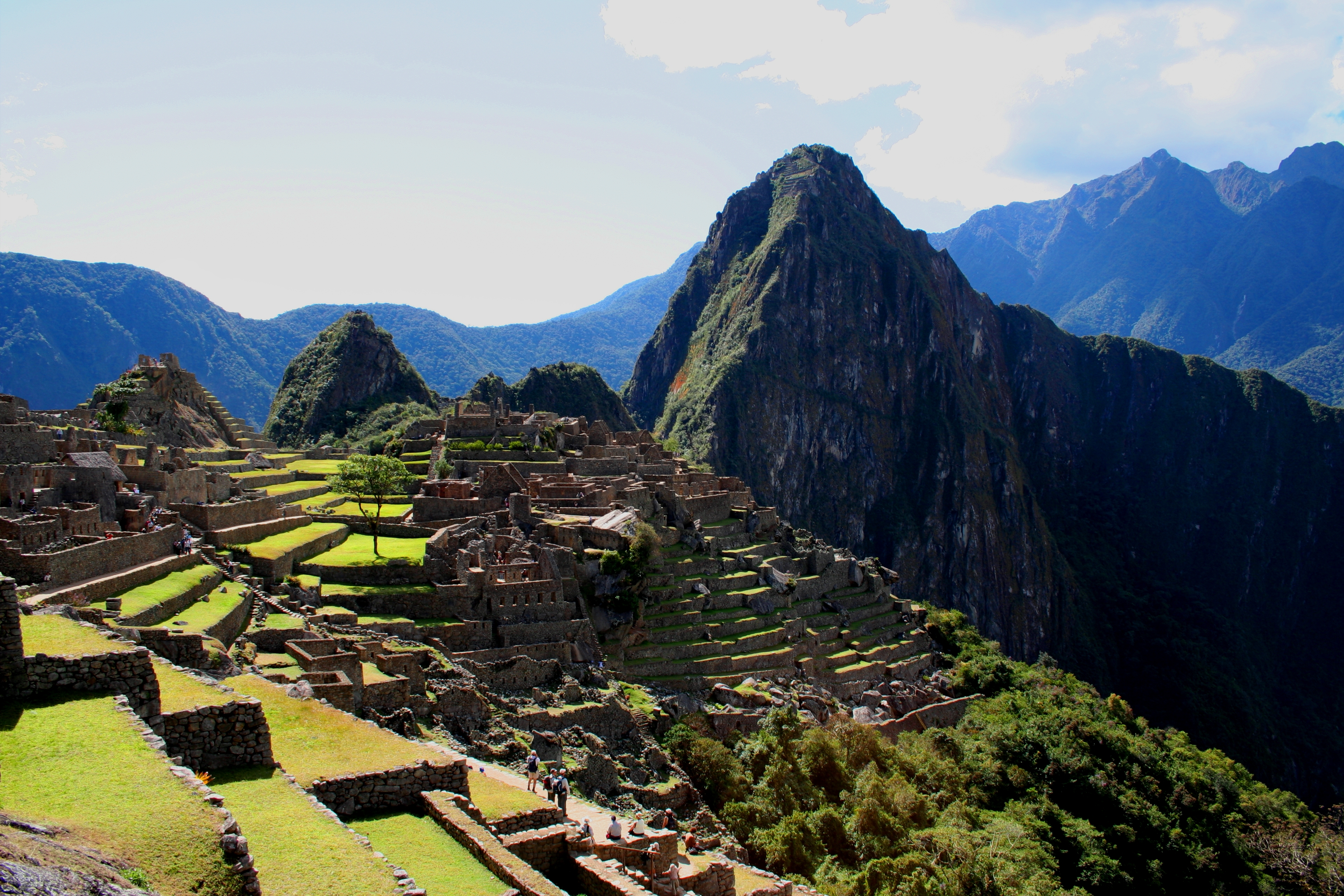
Entrance to Machu Picchu is being more tightly regulated by the Peruvian authorities in an attempt to manage visitor numbers. Tickets are timed and cost a foreigner 152 soles, about £33.80. Peruvians can enter for 64 soles (£14.20), as can nationals of the Comunidad Andina – Bolivia, Ecuador and Colombia. You’ll need to pay extra if you’re aiming to climb Huayna Picchu. Even with the limits now imposed, it’s still a must-see while you’re in Peru.
Petra

Tickets cost 50 Jordanian dinars for a one day ticket, though subsequent days are significantly cheaper. Two days will cost you 55JD and three will set you back 60JD. To qualify, you have to be able to prove you are staying overnight in Jordan, or the price becomes 90 JD. £1 will get you around 1 JD, so a visit to Petra makes Stonehenge look cheap. It’s better value, however, as there’s so much more to see, from the iconic Treasury to lesser known sites.
Angkor Wat
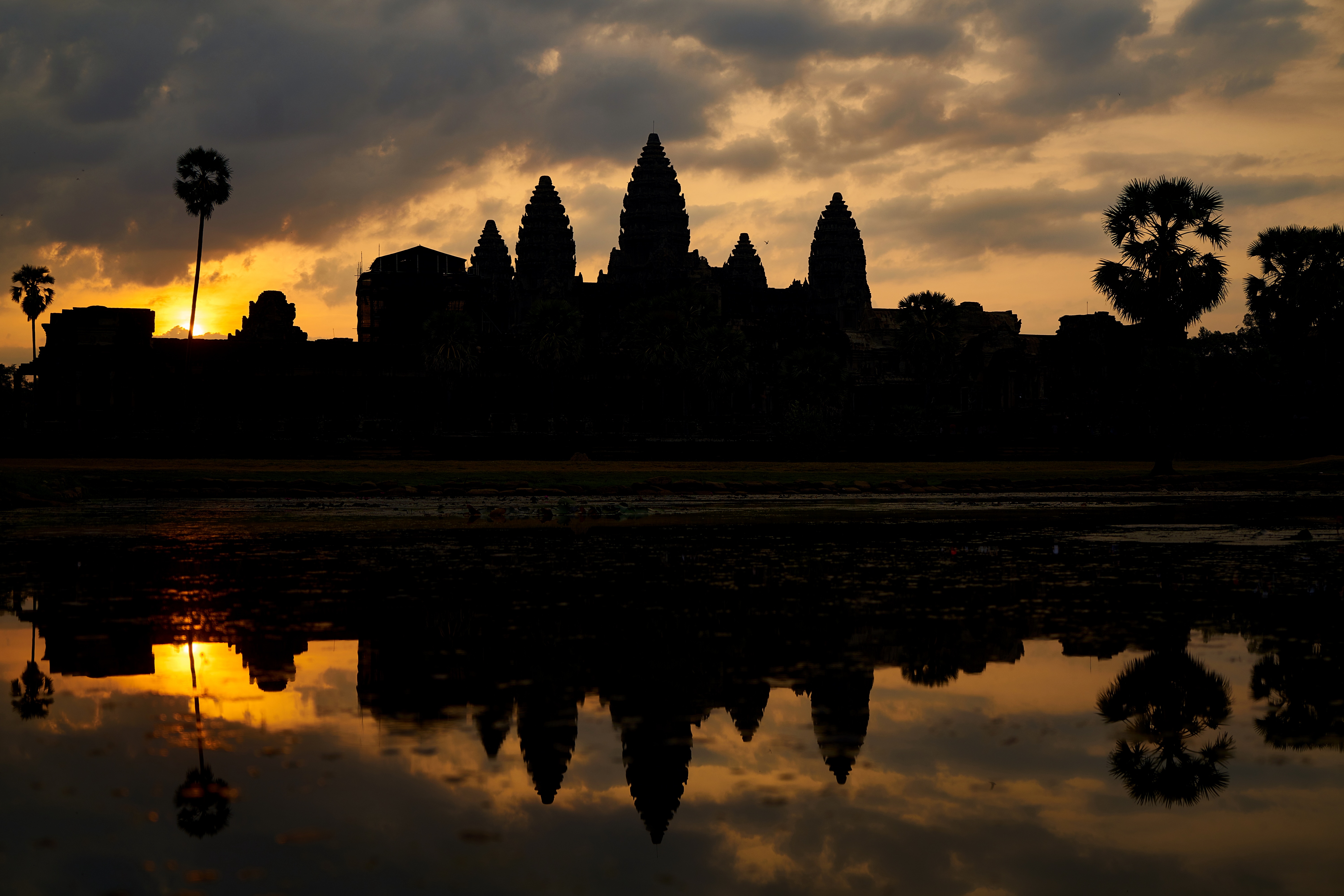
Before you fork out for Cambodia’s premier attraction, you’ll need to decide how many days you’ll need to explore the vast Angkor archaeological complex. Passes are sold in one day ($37/$26.40), three day ($62/£44.30) and seven day ($72/£51.50) blocks that have to be used on consecutive days. You’ll also have to have your photo taken but this is free. Three days is about right to see the main sights.
Empire State Building

The Empire State Building
Most visitors to the Empire State Building are content with an ascent to the 86th floor viewing platform. Adult tickets for this currently cost $37 (£26.40). To combine the 86th floor with the top deck on the 102nd floor, the price rises to $57. Seeing the sunrise will set you back $100 though you’ll need to snag one of only 100 tickets. A combo ticket for day and night (reentry after 9pm) is $53, so time your visit for sunset to avoid this surcharge.
Taj Mahal

Getting into India’s most famous visitor attraction, the Taj Mahal, will set back foreign visitors 1000 rupees, the equivalent to about £11.20. Costs are approximately halved for citizens of SAARC countries (Bangladesh, Nepal, Bhutan, Sri Lanka, Pakistan, Maldives and Afghanistan) and BIMSTEC Countries (Bangladesh, Nepal, Bhutan, Sri Lanka, Thailand and Myanmar), while domestic visitors pay 40 rupees (about 45 pence).
Eiffel Tower

The cost of reaching the top floor of the Eiffel Tower varies according to your energy levels. Take the elevator and it will set you back 25 euros (about £22). You can save 6 euros off this cost if you are prepared to climb the stairs instead. Satisfying yourself with a partial ascent is another way to keep your costs down – 16 euros and 10 euros for lift or steps respectively gets you to the second floor.
Have you visited any of these attractions? Were they worth the price of the entrance fee?
A beginner’s guide to Marrakesh
Its nicknames include the Red City and Daughter of the Desert, but the origin of the name Marrakesh is thought to come from the pairing of two Berber words, mur and akush, which mean Land of God. You’ll see it written as Marrakech, also, as this is the French spelling. This beguiling city is an easy weekend destination from the UK and captivates the visitor with its exotic easygoing charm. Here’s what you need to know if Morocco’s famously intriguing destination is calling.

Getting there
Many UK travellers head to Marrakesh on a direct flight with easyJet or Ryanair. Fares can easily be found for as little as £50. Don’t be concerned about travelling in the British winter as temperatures in the city are relatively mild – perfect sightseeing weather – though the nearby Atlas Mountains will have snow. During my October 2022 visit temperatures hit around 36°C. Scheduled operators include British Airways and the Moroccan flag carrier Royal Air Maroc. Flight time from London is about three and a half hours.
Arriving overland can be an adventure in itself – in a good way. The first time I visited (back in 1997) I caught a ferry from Algeciras in Spain and took the train to Marrakesh. I had a stop in Fès on the way down and in Rabat to break the journey in the opposite direction. I caught a train from Tangier Ville station and 9 or so hours later arrived in Marrakesh with a change in Sidi Kacem. Alternatively, there was a sleeper train overnight which takes about 10 hours. Things have moved on: the high speed Al Boraq train has slashed journey times between Tangier and Casablanca and there are plans to extend the network. If you opt to travel via Casablanca, you can reach Marrakech from Tangier in not much more than five hours.
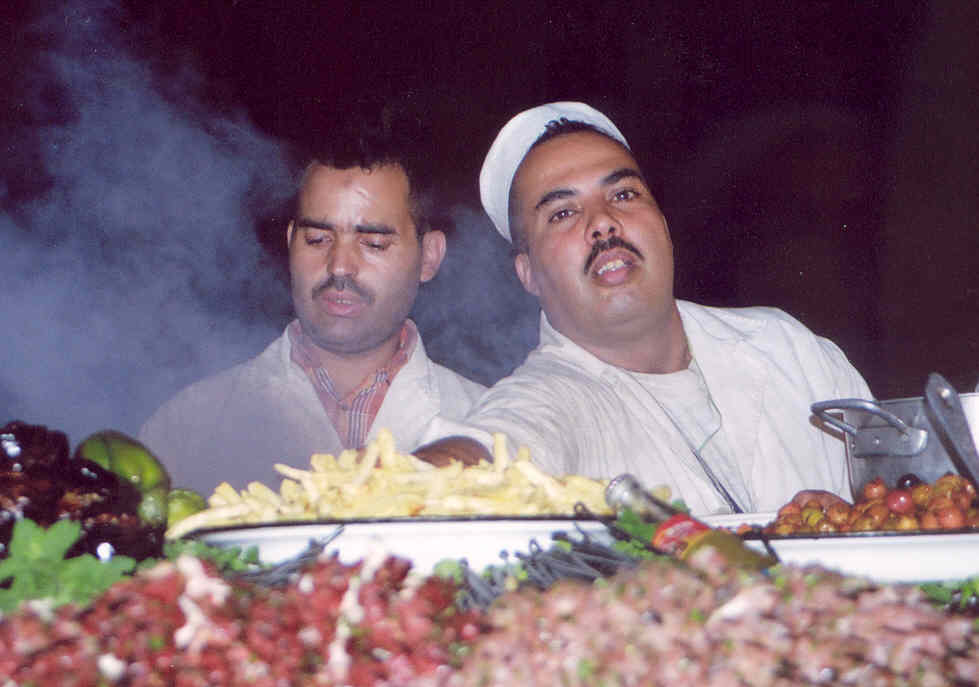
Getting around
From the airport, most people jump in a taxi or arranging to be met by your hotel. If you opt for the former, check the rates on the board outside arrivals as a general guide and then agree a price with the driver through the front window. Only get in when you are happy with how much he’s charging. If you haven’t much luggage, bus #19 travels between the airport and the Djemaa el Fna and loops back through the Ville Nouvelle (including a stop at the train station). It costs 50 dirhams and if you return within two weeks, the journey back to the airport is free.
For the purpose of sightseeing, the city can be split into two: the old city or Medina and the Ville Nouvelle, also called Guéliz or the French Quarter. Pretty much the only way to get around the Medina’s souks is on foot, where you’ll need to watch out for men racing donkeys laden with hides, straw and other goods through the narrow passageways. Within the rest of the old town, mostly it’s compact enough to walk. To get to the Ville Nouvelle, the easiest way is to flag down a taxi, but there are buses which depart from the Djemaa el Fna and the Koutoubia minaret – easy to spot. Another useful bus route to know is the #12 which you can use to get to the Jardin Majorelle (Ben Tbib stop). Tickets cost 4 dirhams. Check out Alsa’s website for more information.

Calèche rides (horse-drawn carriages) are a common sight in the city but you’ll need to bargain with the drivers to take a tour. Check that the horse looks fit and healthy and then begin negotiations. Make sure you’re clear on whether that price is for everyone or per person as it’s common for there to be some “confusion” when it comes to the time to pay. It’s a lovely way to see the city, particularly the ramparts and Ville Nouvelle.

Where to stay
The first time I visited Marrakesh, I stayed at the railway station hotel, now an Ibis. It was convenient, but lacked soul. The second time, I decided I wanted to stay in one of the courtyard mansions known as riads and opted for one deep in the souk. It had character in spades, but trying to find it without a ball of string in the labyrinthine alleyways was a nightmare. More than once I had to call the hotel for them to talk me in which was funny at first and then enormously embarrassing. I had more success during 2022’s visit, where I used Google maps and then paid a local 20 dirhams to guide me for the last labyrinthine stretch to the riad’s door. Riad Le J was good value for money at around £70 per night for a double room with the most fabulous painted wooden ceiling.
Perhaps this is the ideal compromise: I found a characterful riad which was a twenty minute stroll from the Djemaa el Fna yet on an easy to find road near the El Badi Palace and Saadian tombs. Riad Dar Karma was delightful, cosy, chic and quiet – a cocoon from the hustle and bustle of central Marrakesh. It also has its own hamman. When I got sick (do not eat salad in Marrakesh no matter how well travelled you are), they brought me chicken soup. I’d have stayed there during my 2022 trip had they had availability.
What to see
The souks
Plunge in and explore the souks right away. Getting lost in the smells, sounds and sights of narrow winding alleys lined with tiny shops piled high with anything from spices to scarves is the quintessential Marrakesh experience. Don’t try to follow a map. You’ll get lost regardless, so embrace this lack of control and immerse yourself. When you’re ready to leave, if you’ve lost your bearings, as is likely, just ask someone to point you in the right direction – or the nearest bab (gate). Try not to miss the dyers’ souk with vibrant skeins of wool hanging from the walls and of course the tanneries on Rue de Bab Debbagh, which you’ll smell long before you see.
Haggling is a must if you wish to purchase anything. It’s best to make a return visit to the souk when you’re ready to buy; shopping later in the trip, you’ll have a better idea of what things should cost and know what your target should be. The general principles are that if you make an offer, it’s the honourable thing to pay up if it is accepted, and a final price of 30-40% is usually good going. Remember, the vendor will need those extra few dirhams more than you so don’t haggle too fiercely. Read my tips on how to haggle successfully:
https://juliamhammond.wordpress.com/2015/08/09/five-steps-to-becoming-an-expert-haggler/
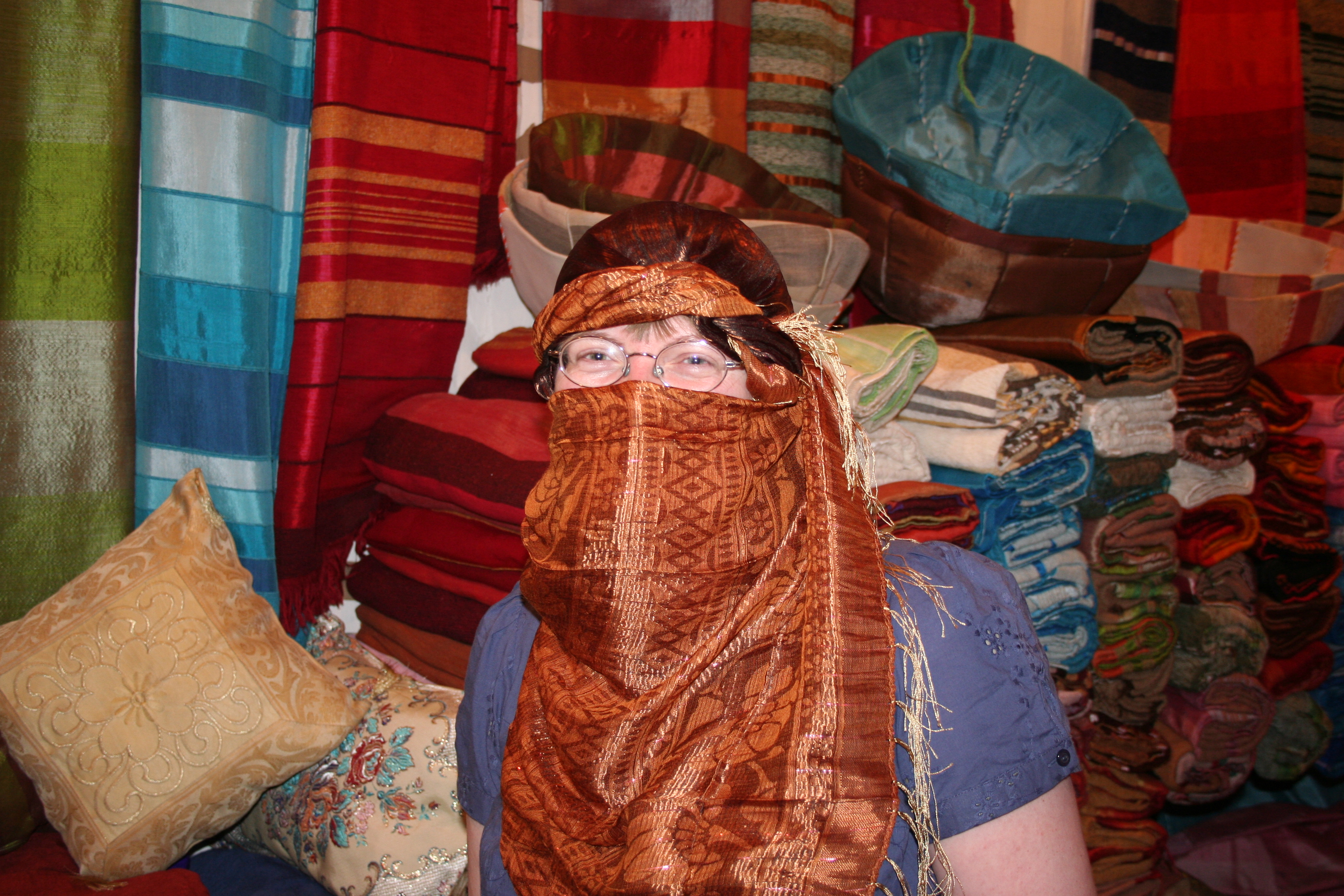
Djemaa el Fna
Though its name loosely translates as the Assembly of the Dead, there is nowhere in Marrakesh that comes alive like its main square, the Djemaa el Fna. It’s busy by day but really comes into its own at night when it transforms into a night market with row upon row of delicious street food. You’ll see water sellers posing for photos, snake charmers, acrobats from the Sahara – even street dentists who’ll pull out a molar there and then for a fee. If it’s your first time out of Europe it’s a veritable assault on the senses but one that you won’t forget. Note though that if you reach for your camera, they’ll expect payment.
Koutoubia Mosque
The minaret of the Koutoubia Mosque looms large behind the Djemaa el Fna and is worthy of closer inspection. So the story goes, when it was constructed, the alignment was wrong and it was knocked down so the builders could start again. What you see dates from the 12th century and got its name from the booksellers who once congregated around its base.

El Badi Palace
This ruined palace is a good one to explore and lies within walking distance of the Djemaa el Fna. Its name means Palace of the Incomparable and there’s certainly nothing like it in the city. It was built in the 16th century by Sultan Ahmed al-Mansur Dhahbi to celebrate a victory over the Portuguese. It’s possible to walk within its walls and courtyard. You’ll frequently see storks nesting there.

Jardin Majorelle
Yves St Laurent gifted this garden to the city of Marrakesh after lovingly restoring it to its original beauty. It was designed and created by the French painter Jacques Majorelle; begun in 1924, it was a labour of love and a lifetime’s passion. The vibrant blues and bold yellows of its walls and pots set off the mature planting to form a breathtaking space that will delight, whether you’re a keen gardener or not. Be prepared though: it’s a busy place with around 700000 visitors a year so you’re unlikely to have it to yourself.

Out of town
Captivating though Marrakesh assuredly is, it’s well worth heading out of town if you can. On the edge of the city you’ll find the Palmeraie, a good place to ride a camel while shaded by around 150000 palm trees. The Menara Gardens are located close to the airport. They were laid out in the 12th century and from them you have a tantalising glimpse of the mountains beyond. A bit further away from Marrakesh and you can visit waterfalls and visit Berber villages and markets. The surf at Essaouira is a two-hour bus ride away and a visit to the Atlas Mountains is another favourite. Your hotel or riad can fix you up with an organised tour or a driver/guide.
I took an excursion to Ouarzazate, stopping off along the way at Ait Ben Haddou, a UNESCO-listed, ruined fortified village which has been the setting for many a film, including The Mummy and Gladiator. At the Atlas Film Studios, just outside Ouarzazate, you can have a lot of fun re-enacting scenes from those movies and more amidst the sets and props which remain.
A final word of advice
Scamming of unsuspecting tourists is a sport in Morocco and although the level of hassle is considerably less than in other cities, it’s wise to be on your guard. A few key pointers:
Never use a taxi or ride in a calèche without agreeing the price first, the same holds for any services you use e.g. henna tattoos, photos of water sellers and so on
Carry small change to avoid prices being rounded up
Make sure you ask to see your guide’s licence as it is illegal to work without one
Nothing is ever free, even if your new friend says it is
And a scam I’ve never experienced, but is reputedly common: you visit a restuarant and are given a menu with temptingly cheap prices. When the bill comes, the prices are higher; if queried, a new menu is presented with the more expensive prices clearly shown. It’s an easy one to prevent: take a photo on your phone of the original menu prices and call their bluff if necessary.
Updated October 2022
A year of travels: looking back on 2017
2018 is almost here and it’s time to look back at the trips made in 2017. I’ve been fortunate once again to have the opportunity to make lasting memories in some of the world’s most captivating destinations. Here’s a round up of my favourite trips from the past year as well as a teaser for what’s to come in 2018.
Puerto Rico

The first trip of the year took me to Puerto Rico, which by autumn would be left reeling from the devastation wrought by Hurricane Maria in September. The beauty of this Caribbean island and how diverse it was blew me away. From the historic cobbled streets of Old San Juan to the dramatic views from its mountains via rainforests, windswept beaches and an enormous telescope, this island fast became one of my favourite in the Caribbean. I love a sandy beach as much as the next person, but it gets boring after a while and it’s good to know there’s a suckling pig roasting for when you’re ready for a feed.

Puerto Rico is slowly getting back on its feet again. There are several posts on this blog which showcase the island’s attractions, but for an insight into recent months, this New York magazine article recounts just how tough it has been:
http://nymag.com/daily/intelligencer/2017/12/hurricane-maria-man-made-disaster.html

Scotland
In February I flew up to Glasgow to visit friends. They recommended a drive over to Falkirk to see the Kelpies. It’s well worth the effort if you’re planning a trip to Scotland in 2018. The sculptures are as magnificent up close as they are imposing from a distance. Despite the inclement weather, I found the story behind the project fascinating and I was lucky to get a guide who was so enthusiastic about his topic.
https://juliamhammond.wordpress.com/2017/02/24/the-kelpies/

Uruguay and Argentina
In March I returned to Uruguay and Argentina after a ten year gap spent largely salivating over thoughts of the $4 fillet steak I’d eaten in El Calafate – I’m sure we have all had those holiday meals that we remember forever. But sometimes these memories are not to be repeated. I had the most amazing crab dinner in St Lucia years ago but the restaurant has closed down. And what about Argentina? In the intervening years, costs had risen, particularly in Buenos Aires. Salta obliged with a decent steak, but at a price. Fortunately, there, in the form of the haunting face of the Lightning Girl was something to compensate – though it was a chilling insight into the past.
https://juliamhammond.wordpress.com/2017/03/20/saltas-lightning-girl

I enjoyed seeing more of my favourite continent. A challenging but rewarding stay on a working ranch in Uruguay tested my riding ability to the limit, with excursions to the Fiesta de la Patria Gaucha providing a welcome injection of fun. If you’re nervous about trying out a working ranch rather than the more typical dude ranch, don’t be, but read this first:
Bolivia

After visiting so many countries, it might come as a surprise to learn I still have a bucket list and for many years, a trip to the salt flats at Uyuni has been top of the list. Crossing overland from Argentina, I timed my visit for the end of rainy season as I’d heard the sight of a flooded salt lake wouldn’t disappoint. It was phenomenal, and spending the night in a salt hotel was an unusual if slightly uncomfortable experience. See how Uyuni stacked up when compared to the salt flats of northern Argentina here:
https://juliamhammond.wordpress.com/2017/04/03/salt-flat-tours-argentina-vs-bolivia/
Ibiza
When a friend asked could I try out some of his company’s Sunwise UVA clothing, I jumped at the chance and picked Ibiza as my destination. I product tested a floaty, very feminine kaftan which protected me well from the sun but also was versatile enough for me not to look out of place on the beach and at a city cafe. I’m more of a T-shirt and trousers kind of girl but it wasn’t too frou-frou to be wearable. Ibiza was surprising too – much more to it than beach clubs and foam parties.
If you burn easily or are keen to protect your skin from sun damage, then I’d recommend you check out Sunwise UVA’s website. The link’s in my blog post.
https://juliamhammond.wordpress.com/2017/05/10/product-test-sunwise-uva-clothing/
PS I’m not on commission.
Texas
Next up was a return visit to the USA, but one with a difference, as I explored Texas with Traveleyes, a specialist company which focuses on trips for the visually impaired. Putting my travel plans into the hands of a company definitely took me out of my comfort zone. Nevertheless, I made some great friends on the trip and especially enjoyed San Antonio. After a dull art museum (what was it Elton John was supposed to have said? I don’t like going to museums because I can’t buy it…) I skipped off with my VI, a charmer nicknamed Smithie (to my Essex). We wound up at Paris Hatters, one of the city’s oldest stores, and bought him a cowboy hat. Elton John would have approved.

As a sighted guide, the experience was a reminder of just how much we take for granted but also made me realise how much my visually impaired companions could access – from horse riding to a lesson in the Texas Two-Step in preparation for Austin’s honky tonks, nothing was off limits. It was a thought-provoking holiday and I can see why some of the sighted guides go time and time again. Find out more about Traveleyes here:
The Caucasus

Another bucket list trip became a reality as I spent a few glorious summer weeks in the Caucasus. My focus was on Georgia and Armenia with a couple of side trips to disputed territories to add a frisson of excitement. (There’s nothing like a morning spent in police custody to make a trip feel that little bit different! Sorry for the worrying text Mum, won’t do it again.) This part of the world is a delight. My personal highlights were the scenic Svaneti region of Georgia with its charming towers and ever so slightly wild people, and a very emotional visit to the genocide memorial in Yerevan which literally moved me to tears.
Venice
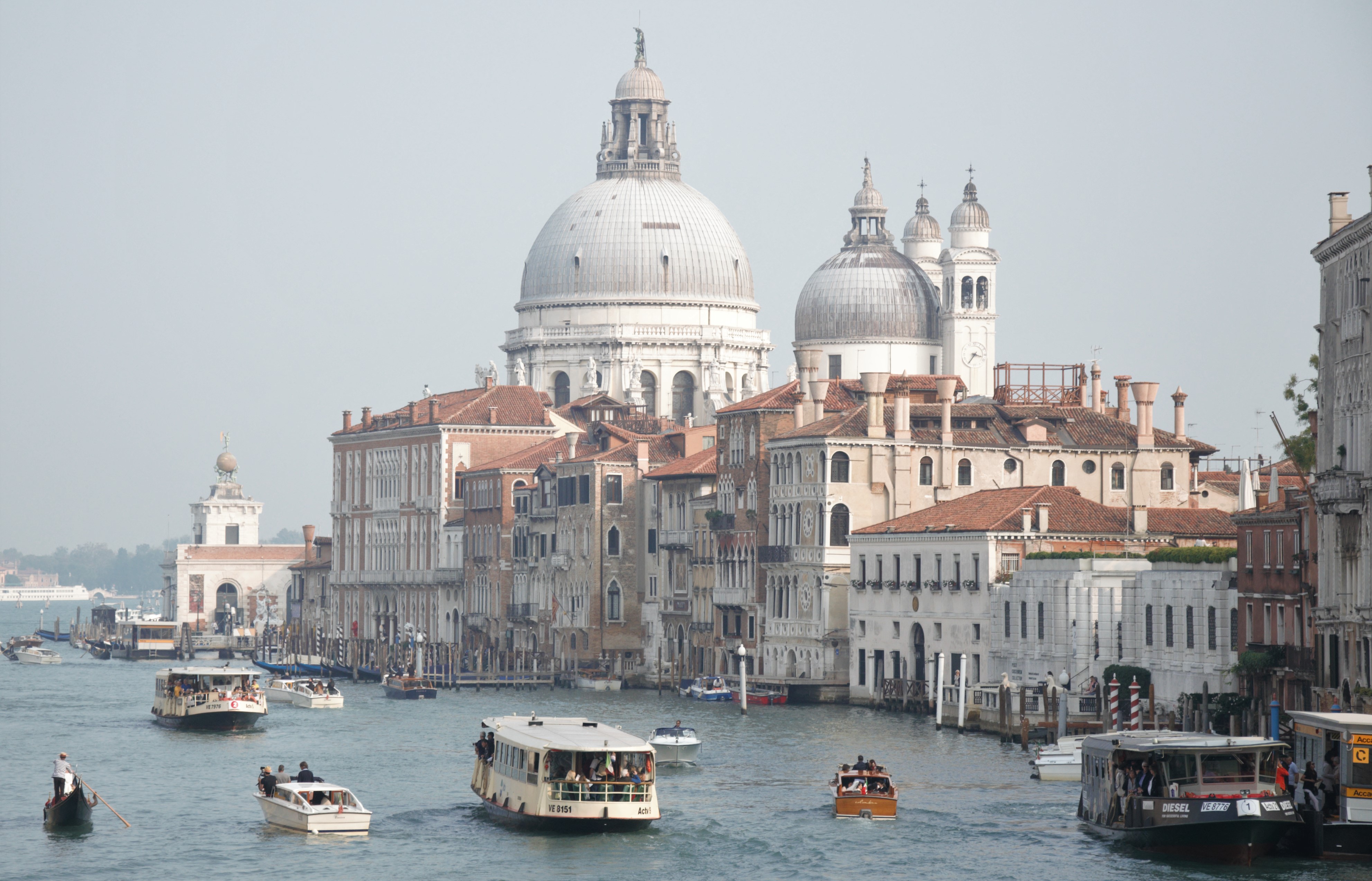
I’ve made many day trips to European cities by air over the last few years, proving you can still satisfy your city break fix even if you’ve run out of holiday. This autumn I picked Venice and spent the day leisurely exploring its canals and back streets enjoying some of the city’s off the beaten track sights. I found a gondola in a book store, a heavenly bar hidden in plain sight near the Rialto Bridge and dresses that started life in a women’s prison. Off season, this is an engaging destination and far better without the crowds of summer.
https://juliamhammond.wordpress.com/2017/10/13/just-back-from-a-day-trip-to-venice/
Cape Verde

November’s a horrible month. Dark evenings signal the start of the long winter season and Christmas lights have yet to migrate from shop to front window. Grumpy Julia was in need of some sun and jetted off to Cape Verde. While Sal could have had more soul, Fogo Island with its brooding volcano didn’t disappoint. My guesthouse set me up with a guide to hike inside the caldera walls, a place known as Chã das Caldeiras. We walked between villages, the path running alongside the raw edges of the 2014-15 lava flow that engulfed the homes of over 1000 people though luckily claimed no lives.
As the guesthouse owner said, “it’s still Africa, but not as you know it”.
https://juliamhammond.wordpress.com/2017/12/19/a-beginners-guide-to-cape-verde/
Salzburg

I couldn’t let the year end without a trip to a Christmas market after enjoying those at Copenhagen and Regensburg so much last year. This year, I chose one of Austria’s most charming cities and flew to Salzburg to get my fix. Snow covered the ground, but that didn’t deter the crowds or the authorities (take note Lincoln!) A Krampus run and a train ride to see Silent Night being performed in the village where it was composed rounded off the trip. If you plan to follow suit in 2018, I’d recommend you take a look at the guide I wrote:
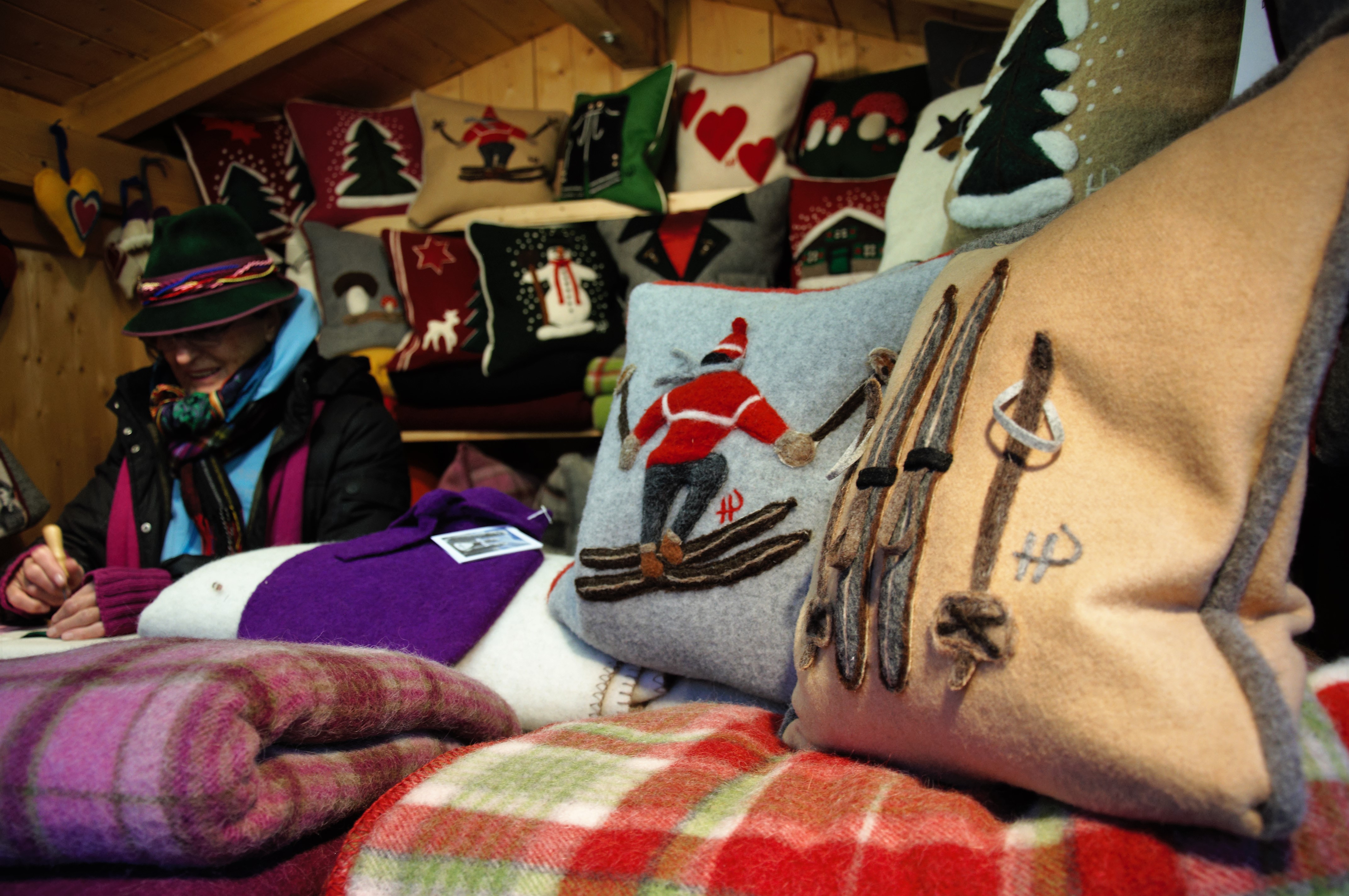
That rounds off my travels in 2017, a bumper year for making memories. I’ve only just started thinking about where I’ll go in 2018, but it all kicks off in Cuba this January, booked after I learned of a £140 error fare deal from Secret Flying. If you haven’t yet signed up for their updates, I’d recommend you get over to their website. I’m also booked to go to New Zealand in May, having taken advantage of Air New Zealand’s fantastic Black Friday deal. I’m currently toying with the idea of crossing the dateline and spending some time in the Cook Islands while I’m out there. Watch this space.
Wherever you’re planning for 2018, I’d love to hear about it. Happy travels!
A beginner’s guide to Cape Verde
As the northern hemisphere winter starts to bite, our thoughts turn to warmer climes. But travelling to the Caribbean can be expensive unless you can snag an error fare and the Med’s still a little too chilly. If you’re looking for winter sun on a post-Christmas budget, why not consider Cape Verde? Known locally as Cabo Verde, it’s a ten island archipelago, nine of them inhabited. With a long history and dramatic volcanic landscapes to complement its many glorious beaches, there’s an island to suit everyone.
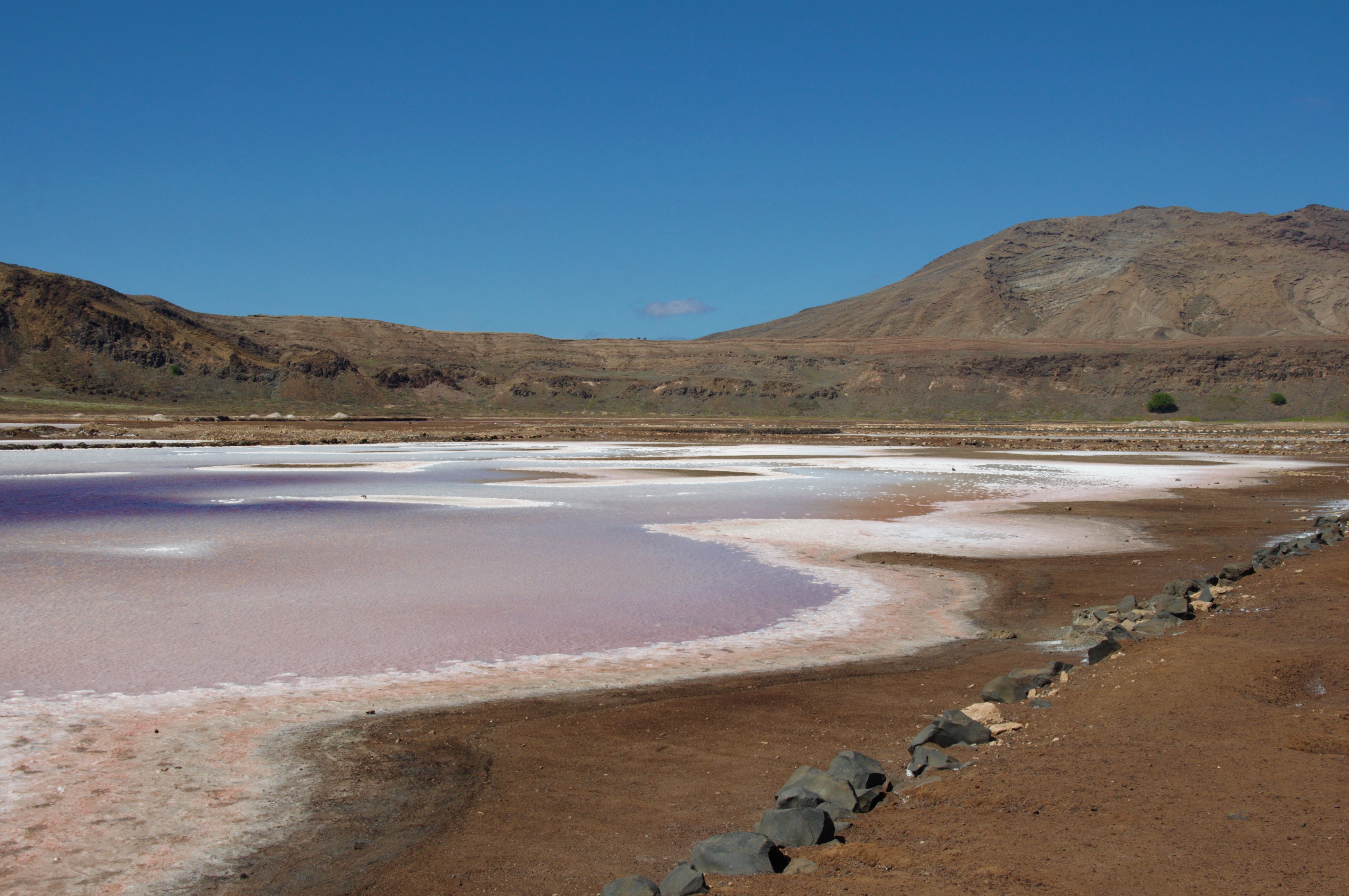
The salt pans which gave Sal its name
Getting there
Most Brits jet off to Sal, a largely barren island blessed with a bumper crop of beaches and enough resorts to leave you spoilt for choice. The two main operators that win on price are Thomas Cook Airlines and Tui, both of which offer direct flights from the UK. Depending on which extras you consider essential, you can pick up a flight for between £200 and £400. I recently blogged about my experience with Thomas Cook Airlines. Find my review here:
https://juliamhammond.wordpress.com/2017/11/25/review-of-thomas-cook-airlines/

Thomas Cook plane at Sal airport
No scheduled carriers offering direct flights serve the UK, but you can fly with TAP via the Portuguese capital. If you’ve never been to Lisbon, it’s possible to add a stopover to your holiday. Find out what you can do in and around Lisbon here:
https://juliamhammond.wordpress.com/2014/10/20/just-back-from-a-day-trip-to-lisbon/

Lisbon’s Alfama district seen from the Mirador at Portas do Sol
Getting around
There’s recently been an increase in domestic flights between many of the islands, with Binter extending their reach from their Canary Islands base and Icelandair taking over the national airline TACV which could see it become more reliable. These changes have opened up island hopping for those constrained by relatively short holidays, providing a real alternative to the inter-island ferries that are available. I had a week on Cape Verde, splitting my time between the islands of Sal, Santiago and Fogo. Ideally you want to spend at least a few days on each. If I’d have been there for a second week, I’d have flown to São Vicente, home to the island’s cultural hub Mindelo and hopped over to Santo Antão for some hiking.

Binter, one of the inter-island airlines
What to see
Sal
Sal’s a package tourist hub, but with a little effort, you can venture beyond the horizons of the all-inclusives. I based myself in Santa Maria, the main resort. As time was limited – I’d really only added a night here to make sure I didn’t miss my flight – I booked an island tour through my bed and breakfast, the centrally located but basic Pensão Les Alizés. Costing just 25 euros for the day’s excursion plus a couple of entrance fees, it was a good way of covering some of the main sights on Sal without resorting to expensive taxis. You’ll notice the currency stated is euros; on Sal, most places will take euros alongside the local Cape Verdean escudos. It’s also worth visiting Project Bioversity’s turtle project, located on the beach behind the Riu Palace Hotel. Read about it here:
https://juliamhammond.wordpress.com/2017/12/04/an-interesting-turtle-project-on-sal-cape-verde/

Fisherman on Sal Island

Murdeira, looking over towards Monte Leão
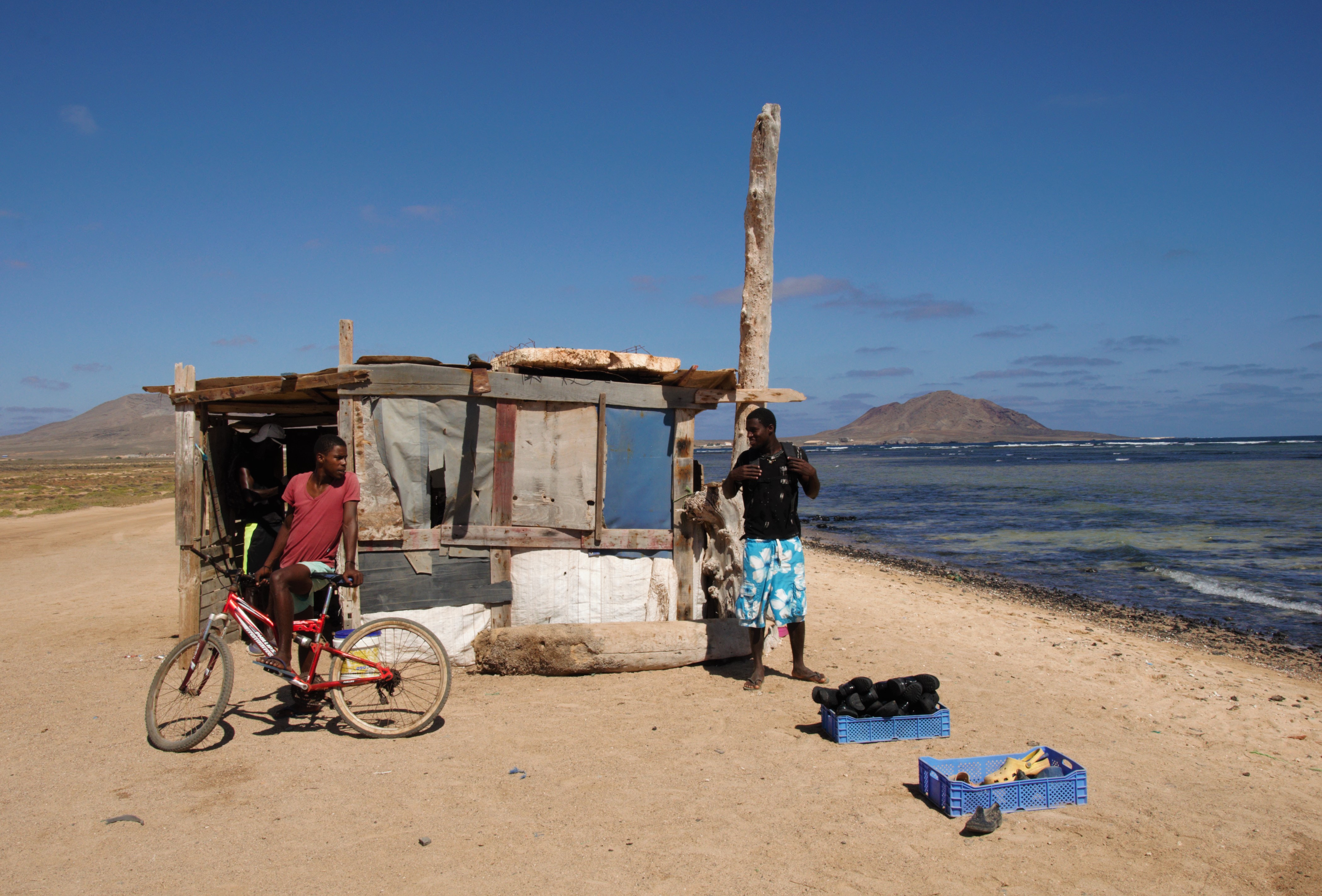
Shoe rental, Shark Bay
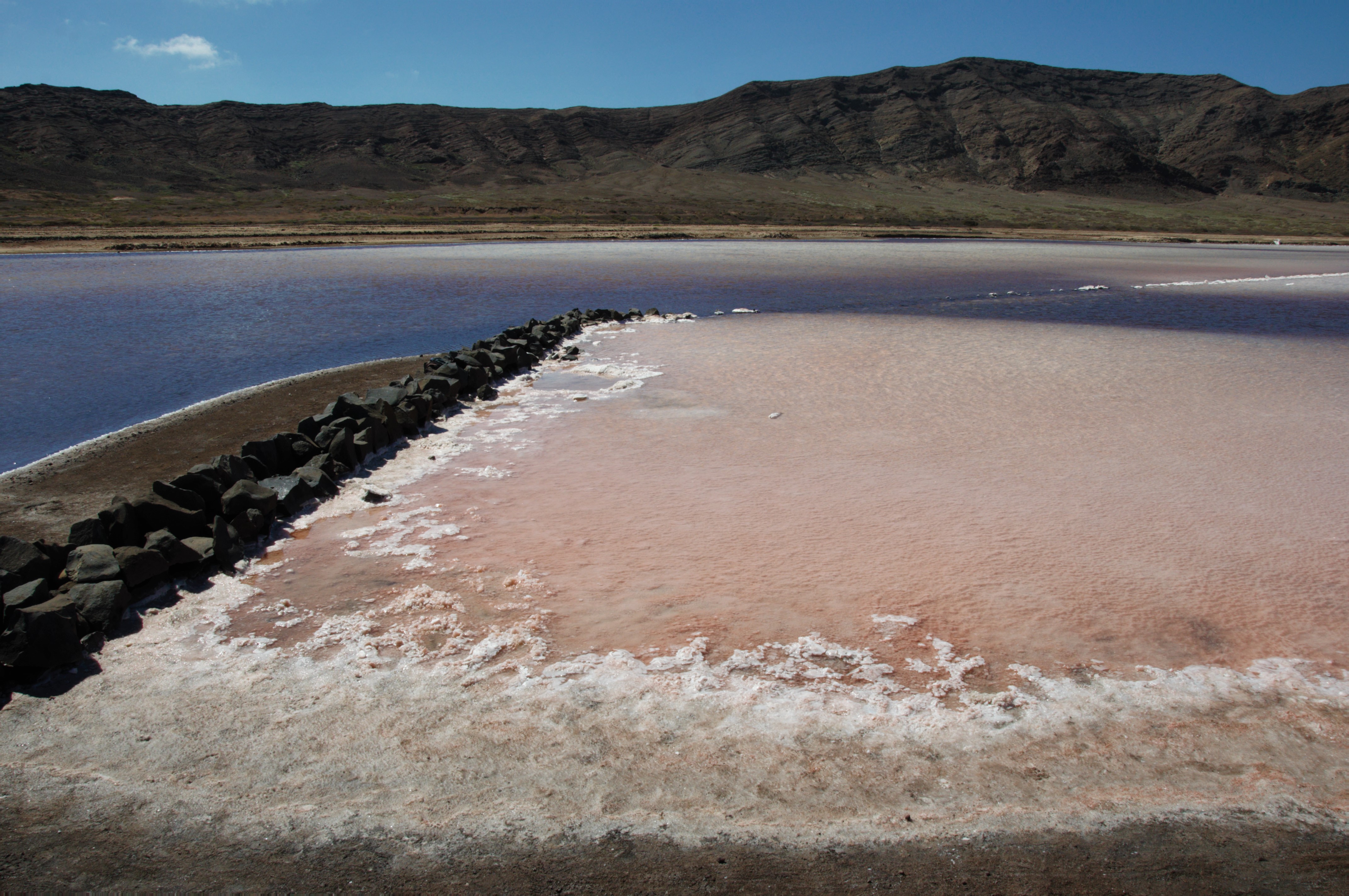
Salt pans at Pedra de Lume

Mirage, not water

The Blue Eye

Buracona lava pools

Local fisherman, Palmeira
Fogo
Fogo’s about as far removed from Sal as you can get. This tiny island is dominated by an active volcano which looms menacingly against the skyline as you approach. The island’s main town is São Filipe, whose colourful colonial sobrado mansions straggle down the rocky coastline towards the shore. The pace of life is slow, and tourists are relatively few in number. I’d recommend a stay at the Colonial Guest House, a restored 19th century sobrado house with a pool and restaurant within walking distance of the Bila Baxo’s historic attractions. It’s possible to climb the volcano, whose last eruption ended in February 2015, though I settled for an easier guided walk inside the walls of the caldera, along the Chã das Caldeiras. Book well ahead through your guest house to secure an English-speaking guide, as they are few and far between.

Bila Baxo

Sobrado mansion awaiting renovations

Bringing in the firewood, São Filipe

Parque Natural do Fogo

Homes and businesses buried in the 2014-15 lave flows, Portela
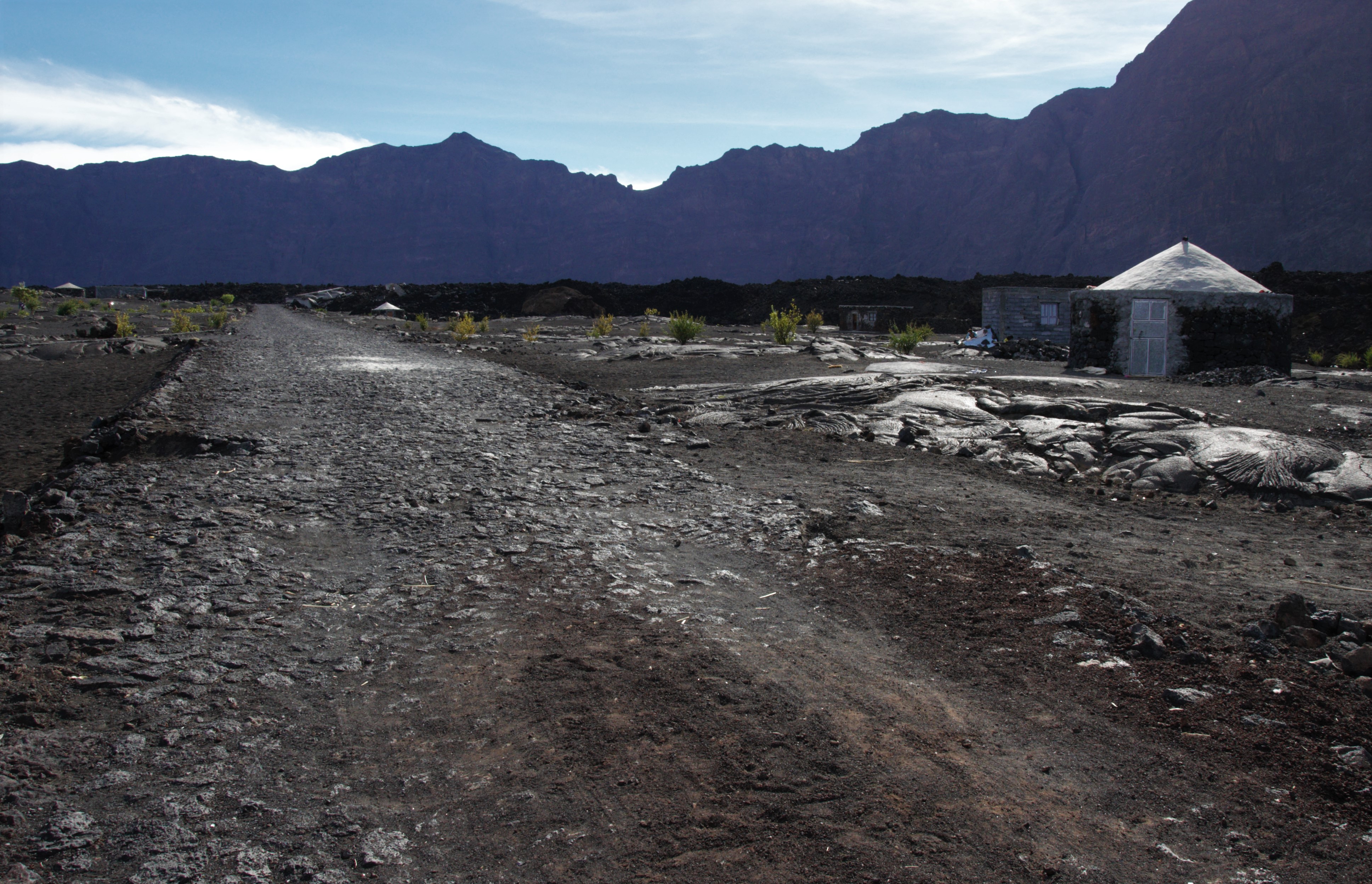
Road to nowhere, Chã das Caldeiras
Santiago
Home to the nation’s capital Praia, Santiago is an interesting destination for visitors. I based myself in Praia and, like most of its residents, headed out to nearby Cidade Velha on a warm November Sunday. Once known as Ribeira Grande, it was the country’s capital and focus for 15th century settlers. There’s a pillory post, left as a reminder to the island’s slave trading history, and a short stroll away you’ll encounter the oldest colonial church in the Tropics, Nossa Senhora do Rosário church. It’s also worth venturing into the island’s mountainous interior as the scenery is spectacular. The local minibuses, known as alaguers, are cheap. Try to get a front seat spot for the best views.

Rua de Banana, Cidade Velha
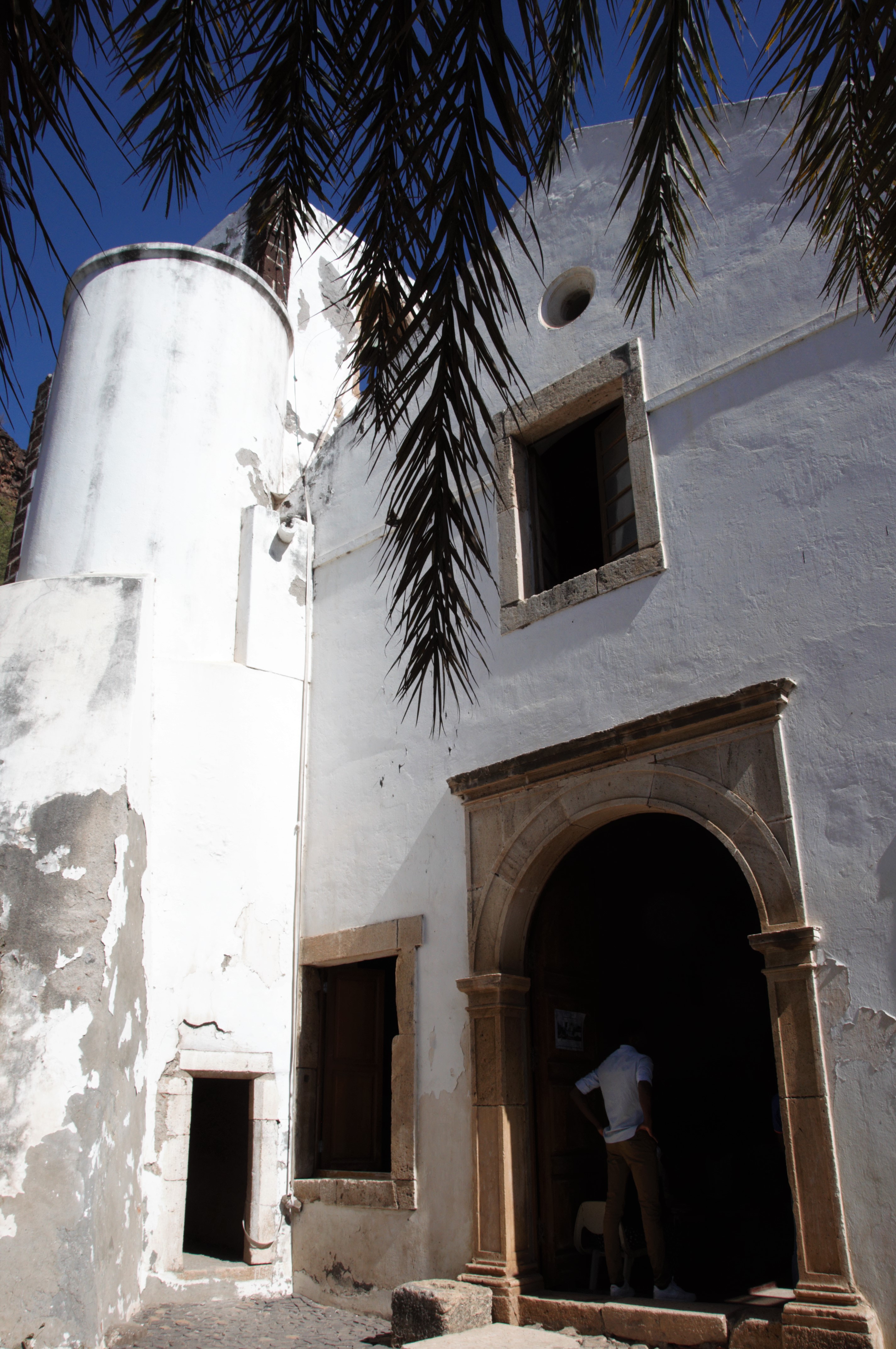
Nossa Senhora do Rosário church

Pillory post, Cidade Velha

Football on the beach

Sunrise over Praia

The road to Assomada
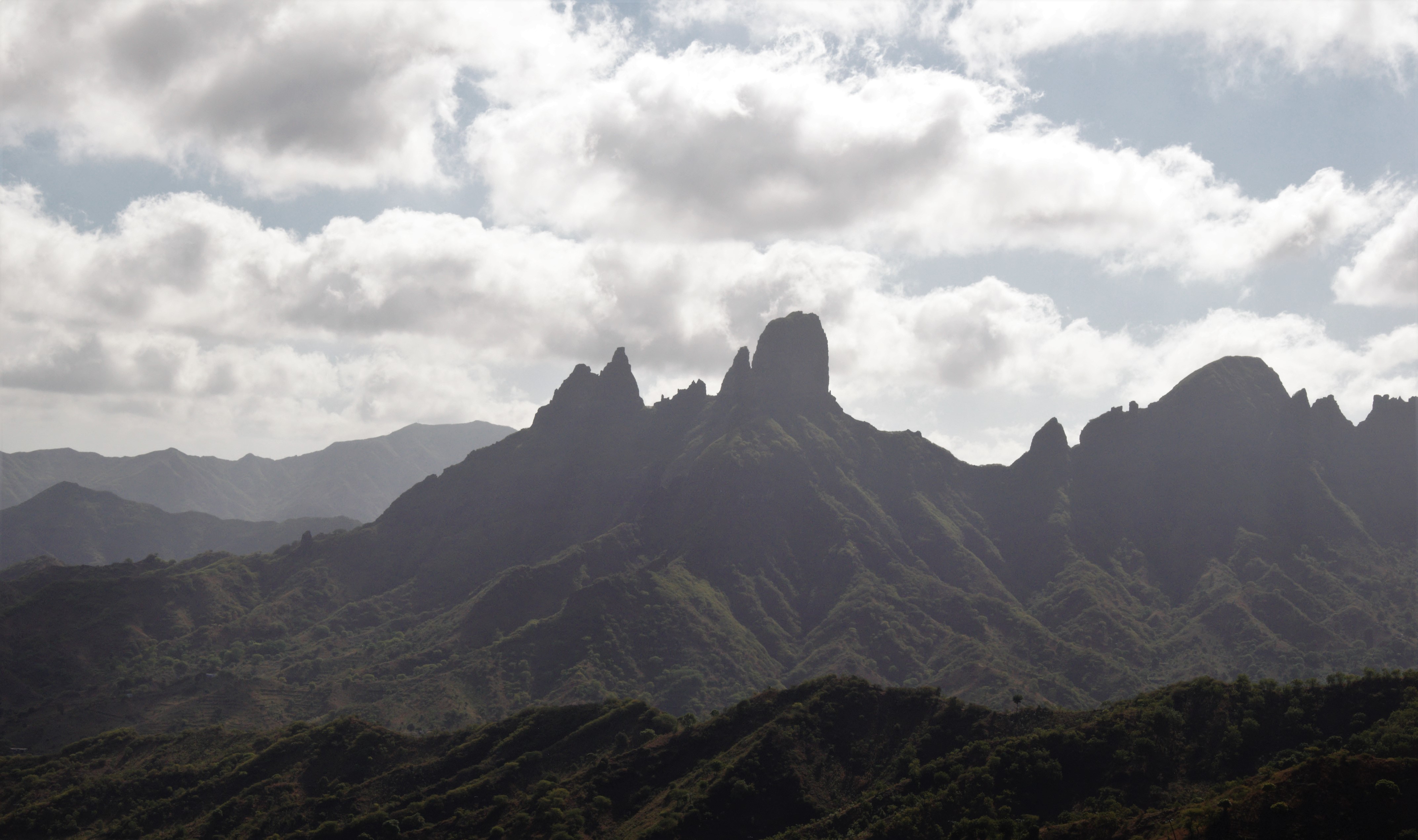
Dramatic peaks of Santiago’s mountainous interior
Tips for travellers
The diverse landscapes and captivating history make Cape Verde a rewarding destination. The variety of activities on offer make island-hopping a very attractive proposition, and with online booking, simple to arrange without the need for a package. That said, it is Africa, and travellers need to be prepared for things to occasionally run less smoothly than they’d like.
Transport can be a bit hit and miss, but the friendly Cape Verdeans will help if you find yourself stranded. Alaguers, or minibuses, run on set routes but if you flag down an empty one you’ll be asked if you want it “colectivo” or not – it’s cheaper to share but you’ll spend time waiting for passengers if they’re not full.
Weatherwise, it’s significantly warmer than the more northerly Canary Islands. During my mid-November trip, temperatures were pushing 30ºC. However, be prepared for the wind to pick up – if you’re looking for a fly and flop holiday, make sure your accommodation has a decent pool as you’ll often find the sea’s off limits due to dangerously strong tides.
Get to know Royal London
If you’re a lover of all things Royal, then you’ll be looking forward to next May’s Royal wedding which is set to take place at Windsor. London, a stone’s throw away, is of course a Royal favourite, but where should you visit to follow in the footsteps of the Royal family? From the obvious locations like Buckingham Palace to places with a less well-known connection to the UK’s best loved family, these excursions will tick all the boxes.

Fortnum and Mason
Along Piccadilly, you’ll see the distinctive eau de nil façade of the Queen’s grocer, Fortnum and Mason. The Queen, despite her advancing years, is a frequent entertainer, hosting heads of state and other dignitaries for lavish banquets. Her annual food bill was recently estimated at around £1.4 million. Fortnum and Mason receive a chunk of that money but there are plenty of affordable goods to be had for regular customers too. Don’t miss the food hall and pick up a picnic fit for Royalty. Time your visit to watch the clock outside chime the hour; Mr Fortnum bows to Mr Mason.
Buckingham Palace
Near to Piccadilly is Green Park, the smallest of the capital’s eight Royal Parks at just 40 acres. Its tree-lined paths and grassy meadows make for a beautiful picnic spot. Aim to reach Buckingham Palace by late morning to coincide with the Changing of the Guard ceremony; you can check the exact time at www.changing-guard.com. For the best view, try to get as close to the Palace gates as possible. If you’re visiting in August and September, then it is possible to take a guided tour inside the palace itself and that’s well worth the entry fee.
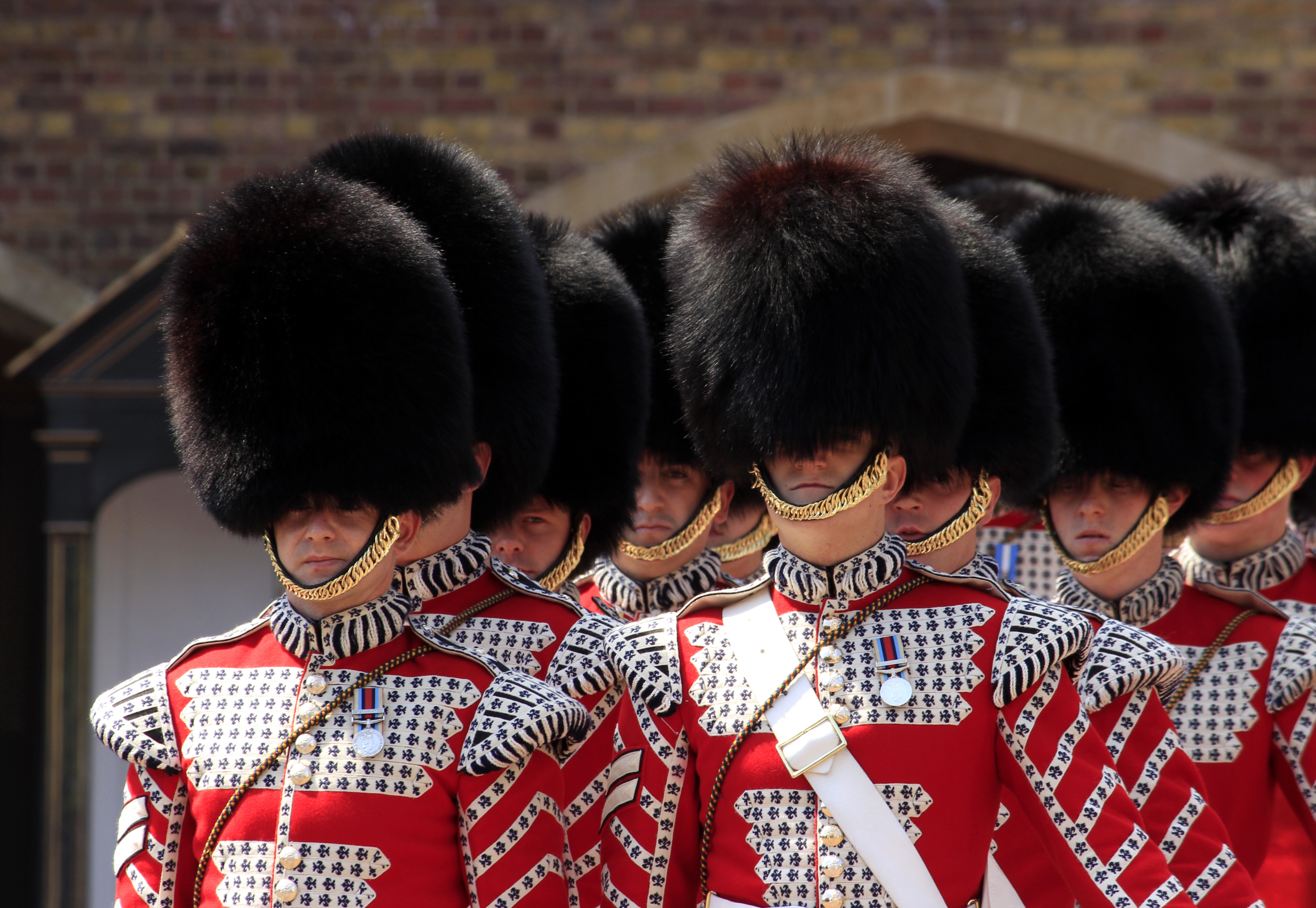
Queen’s Gallery
At Buckingham Palace, tours of the Queen’s Gallery operate year-round. Located in what was originally one of John Nash’s conservatories, the structure was destroyed during World War Two. It was rebuilt at the suggestion of the Queen and the Duke of Edinburgh to house the Royal Collection in 1962. Exhibits change, but it’s likely you’ll see works of art by an eclectic range of artists including names such as Rembrandt, Hockney, Rubens and da Vinci.
The Royal Mews
The Royal Mews is where you’ll find the Queen’s carriages and it’s found around the corner from the Queen’s Gallery on Buckingham Palace Road. Guided tours operate between April and October and are included in the price of your admission. Wardens dressed in a smart navy and red livery will show you the highlights of the collection of vehicles, including the Diamond Jubilee State Coach which is the newest addition to the fleet. Equally dazzling is the Gold State Coach which dates from the time of George III. It weighs nearly four tonnes and requires eight horses to pull it. It’s the coach that has been used to take each monarch to their coronation since the early 19th century. Animal lovers will also be pleased to learn that you’ll get to meet the horses during the tour.
The Goring Hotel
This exclusive hotel is tucked away a short walk from the Palace in Beeston Place. It describes itself as “London’s last remaining family-owned luxury hotel – a grand hotel with impeccable manners.” It’s the hotel in which Kate Middleton’s family stayed on the eve of her wedding to Prince William and this five-star establishment is sure to impress. If you have the budget, you can stay here too; room rates begin at a little over £300 per night.

Kensington Palace
Access to Kensington Palace, former home of Diana, Princess of Wales, its gardens and exhibitions is by ticket only. Inside, you’ll be able to visit the King and Queen’s state apartments, little changed since 1690 when they were built for the then monarchs William and Mary. Temporary exhibits also feature; the “Diana: her fashion story” collection scheduled to open early in 2017 is sure to be immensely popular.
Diana Memorial Garden
Following the edge of Hyde Park, another of London’s Royal Parks, you’ll come to the Diana Memorial Garden. Its highlights include a playground, a nod to Diana’s great love of children, featuring as its centrepiece a huge pirate ship. Also, it’s here you’ll find a memorial fountain built from 545 pieces of Cornish granite. Water flows in cascades and swirls until it reaches a calm pool at the bottom, symbolising Diana’s sometimes turbulent life.
The Brown Cow, Fulham and the Cross Keys, Chelsea
My final suggestion is to down a drink at one of Prince Harry’s favourite pubs. The Brown Cow is owned by one of his friends, Mark Dyer, a former officer in the Welsh Guards. Harry was a regular when in town, before his engagement at least. It’s the place he chose to toast the birth of his nephew Prince George. You’ll find it on the Fulham Road. The Cross Keys in trendy Chelsea is another Mark Dyer establishment. Originally Chelsea’s oldest pub, Harry celebrated his 31st birthday here. You’ll find the pub just before you get to the River Thames near Chelsea Embankment. Cheers!































































